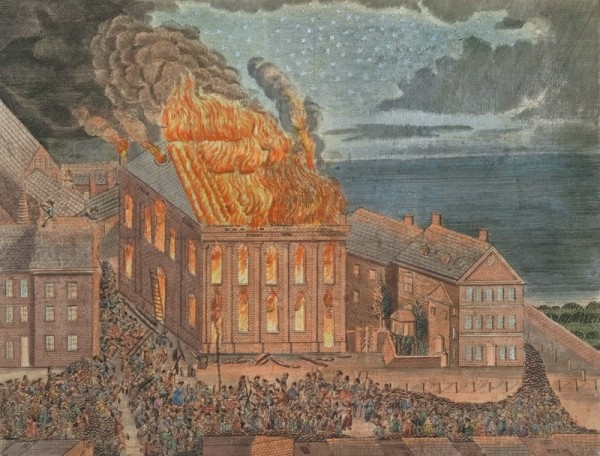
Prospect Of the new Lutheran Church in Philada which was on the 26th of Dec. 1794 in the evening from the hour of eight till twelve Consumed by Fire, engraved by Frederick Reiche, Philadelphia, Pennsylvania, 1795. (Courtesy, Historical Society of Pennsylvania.)
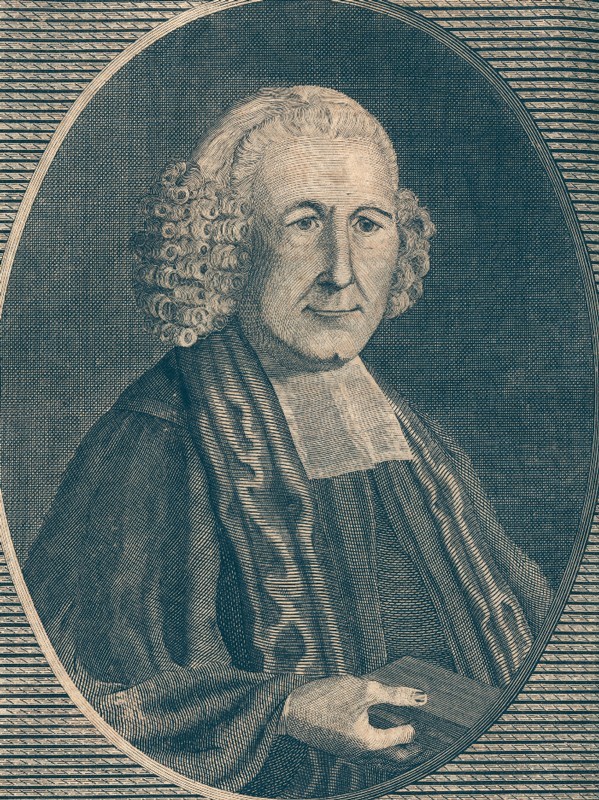
Detail of a portrait of Henry Melchior Muhlenberg, from Justus Heinrich Christian Helmuth, Denkmal der Liebe und Achtung . . . dem Herrn D. Heinrich Melchior Mühlenberg (Philadelphia: Melchior Steiner, 1788). (Courtesy, Lutheran Archives Center, Philadelphia.)
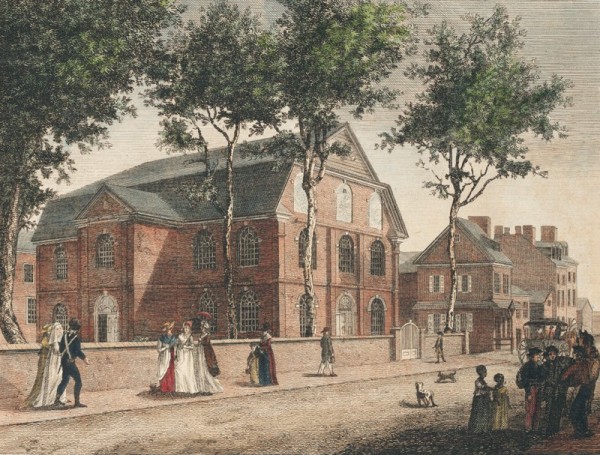
Old Lutheran Church, in Fifth Street, Philadelphia, drawn and engraved by William Russell Birch and Thomas Birch, Philadelphia, Pennsylvania, 1800, and published in Birch’s Views of Philadelphia (Philadelphia: W. Birch, 1800). (Courtesy, Winterthur Library, Printed Book and Periodical Collection; photo, James Schneck.)
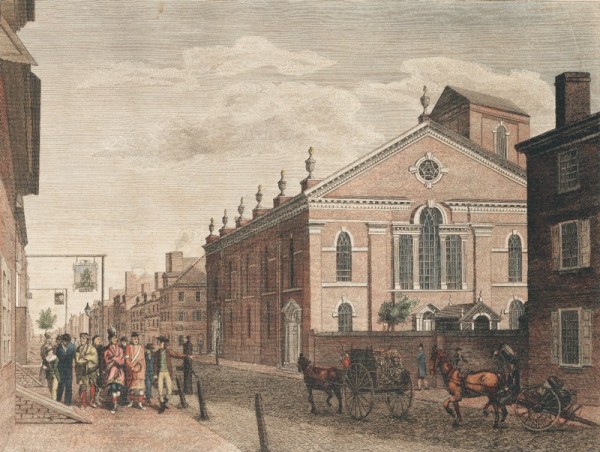
New Lutheran Church, in Fourth Street Philadelphia, drawn and engraved by William Russell Birch and Thomas Birch, Philadelphia, Pennsylvania, 1799, and published in Birch’s Views of Philadelphia (Philadelphia: W. Birch, 1800). (Courtesy, Winterthur Library, Printed Book and Periodical Collection; photo, James Schneck.) When Philadelphia was the federal capital during the 1790s, delegations of Indians visited the city to settle affairs with the government. This engraving is said to depict Frederick Muhlenberg conducting a tour for one of these groups.
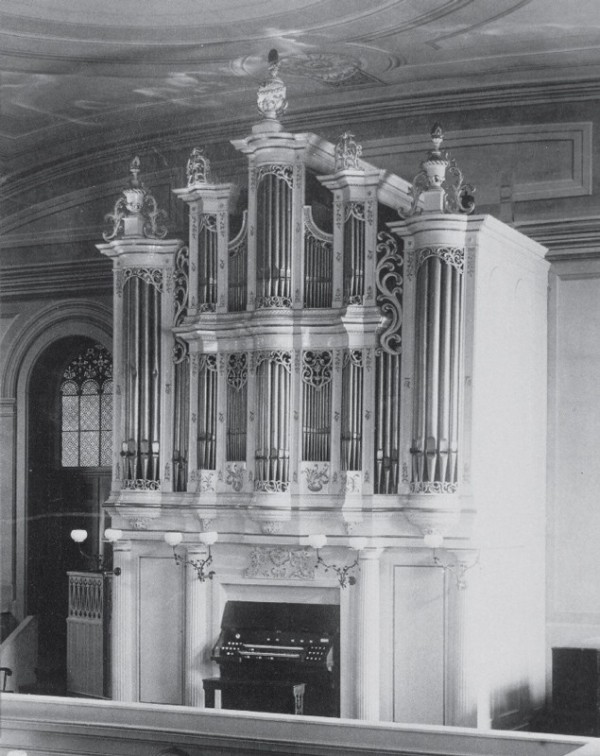
Peter Frick, organ case, Lancaster, Pennsylvania, 1771–1774. (Courtesy, Holy Trinity Lutheran Church, Lancaster, Pa.; photo, ca. 1880.)
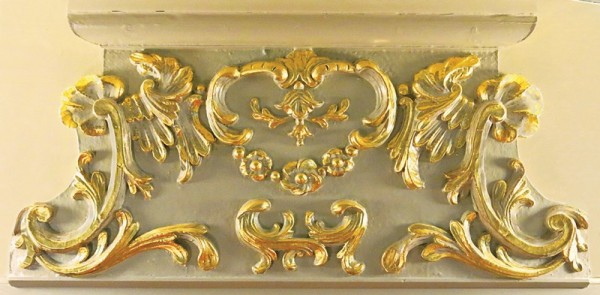
Detail of the carved plaque at the base of the central tower on the organ illustrated in fig. 5. (Courtesy, Holy Trinity Lutheran Church, Lancaster, Pa.; photo, Lloyd Bull.)

Photograph of Zion Lutheran Church interior, Philadelphia, Pennsylvania, 1866. (Private collection; photo, Winterthur Museum.)
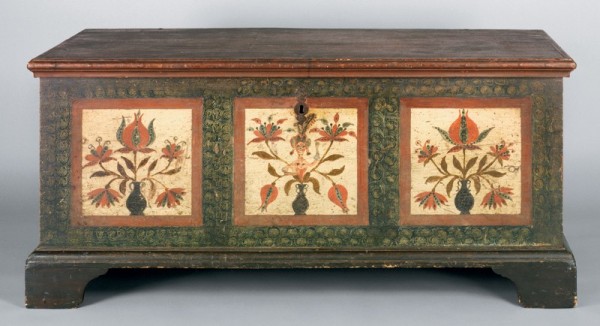
Christian Selzer, chest, Jonestown, Lebanon County, Pennsylvania, ca. 1796. White pine with tulip poplar. H. 23 1/2", W. 52 1/4", D. 22 5/8". (Courtesy, Winterthur Museum; photo, Laszlo Bodo.)
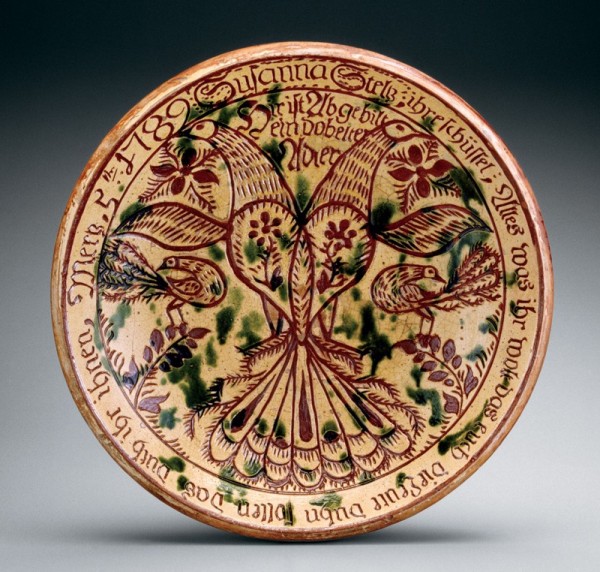
Dish attributed to George Hubener, Montgomery County, Pennsylvania, 1789. Lead-glazed red earthenware. Diam. 13". (Courtesy, Winterthur Museum; photo, Gavin Ashworth.)

Birth and baptismal certificate for Anna Sara Huett, Berks County, Pennsylvania, ca. 1782. Watercolor and ink on laid paper. 16" x 12 1/2". (Courtesy, Steve and Susan Babinsky; photo, Gavin Ashworth.)
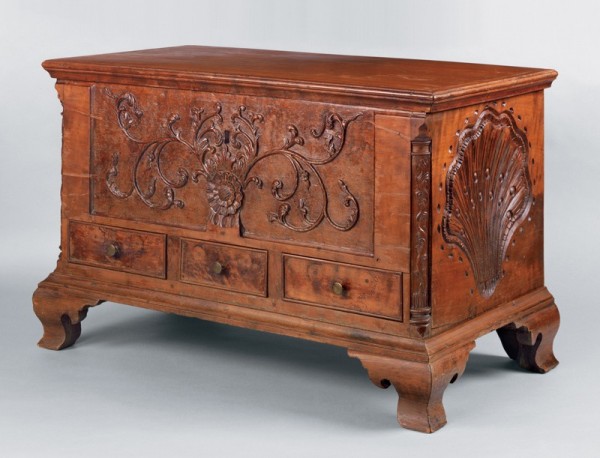
Chest-over-drawers, Manheim area, Lancaster County, Pennsylvania, ca. 1780. Cherry with walnut and yellow pine. H. 19", W. 29 1/4", D. 15 3/*4". (Private collection; photo, Winterthur Museum, Laszlo Bodo.) The brasses are replaced.
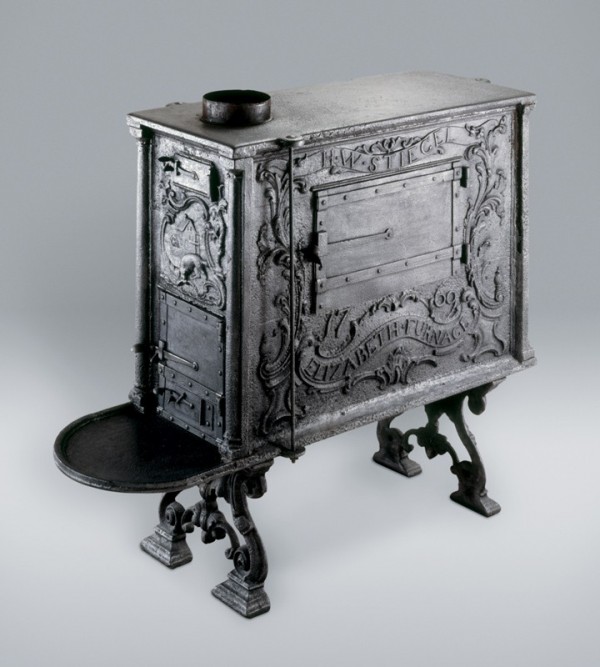
Ten-plate stove, Elizabeth Furnace, Elizabeth Township, Lancaster County, Pennsylvania, 1769. Iron. H. 63 1/4", W. 15", D. 44 1/4". (Courtesy, Hershey Museum; photo, Metropolitan Museum of Art, David Allison.) The front plate depicts Aesop’s fable of the dog and its reflection.

George Heap, The East Prospect of the City of Philadelphia in the Province of Pennsylvania (London Magazine, 1761). (Courtesy, American Philosophical Society.)
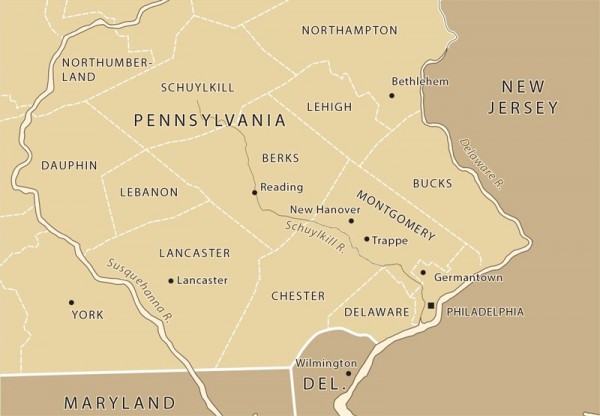
Map of southeastern Pennsylvania. (Artwork, Wynne Patterson and Tom Willcockson.)
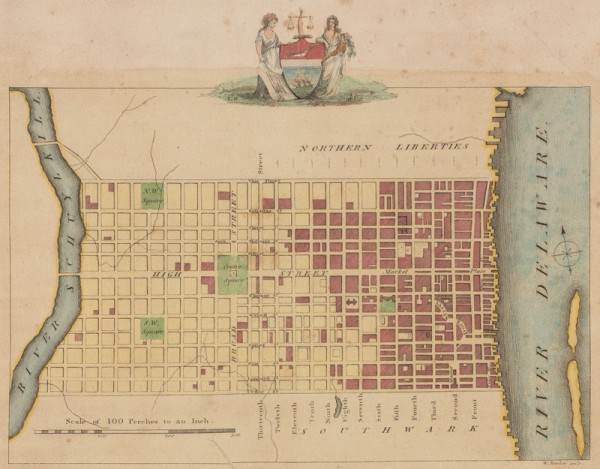
Plan of the City of Philadelphia, drawn and engraved by William Russell Birch and Thomas Birch, Philadelphia, Pennsylvania, 1800, and published in Birch’s Views of Philadelphia (Philadelphia: W. Birch, 1800) (Courtesy, Winterthur Library, Printed Book and Periodical Collection; photo, James Schneck.)
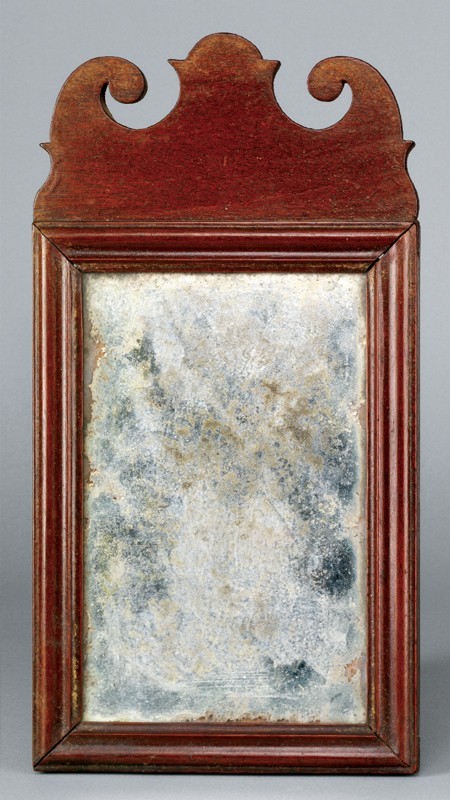
Looking glass labeled by John Elliott Sr., Philadelphia, Pennsylvania, 1762–1767. Walnut with white cedar. H. 13 1/4", W. 7", D. 3/4". (Private collection; photo, Winterthur Museum, Laszlo Bodo.)
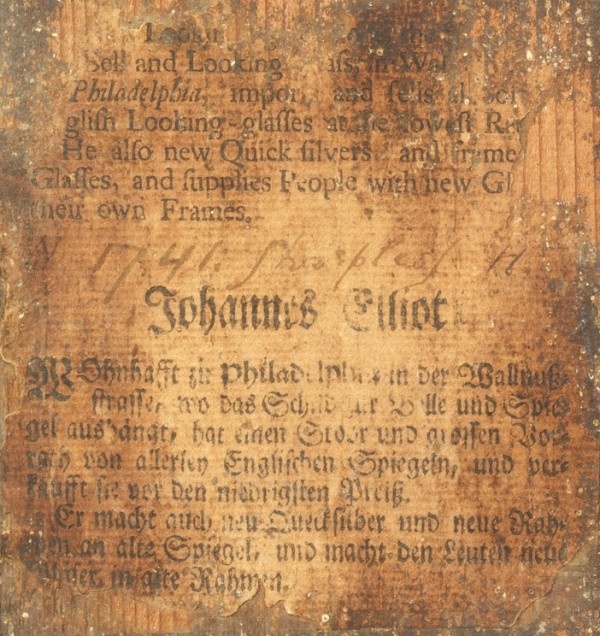
Detail of the label on the reverse of the looking glass illustrated in fig. 16.
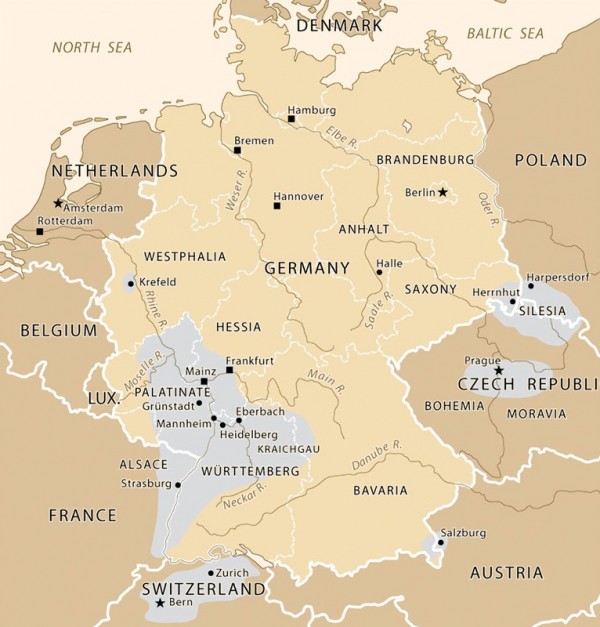
Map of European origins of German-speaking immigrants to Pennsylvania (in blue). (Courtesy, Winterthur Museum; artwork, Tom Willcockson, Mapcraft.com.)
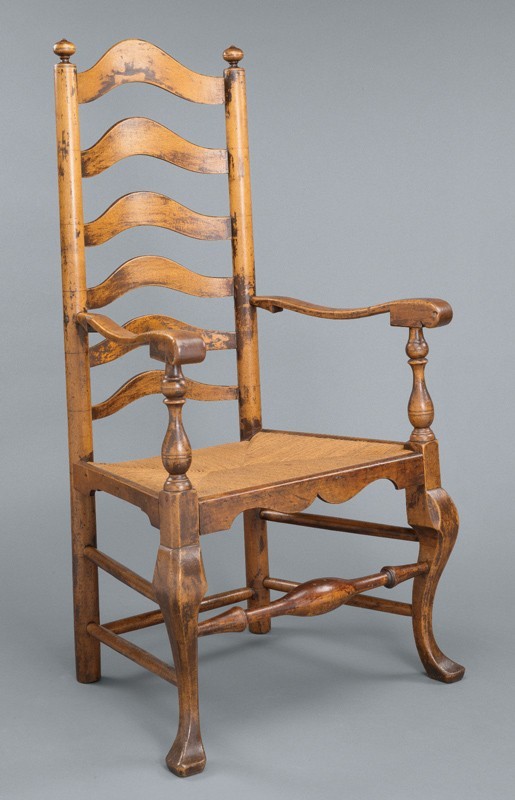
Armchair attributed to the shop of Solomon Fussell, Philadelphia, Pennsylvania, ca. 1740. Maple. H. 45", W. 25 1/2", D. 21 1/4". (Courtesy, Winterthur Museum; photo, James Schneck.)
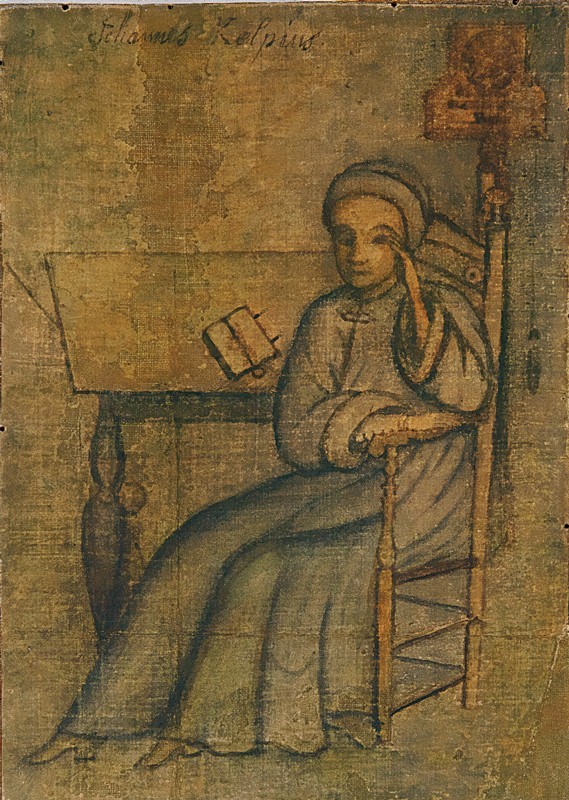
Christopher Witt, Johannes Kelpius, Germantown, Pennsylvania, ca. 1705. Watercolor and ink on laid paper. 9 1/8" x 6 3/8". (Courtesy, Historical Society of Pennsylvania.)
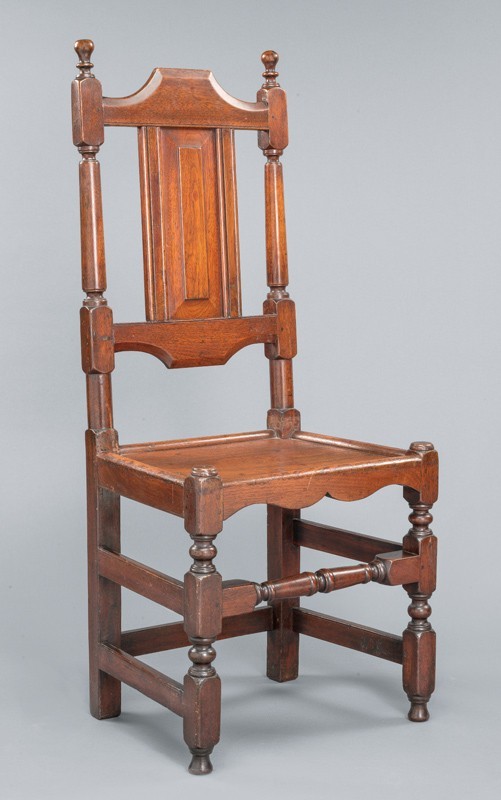
Side chair, probably Germantown, Pennsylvania, 1730–1740. Walnut. H. 43 3/4", W. 18 1/2", D. 15 1/2". (Courtesy, Winterthur Museum; photo, James Schneck.)
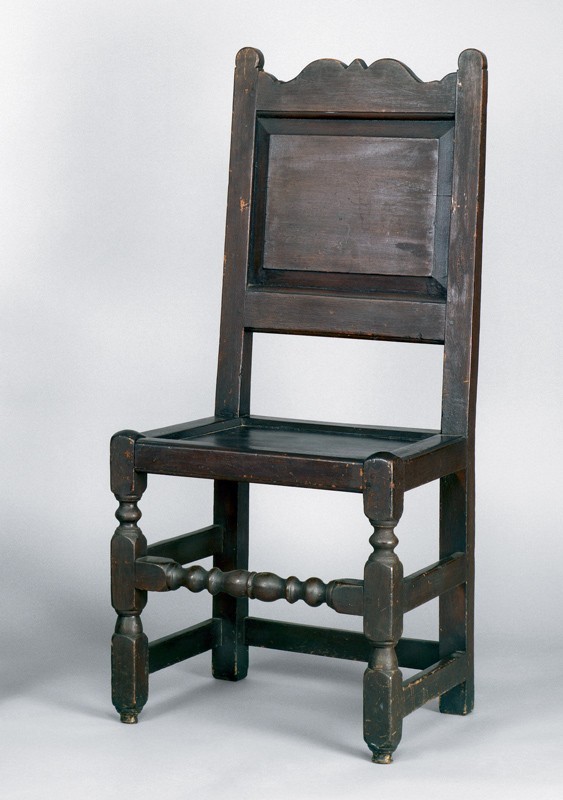
Side chair, probably West Marlborough Township area, Chester County, Pennsylvania, 1730–1750. Walnut. H. 40 1/2", W. 17 3/4", D. 16 1/2". (Courtesy, Primitive Hall Foundation; photo, Winterthur Museum, Laszlo Bodo.)
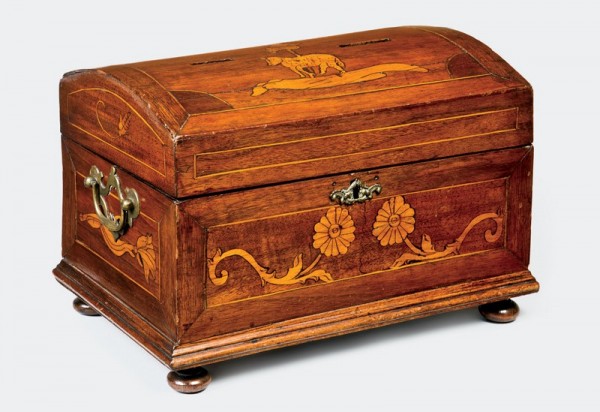
Chest, Philadelphia, Pennsylvania, ca. 1750. Walnut veneer and maple and mahogany inlay with yellow pine. H. 8 1/4", W. 12 1/4", D. 8". (Courtesy, Krauth Memorial Library, Lutheran Theological Seminary at Philadelphia; photo, Gavin Ashworth.) Two slots were inserted at a later date to convert the chest into an alms box or ballot box. The veneer was identified as American black walnut by microanalysis.
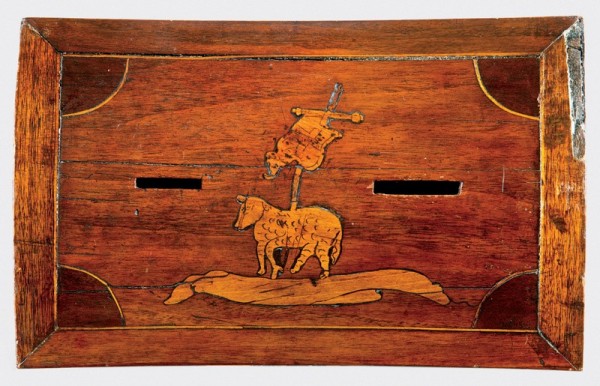
Detail of the lid of the chest illustrated in fig. 23. (Photo, Gavin Ashworth.)

Lewis Miller, drawing of the altar in Christ Lutheran Church, York, Pennsylvania, ca. 1811. (Courtesy, York County Heritage Trust; photo, Gavin Ashworth.)

End view of the chest illustrated in fig. 23. (Photo, Gavin Ashworth.)

Tall-case clock, Philadelphia area, Pennsylvania, 1740. Walnut and mixed-wood inlay with tulip poplar and red oak. H. 90", W. 20 1/2", D. 13". (Courtesy, Rocky Hill Collection; photo, Gavin Ashworth.) The movement is probably British and dates 1680–1700.
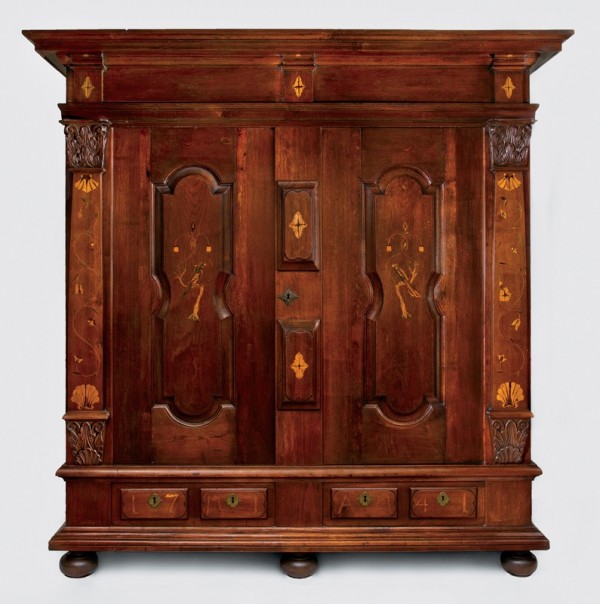
Schrank, Philadelphia area, Pennsylvania, 1741. Walnut and mixed-wood inlay with yellow pine, tulip poplar, walnut, and oak. H. 76", W. 75 1/4", D. 27 1/2". (Courtesy, Rocky Hill Collection; photo, Gavin Ashworth.)

Detail of an inlaid pilaster on the schrank illustrated in fig. 28. (Photo, Gavin Ashworth.)
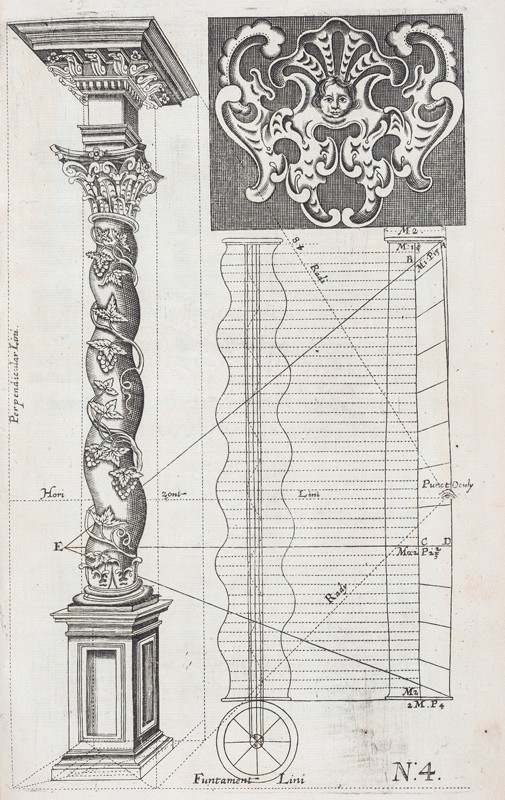
Detail of a column with carved floral decoration, in Georg Caspar Erasmus, Seulen-Buch Oder Gründlicher Bericht von der Fünff Ordnungen der Architectur-Kunst welche solche von Marco Vitruvio, Jacobo Barrozzio, Hans Blumen C. und Andern . . . (Nuremberg, 1688). (Courtesy, Winterthur Library, Printed Book and Periodical Collection; photo, James Schneck.)
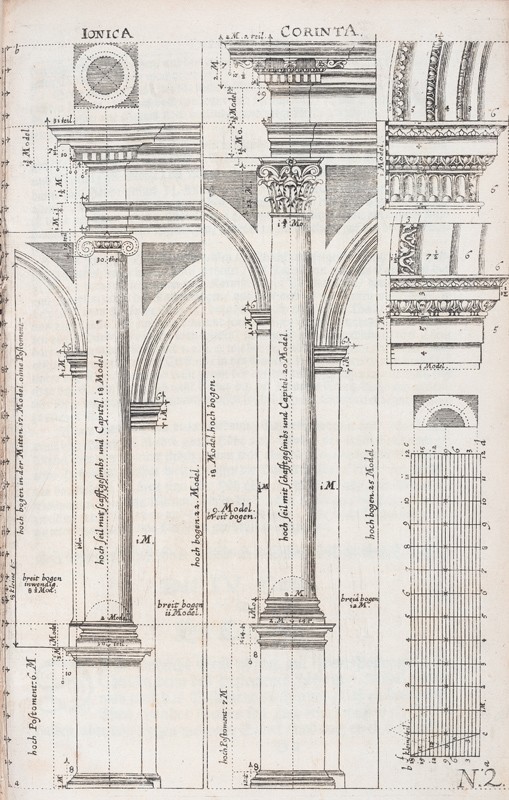
Detail of the Ionic and Corinthian orders, in Georg Caspar Erasmus, Seulen-Buch Oder Gründlicher Bericht von der Fünff Ordnungen der Architectur-Kunst welche solche von Marco Vitruvio, Jacobo Barrozzio, Hans Blumen C. und Andern . . . (Nuremberg, 1688). (Courtesy, Winterthur Library, Printed Book and Periodical Collection; photo, James Schneck.)

Detail of the inlaid shell and carved capital on the schrank illustrated in fig. 28. (Photo, Gavin Ashworth.)
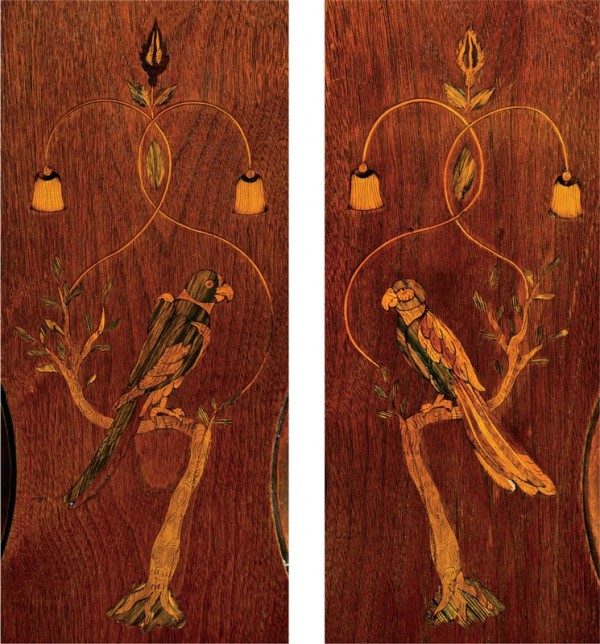
Details of the inlaid birds on the schrank illustrated in fig. 28. (Photo, Gavin Ashworth.)
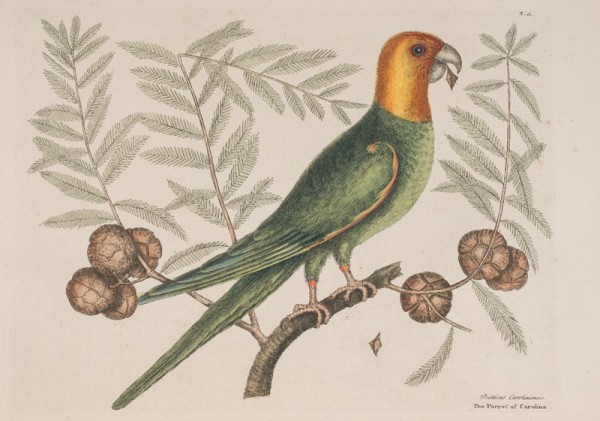
The Parrot of Carolina, in Mark Catesby, Natural History of Carolina, Florida and the Bahama Islands (London, 1729–1747). (Courtesy, Winterthur Library, Printed Book and Periodical Collection; photo, James Schneck.)
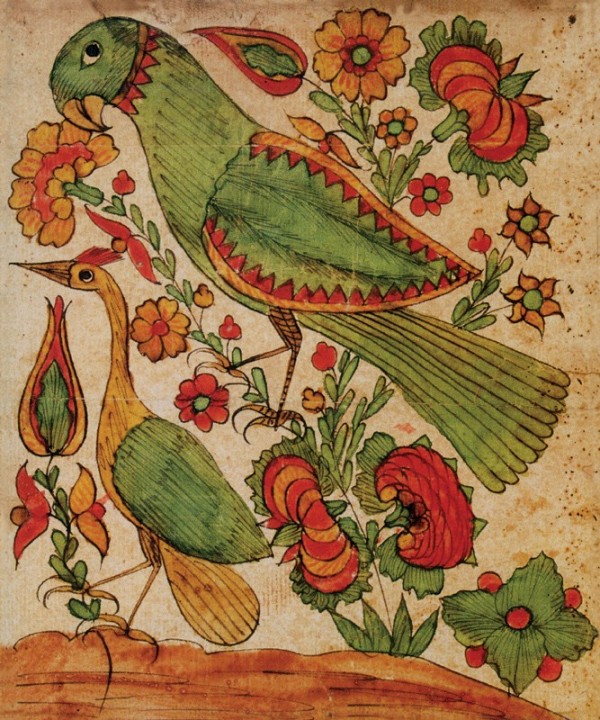
Drawing of a parrot, bird, and flowers, attributed to Henrich Otto, Lancaster County, Pennsylvania, ca. 1780. Watercolor and ink on laid paper. 7 7/8" x 6 1/2". (Collection of Dr. and Mrs. Donald M. Herr.)

Desk, Philadelphia area, Pennsylvania, ca. 1750. Walnut and mixed-wood inlay with walnut and tulip poplar. H. 42 3/4", W. 42", D. 21 1/4". (Private collection; photo, Gavin Ashworth.)
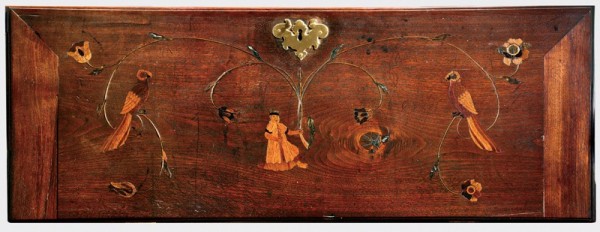
Lid of the desk illustrated in fig. 36. (Photo, Gavin Ashworth.)
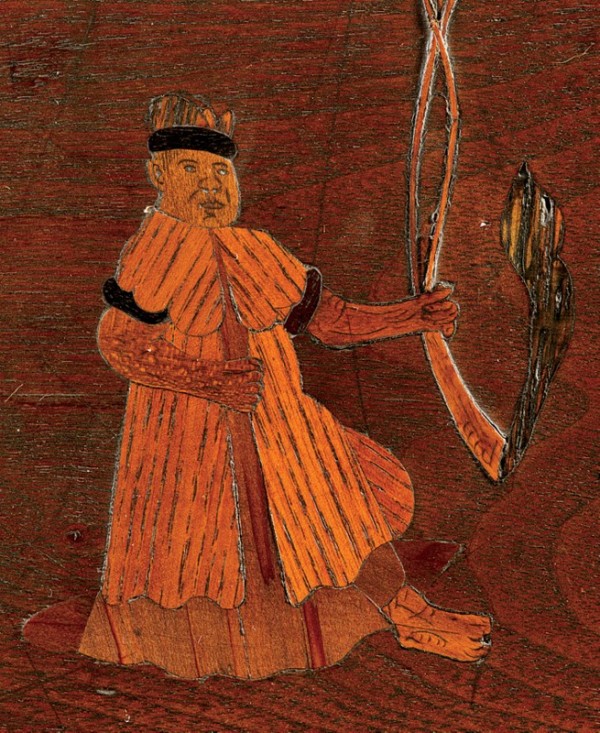
Detail of the figure inlaid on the desk illustrated in fig. 36. (Photo, Gavin Ashworth.)
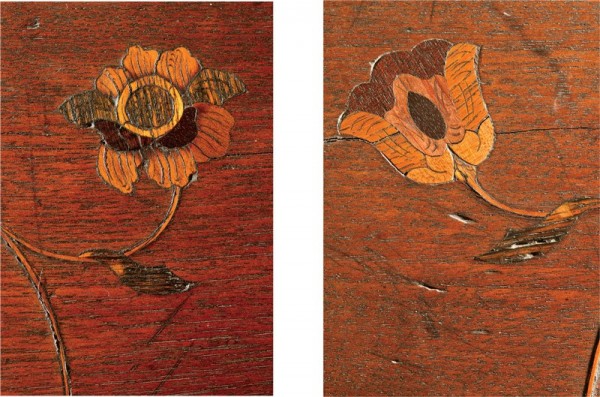
Details showing two flowers inlaid on the desk illustrated in fig. 36. (Photo, Gavin Ashworth.)
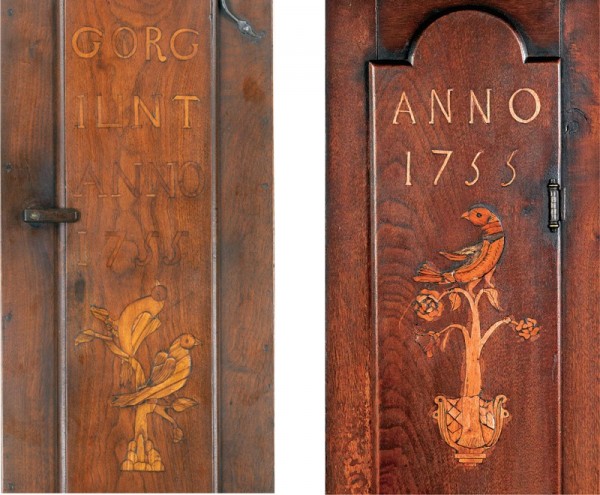
Details showing the birds inlaid on the pendulum doors of a clock made for George Yunt, Ephrata, Lancaster County, Pennsylvania, 1755 (left), and a clock, Lancaster County, Pennsylvania, 1755 (right). (Courtesy, Earle H. and Yvonne Henderson; photo, Winterthur Museum, Laszlo Bodo [left]; courtesy, Pook & Pook [right].)
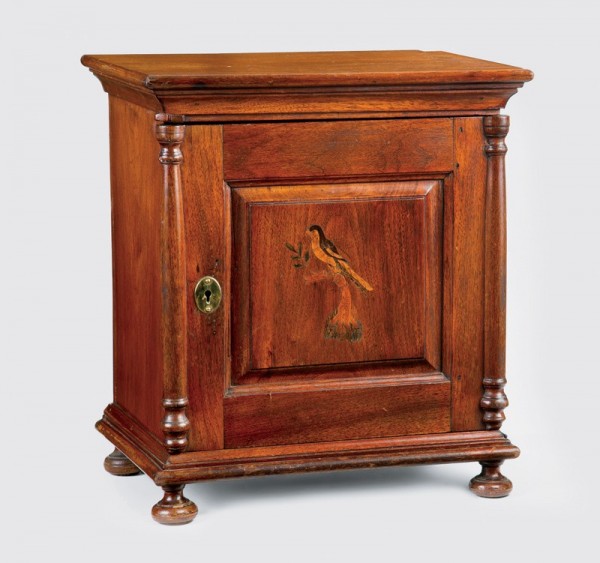
Valuables cabinet or spice box, Philadelphia area, Pennsylvania, ca. 1740. Walnut and mixed-wood inlay with walnut and pine. H. 16", W. 14 1/4", D. 10 1/8". (Private collection; photo, Gavin Ashworth.)
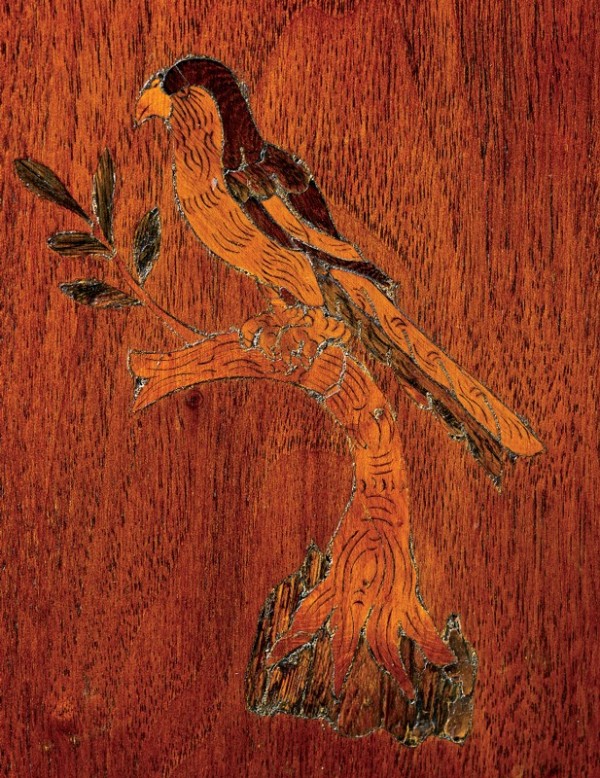
Detail of the inlay on the cabinet illustrated in fig. 41. (Photo, Gavin Ashworth.)
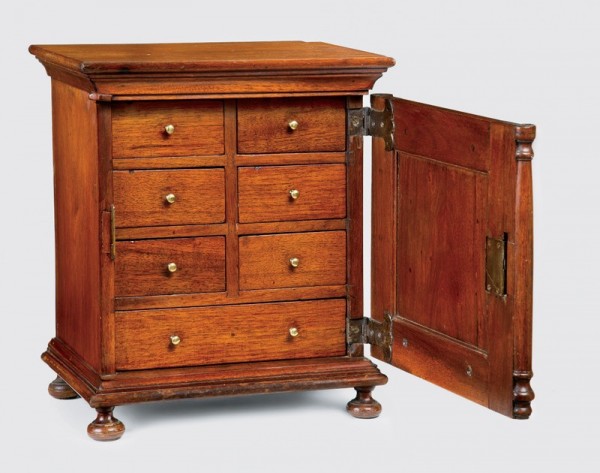
Detail of the interior of the cabinet illustrated in fig. 41. (Photo, Gavin Ashworth.)
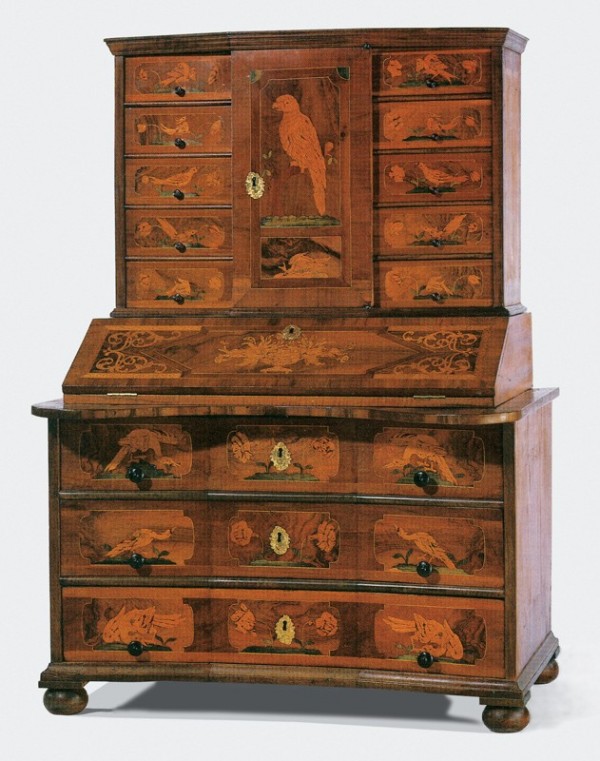
Desk-and-bookcase, Kirchheim unter Teck, Baden-Württemberg, Germany, 1720–1730. Walnut, maple, and plum with poplar and yew. H. 62 1/2", W. 44 1/4", D. 30". (Courtesy, Landesmuseum Württemberg, Stuttgart, 1977/106.)
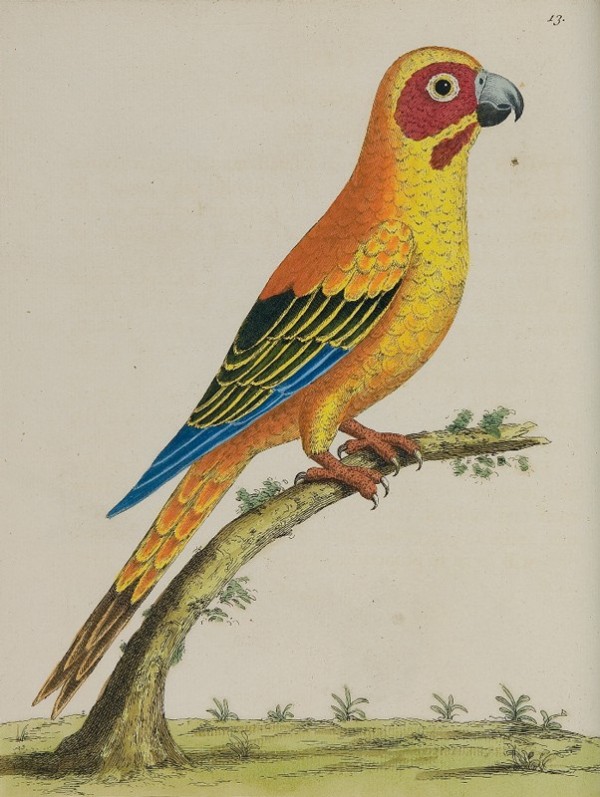
A Parroqueet from Angola, in Eleazar Albin, A Natural History of Birds, vol. 3 (London, 1740). (Courtesy, Teylers Museum.)
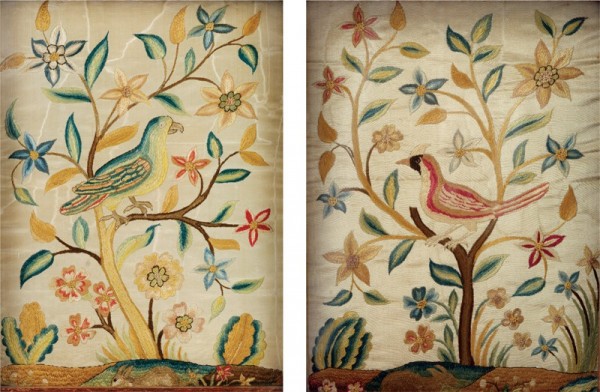
Pair of silkwork pictures, by Sarah Wistar, Philadelphia, 1752. Silk on silk moiré. 9 1/2" x 7" (unframed). (Courtesy, Winterthur Museum.)

Tall-case clock with movement by Augustin Neisser, Philadelphia area, Pennsylvania, ca. 1745. Walnut and mixed-wood inlay with tulip poplar and pine. H. 93 1/2", W. 22 1/2", D. 12 1/2". (Courtesy, Historical Society of Berks County, Reading, Pa.; photo, Gavin Ashworth.) The feet, waist door hinges, and bottom section of waist molding are replaced.

Tall-case clock with movement by Joseph Wills, Philadelphia, Pennsylvania; case, Philadelphia area, Pennsylvania, ca. 1745. Walnut and mixed-wood inlay with tulip poplar and pine. H. 86", W. 22 1/4", D. 12". (Courtesy, York County Heritage Trust; photo, Gavin Ashworth.) The waist door hinges are replaced.
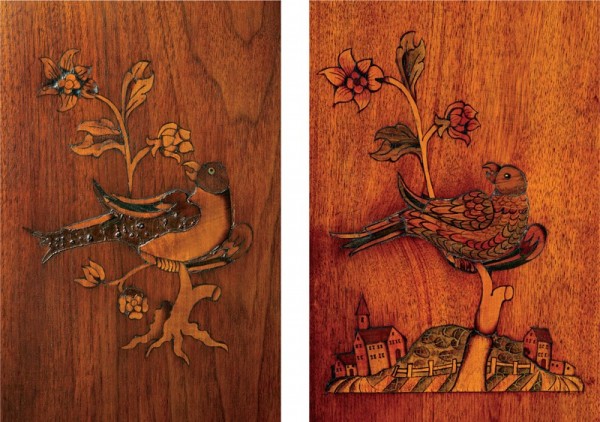
Details of the inlaid birds on the clocks illustrated in fig. 47 (left) and fig. 48 (right). (Photo, Gavin Ashworth.)

Detail of the cartouche on the clock illustrated in fig. 48. (Photo, Gavin Ashworth.)
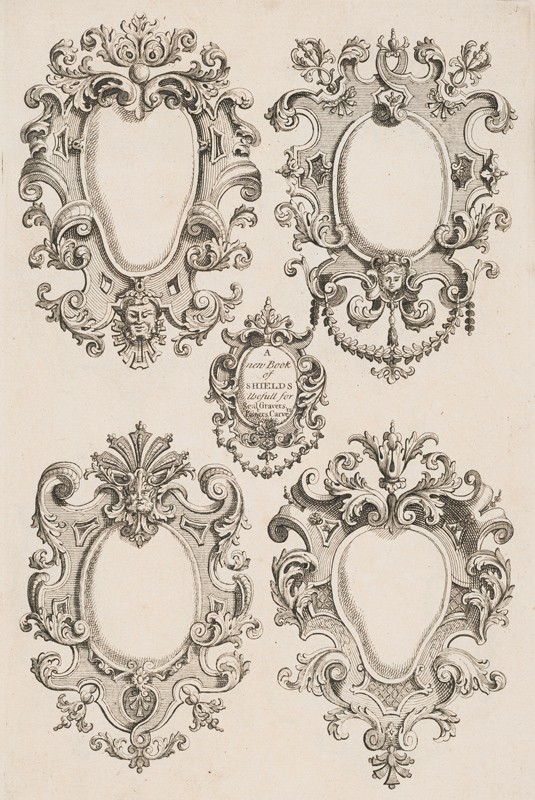
Designs for cartouches in A Compleat Book of Ornaments (London, ca. 1740). (Courtesy, Winterthur Library, Printed Book and Periodical Collection; photo, James Schneck.)
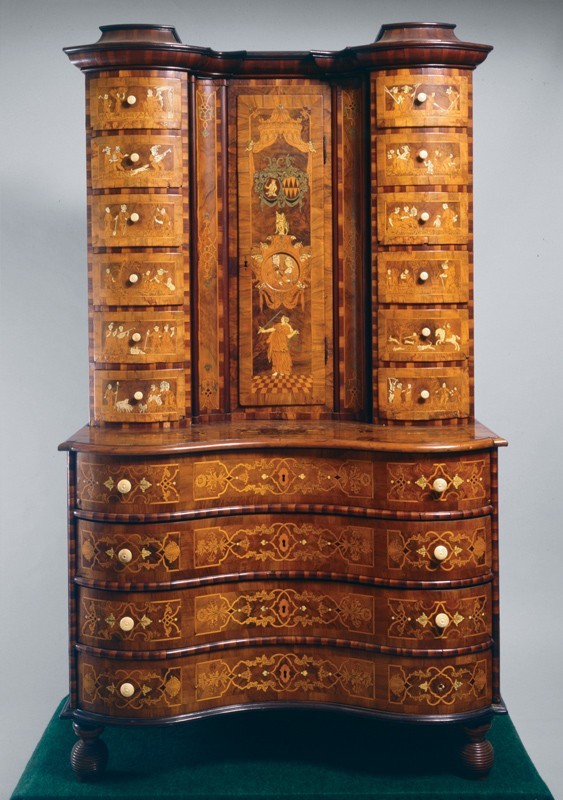
Johann Georg Wahl, tabernakelschrank Osthofen, Germany, 1743. Oak with maple and walnut veneer and mixed-wood, ivory, and ebony inlay. H. 81 1/2", W. 47", D. 26". (Courtesy, Newark Museum; photo, Robert Crabb, 1929)

Library bookcase attributed to Martin Pfeninger, Charleston, South Carolina, 1770–1775. Mahogany, mahogany and burl walnut veneer, mixed-wood inlays and ivory with cypress. H. 128 3/4", W. 99", D. 20 1/2". (Courtesy, Charleston Museum; photo, Museum of Early Southern Decorative Arts, Gavin Ashworth.)

Tall-case clock with movement by George Miller and case by William Bomberger, Germantown, Pennsylvania, 1765. Walnut with tulip poplar, and yellow pine. H. 98", W. 20 3/4", D. 11 1/4". (Private collection; photo, Winterthur Museum, Laszlo Bodo.)
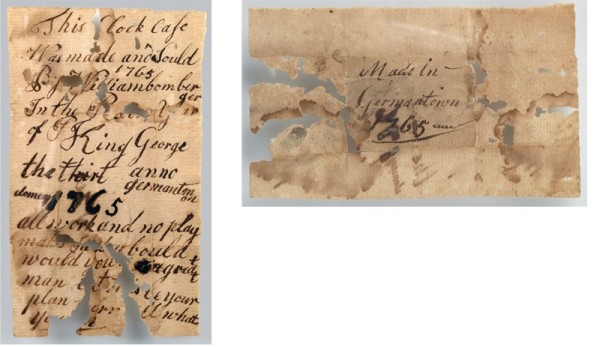
Details of the label inside the clock illustrated in fig. 54. (Photo, Laszlo Bodo.)

Jonathan Shoemaker, chest-on-chest, Philadelphia, Pennsylvania, ca. 1765. Walnut with tulip poplar and white cedar. H. 97", W. 44", D. 23". (Courtesy, © Christie’s Images Ltd.)
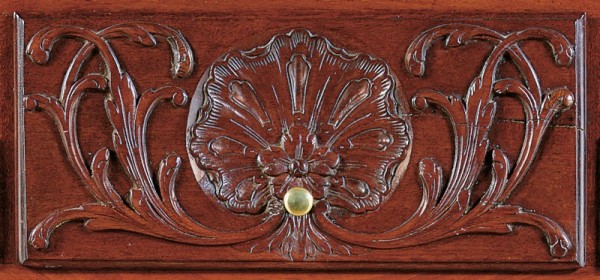
Detail of the carving on the chest-on-chest illustrated in fig. 56.
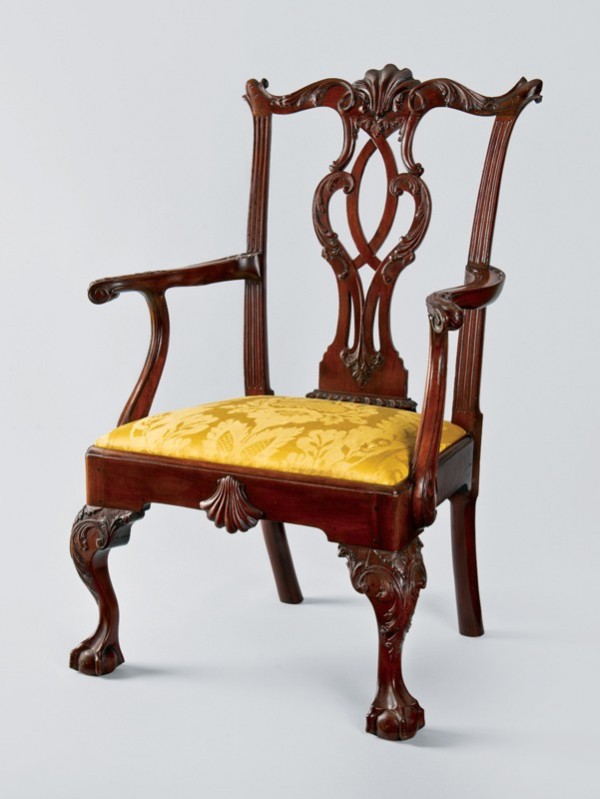
Armchair, Philadelphia, Pennsylvania, ca. 1770. Mahogany. H. 39 3/4", W. 29", D. 22". (Courtesy, Philadelphia Museum of Art, bequest of William W. Doughten, 1956; photo, Gavin Ashworth.) The splat has been altered by the removal of a carved tassel.
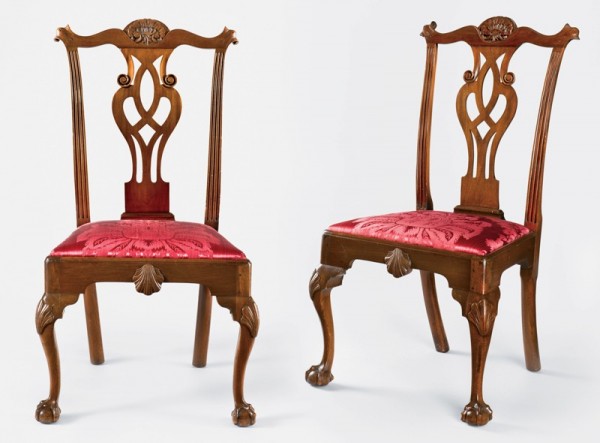
Pair of side chairs attributed to Leonard Kessler, Philadelphia, Pennsylvania, 1763. Mahogany. H. 40 1/2", W. 21 1/2", D. 17". (Private collection; photo, Gavin Ashworth.)

Detail of the cartouche on the crest of one of the chairs illustrated in fig. 59. (Photo, Gavin Ashworth.)
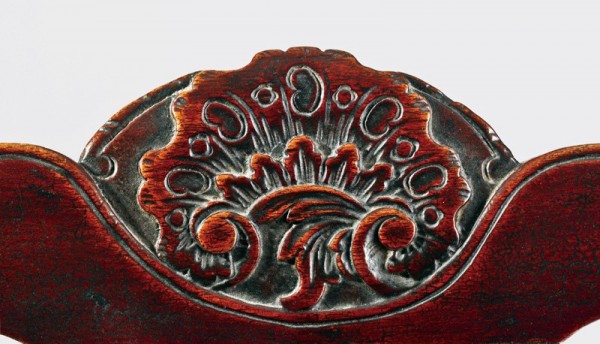
Detail of the cartouche on the chair illustrated in fig. 62. (Photo, Gavin Ashworth.)
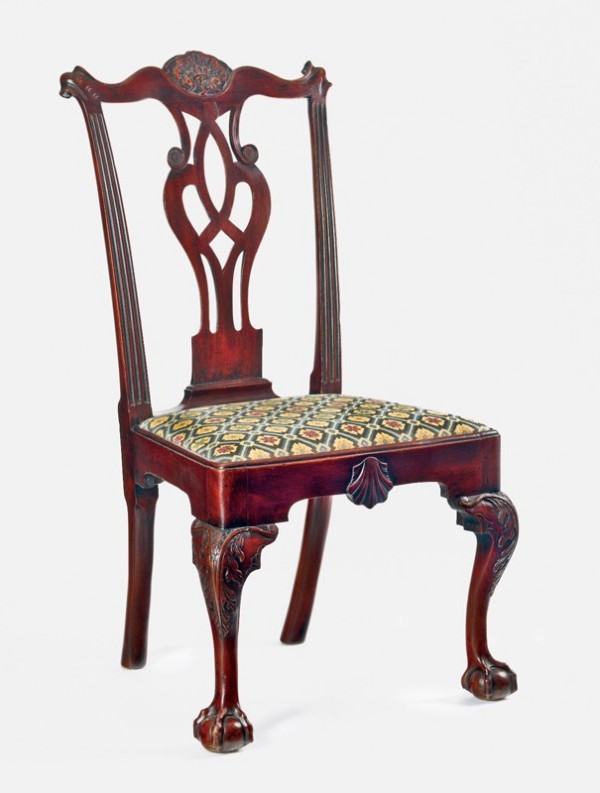
Side chair, Philadelphia, Pennsylvania, ca. 1765. Mahogany. H. 41", W. 21 1/2", D. 15 1/2". (Courtesy, Leslie Miller and Richard Worley; photo, Gavin Ashworth.) The carving is attributed to Nicholas Bernard.
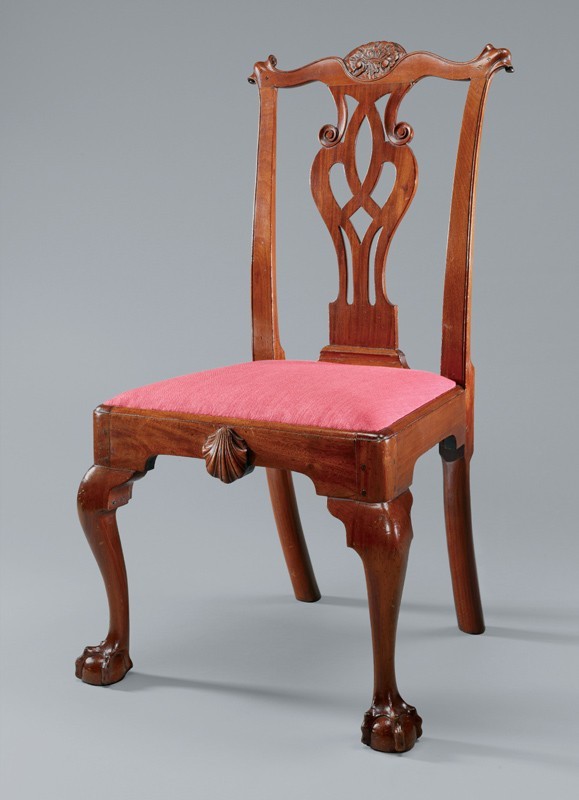
Side chair attributed to Leonard Kessler, Philadelphia, Pennsylvania, ca. 1765. Mahogany. H. 40 1/2", W. 21 1/2", D. 17". (Courtesy, Yale University Art Gallery, Mabel Brady Garvan Collection.)

Detail of the cartouche on the chair illustrated in fig. 63.
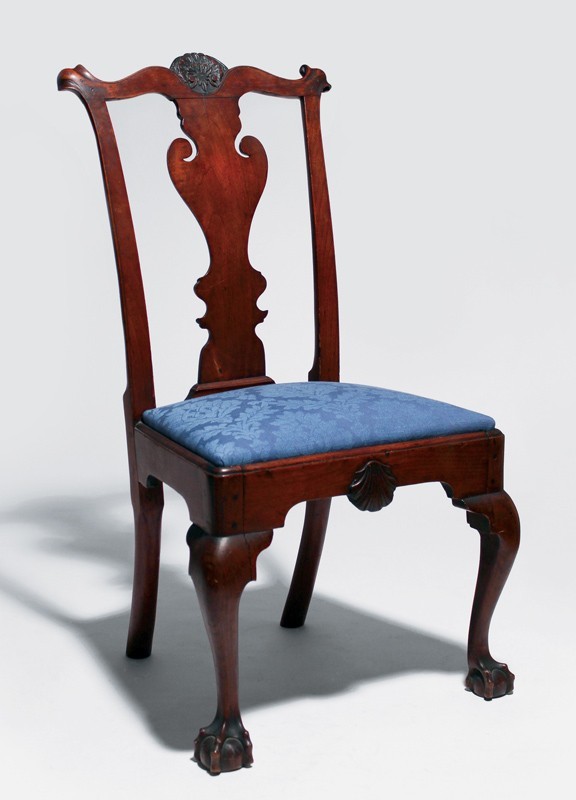
Side chair attributed to Leonard Kessler, Philadelphia, Pennsylvania, ca. 1765. Mahogany. H. 41", W. 21", D. 16 1/2". (Courtesy, H. L. Chalfant.)
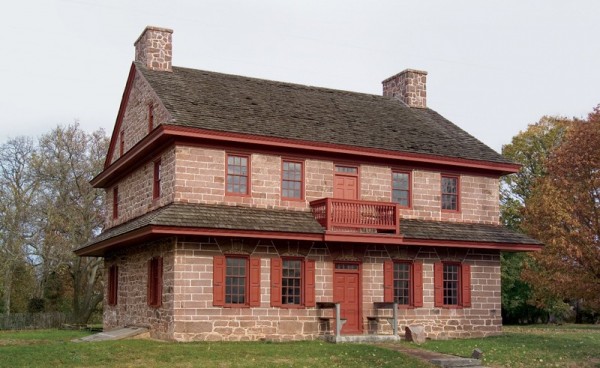
House of Henry and Mary Muhlenberg, Trappe, Montgomery County, Pennsylvania, built ca. 1750–1755. (Photo, Glenn Holcombe.)
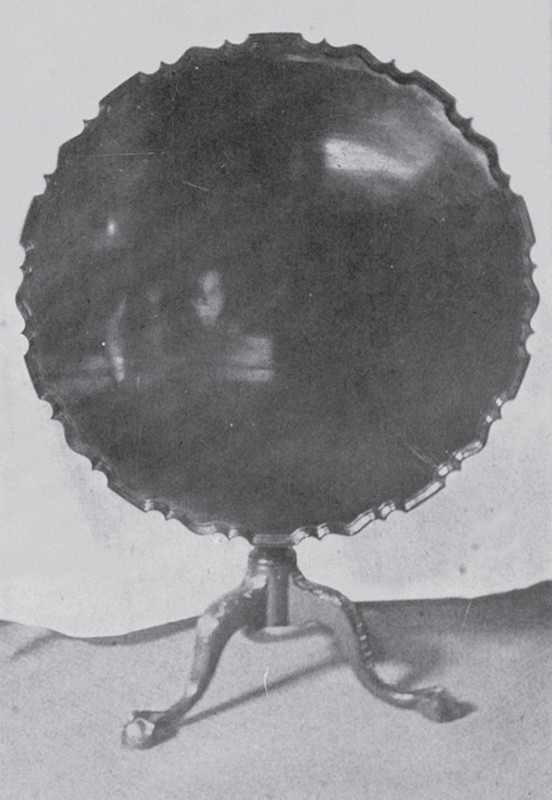
Tea table, Philadelphia, Pennsylvania, ca. 1766. Mahogany. Dimensions unrecorded. (Photo reproduced from Henrietta Meier Oakley and John Christopher Schwab, Muhlenberg Album [New Haven, Conn.: the authors, 1910].)
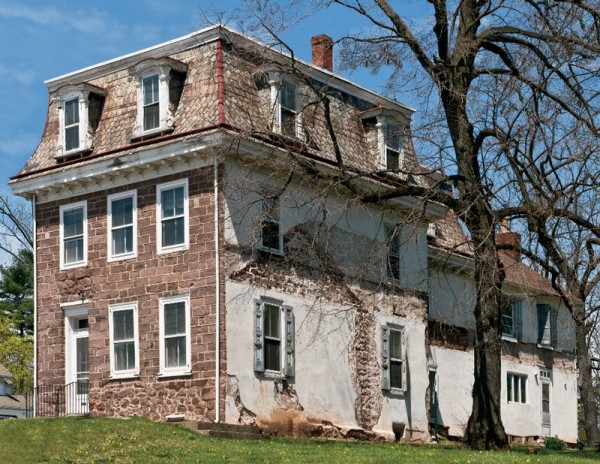
House of Frederick Muhlenberg, Trappe, Montgomery County, Pennsylvania, built ca. 1763. (Courtesy, The Speaker’s House; photo, Gavin Ashworth.) The roofline of the store is visible on the right side; the mansard roof is a later addition.
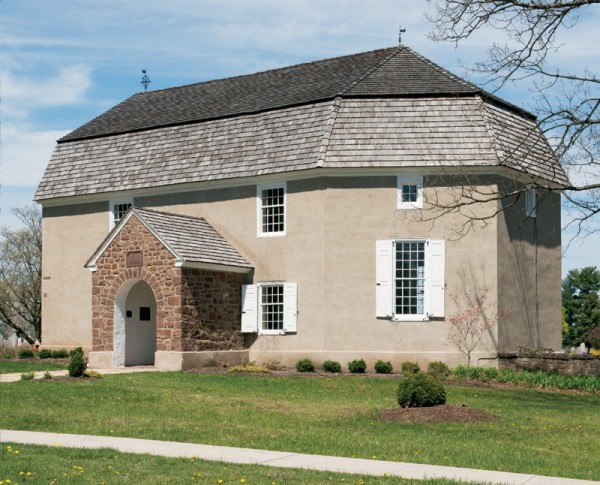
Augustus Lutheran Church, Trappe, Montgomery County, Pennsylvania, built 1743. (Photo, Gavin Ashworth.) The stucco is a later addition.

Communion flagon attributed to Johann Philip Alberti, Philadelphia, Pennsylvania, ca. 1760. Pewter. H. 13". (Courtesy, Augustus Lutheran Church; photo, Glenn Holcombe.)
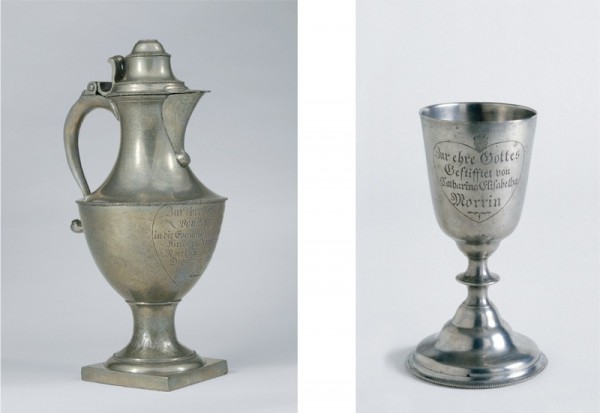
Communion flagon and chalice attributed to William Will, Philadelphia, Pennsylvania, 1795. Pewter. H. 13 3/4" (flagon), 7 7/8" (chalice). (Courtesy, Yale University Art Gallery, The Dobson Foundation; Friends of American Arts Acquisition Fund; Mr. and Mrs. Frank J. Coyle, LL.B. 1943, Fund, Peter B. Cooper, B.A. 1960, LL.B. 1964, M.U.S. 1965, and Field C. McIntyre American Decorative Arts Acquisition Fund; Friends of American Arts Decorative Arts Acquisition; and Lisa Koenigsberg, M.A. 1981, M.Phil. 1984, Ph.D. 1987, and David Becker, B.A. 1979 Fund [flagon]; Winterthur Museum [chalice].)

Side chair, Philadelphia, Pennsylvania, ca. 1760. Walnut with hard pine slip seat frame. H. 40 1/2", W. 24", D. 21". (Private collection; photo, Colonial Williamsburg Foundation, Craig McDougal.)
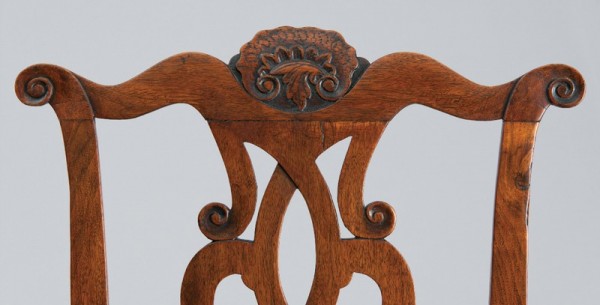
Detail of the crest on the chair illustrated in fig. 72. (Photo, Craig McDougal.)
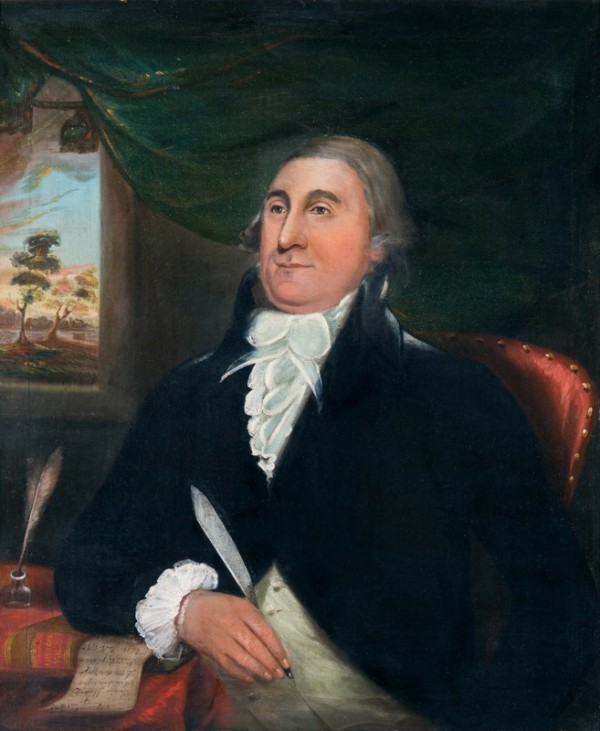
Joseph Hiester, attributed to Jacob Witman, Reading, Berks County, Pennsylvania, 1795. Oil on canvas. 36" x 30 1/2". (Courtesy, Historical Society of Berks County, Reading, Pa.; photo, Gavin Ashworth.)
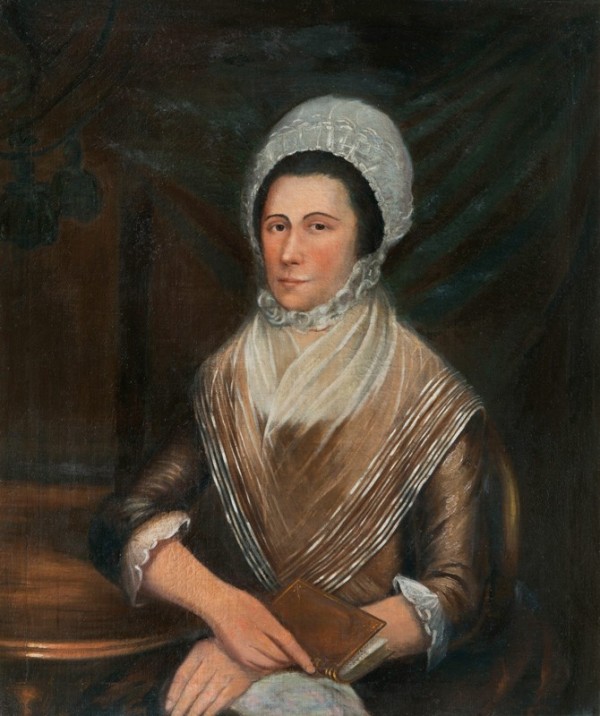
Elizabeth Hiester, attributed to Jacob Witman, Reading, Berks County, Pennsylvania, 1795. Oil on canvas. 36" x 30". (Courtesy, Historical Society of Berks County, Reading, Pa.; photo, Gavin Ashworth.)
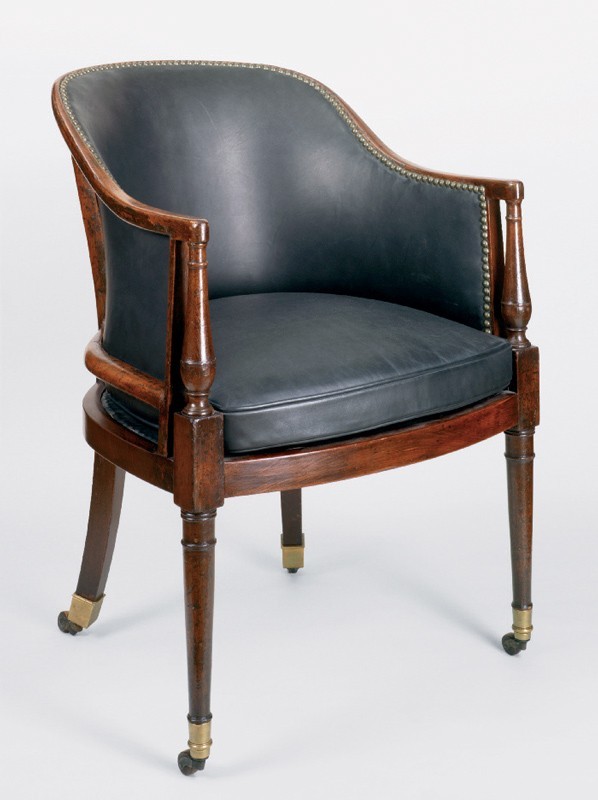
Bergère attributed to George Bright, Boston, Massachusetts, 1797. Mahogany with white pine. H. 33 1/2", W. 24", D. 23 3/4". (Courtesy, Winterthur Museum; photo, Laszlo Bodo.)
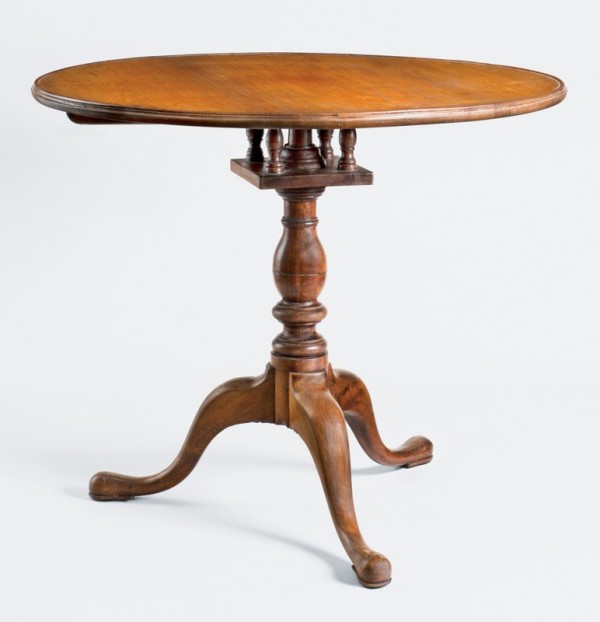
Tea table, probably Reading, Berks County, Pennsylvania, ca. 1775. Walnut. H. 28 1/8", Diam. 33 7/8".(Historical Society of Berks County, Reading, Pa.; photo, Gavin Ashworth.)

House of Daniel Hiester, Montgomery County, Pennsylvania, built 1757. (Photo, Gavin Ashworth.)

Paneled wall with built-in schrank and corner fireplace in the Daniel Hiester House. (Photo, Gavin Ashworth.)
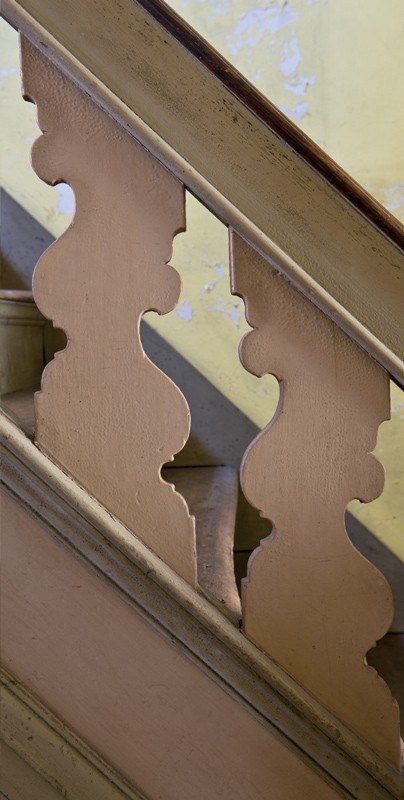
Detail of the staircase in the Daniel Hiester House. (Photo, Gavin Ashworth.)
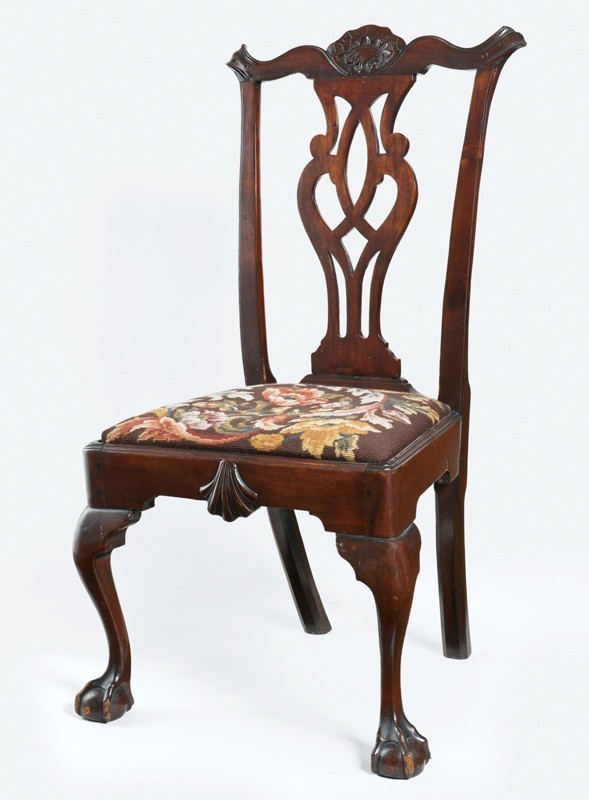
Side chair, Reading, Berks County, Pennsylvania, ca. 1765. Walnut. H. 39 1/2", W. 21 3/4", D. 20". (Courtesy, Historical Society of Berks County, Reading, Pa.; photo, Gavin Ashworth.)
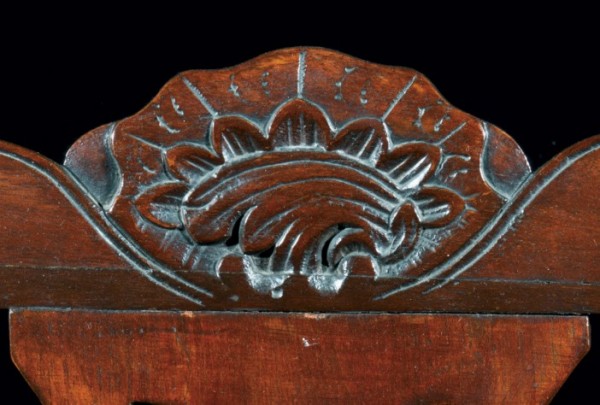
Detail of the cartouche on the chair illustrated in fig. 81. (Photo, Gavin Ashworth.)

Side chair, Berks County, Pennsylvania, ca. 1770. (Courtesy, Pook & Pook.)

John Meng, John Meng, Germantown, Pennsylvania, ca. 1750. Oil on canvas. 43 1/4" x 32 1/2". (Courtesy, Philadelphia History Museum at the Atwater Kent, The Historical Society of Pennsylvania Collection.)
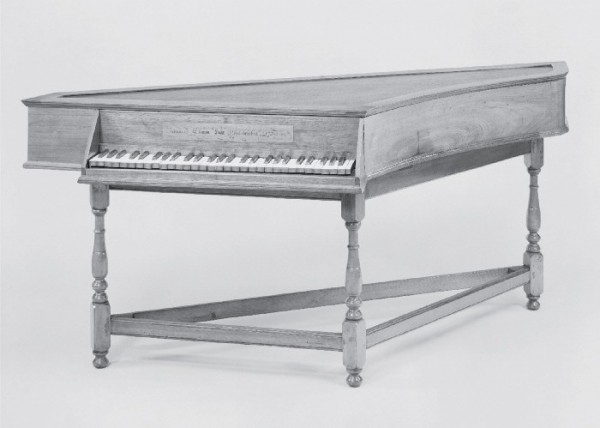
Johann Gottlob Klemm, spinet, Philadelphia, Pennsylvania, 1739. Walnut, maple, yellow pine, and white cedar. H. 33 1/2", W. 73 1/4", D. 27". (Image copyright © Metropolitan Museum of Art, Rogers Fund, 1944; image source, Art Resource, NY.) The keyboard is replaced.
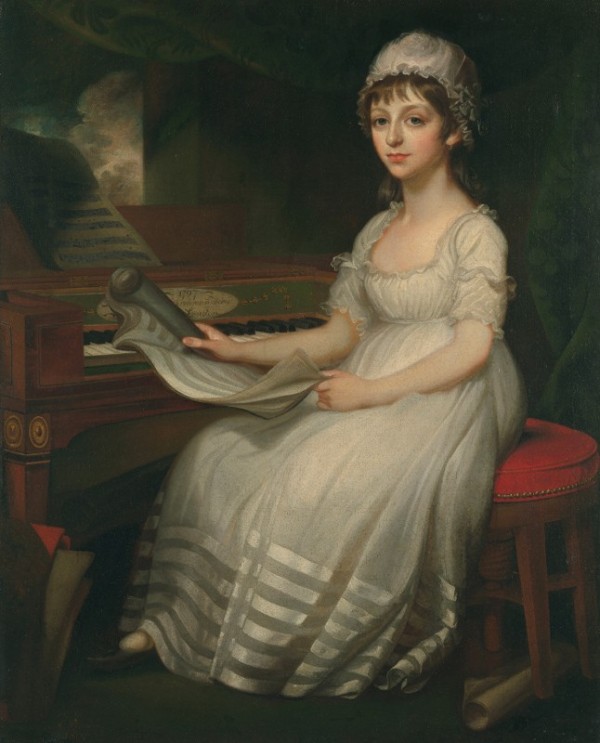
Mather Brown, Portrait of a Young Woman, Boston, Massachusetts, 1801. Oil on canvas. 50" x 40 1/4". (Image copyright © Metropolitan Museum of Art, gift of Caroline Newhouse, 1965; image source, Art Resource, NY.)
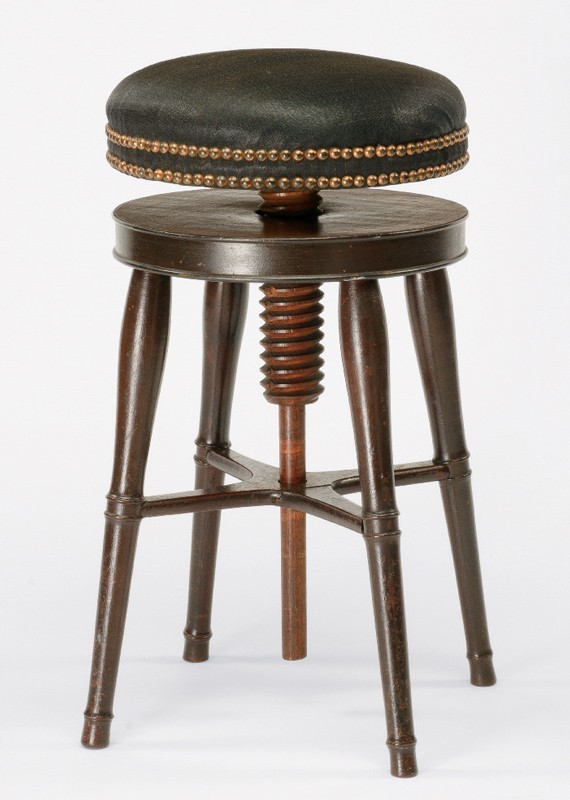
Music stool, possibly Pennsylvania, ca. 1810. Mahogany, tulip poplar, hickory (screw); paint. (Courtesy, Winterthur Museum; photo, James Schneck.) The black horsehair upholstery and brass nails are original.
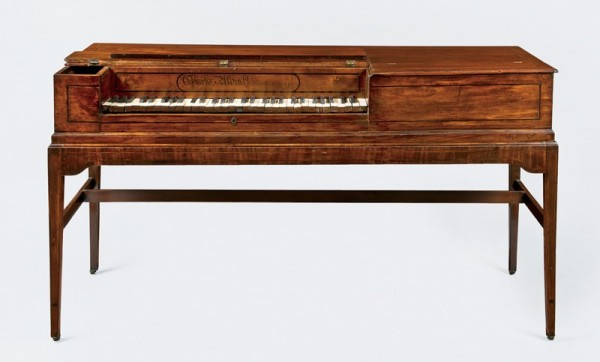
Charles Albrecht, square piano, Philadelphia, Pennsylvania, 1789. Mahogany, mahogany and satinwood veneer, black mastic, ivory, ebony, and brass. H. 31 1/2", W. 61 3/4", D. 21 1/2". (Courtesy, Philadelphia History Museum at the Atwater Kent, The Historical Society of Pennsylvania Collection; photo, Gavin Ashworth.)

Detail of the nameboard on the piano illustrated in fig. 88. (Photo, Gavin Ashworth.)

Detail of the letter “C” on the nameboard of the piano illustrated in fig. 88. (Photo, Gavin Ashworth.)

Detail of the nameboard on a square piano by Charles Albrecht, Philadelphia, Pennsylvania, ca. 1790. Mahogany, mahogany and satinwood veneer, and black mastic (infill). (Courtesy, National Museum of American History, Smithsonian Institution.)
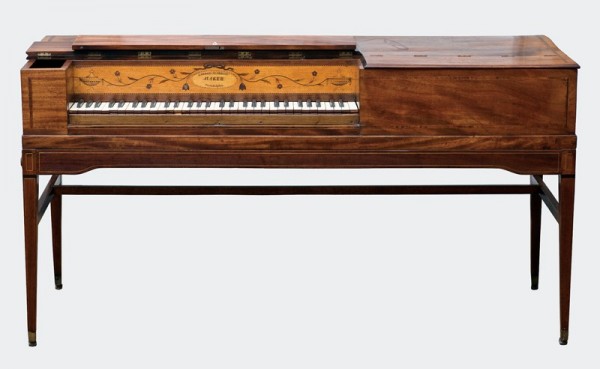
Charles Albrecht, square piano, Philadelphia, Pennsylvania, ca. 1790. Mahogany, mahogany and satinwood veneer, mixed-wood inlay, ivory, ebony, and brass. H. 33", W. 63", D. 22 1/2". (Courtesy, E. Milby Burton Memorial Trust and The Charleston Museum, photo, Sean Money.)
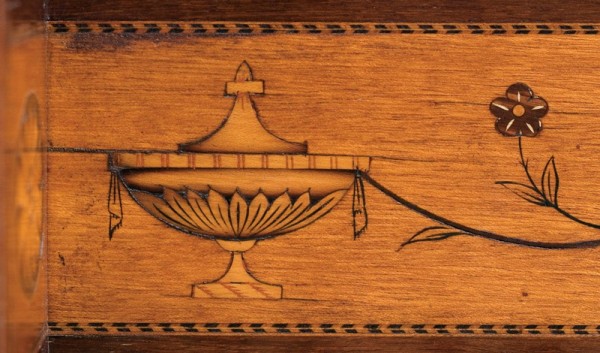
Detail of the inlay on the nameboard of the piano illustrated in fig. 92.

Detail of the nameboard on the piano illustrated in fig. 92.
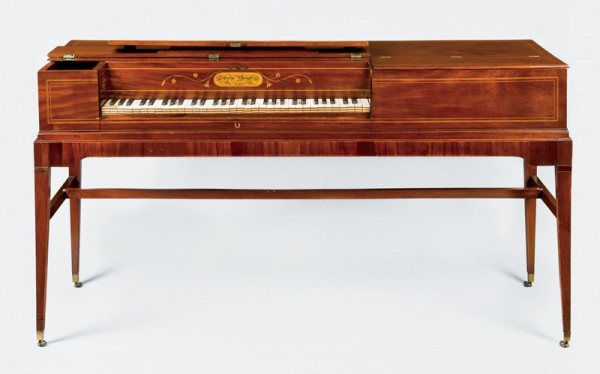
George Albrecht, square piano, Philadelphia, Pennsylvania, ca. 1797. Mahogany with mahogany veneer and mixed-wood inlay; ivory, ebony, brass. H. 33 7/8", W. 64 5/8", D. 22 1/4". (Courtesy, State Museum of Pennsylvania, Pennsylvania Historical and Museum Commission; photo, Gavin Ashworth.) The only known piano signed by George Albrecht, it may date to 1797, when Charles is absent from the Philadelphia city directory and was likely in Chester County.
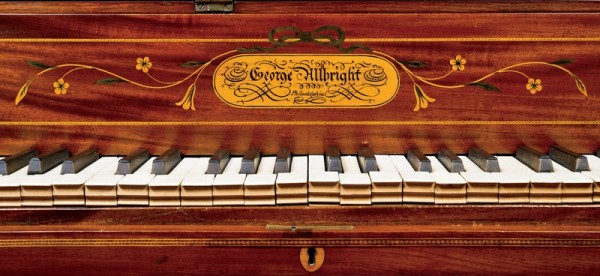
Detail of the nameboard on the piano illustrated in fig. 95. (Photo, Gavin Ashworth.)
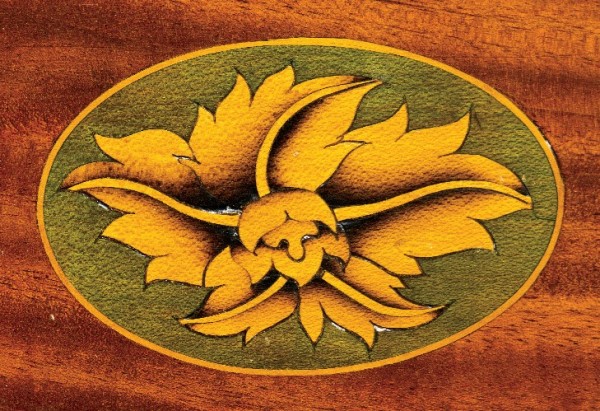
Detail of the key well inlay on the piano illustrated in fig. 95. (Photo, Gavin Ashworth.)
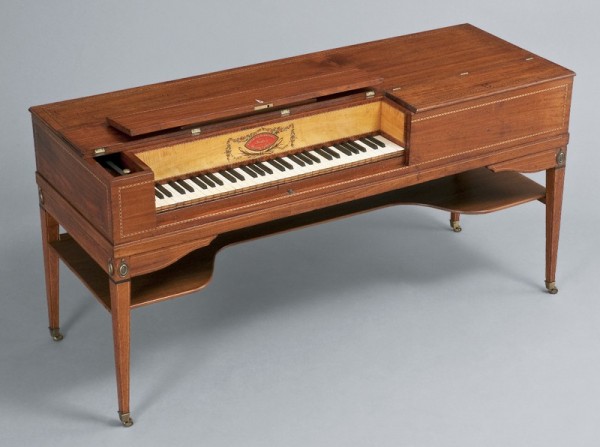
Charles Albrecht, square piano, Philadelphia, Pennsylvania, 1800–1805. Mahogany, mahogany and satinwood veneer, ivory, ebony, and brass. H. 31 1/2", W. 63", D. 22 1/4". (Courtesy, Colonial Williamsburg Foundation, gift of Mrs. Jeannette S. Hamner; photo, John Watson.) This piano has the serial number 166 and is signed on the key bed “Joshua Baker Maker.” The music shelf is replaced.
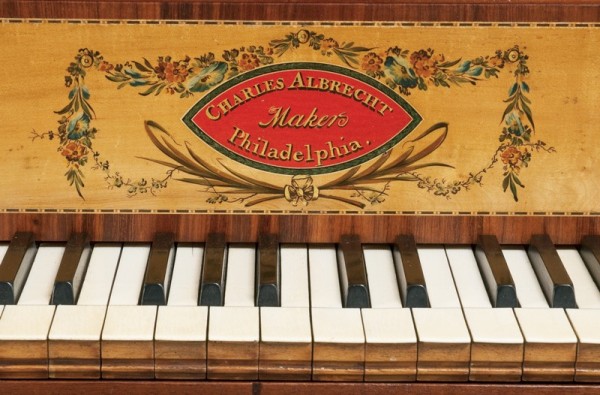
Detail of the nameboard on the piano illustrated in fig. 98.
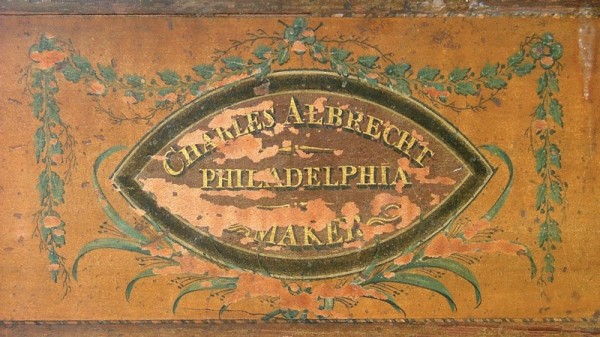
Detail of the nameboard on a square piano by Charles Albrecht, Philadelphia, Pennsylvania, ca. 1800. (Courtesy, Blennerhassett Historical Foundation; photo, Donald H. Prior.)
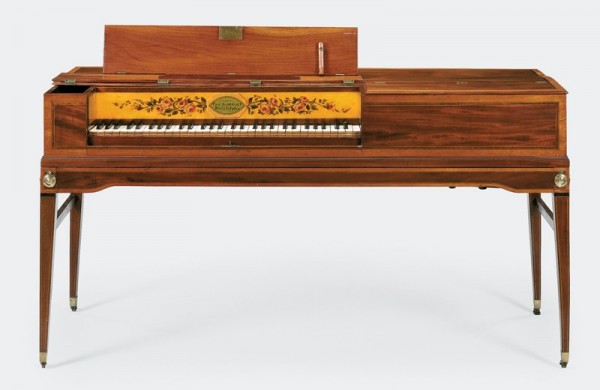
Charles Albrecht, square piano, Philadelphia, Pennsylvania, ca. 1800. Mahogany, mahogany and satinwood veneer; ivory, ebony, and brass. H. 33 3/4", W. 62 3/4", D. 22 1/4". (Courtesy, Christie’s Images, Ltd.)
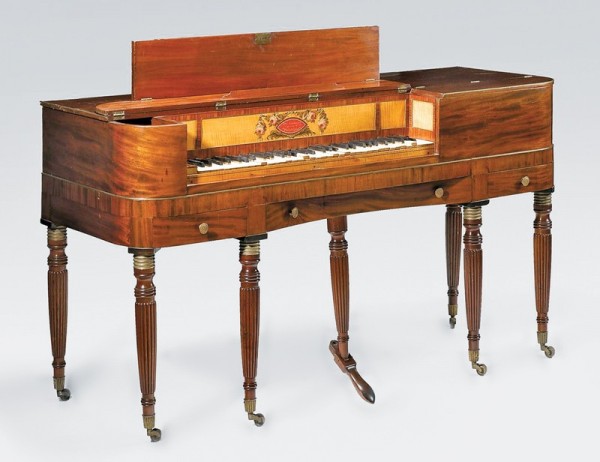
Charles Albrecht and Charles Deal, square piano, Philadelphia, Pennsylvania, 1813. Mahogany, mahogany and satinwood veneer; ivory, ebony, and brass. H. 35 1/4", W. 69", D. 25". (Courtesy, Freeman’s; photo, Elizabeth Field.) This piano has the serial number 71 and is signed on the inside by Charles Deal.

Detail of the nameboard on the piano illustrated in fig. 102. (Photo, Daniel C. Scheid.)
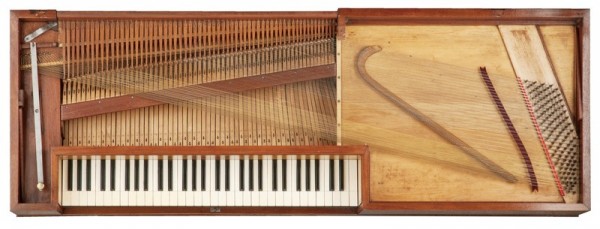
Detail of the action in the piano illustrated in fig. 98. (Photo, John Watson.)

John Huber, square piano, Harrisburg, Pennsylvania, 1805–1809. Mahogany with satinwood veneer; ivory, ebony; paper, glass. H. 33 1/8", W. 65 5/8", D. 23 1/8". (Colonial Williamsburg Foundation, The Friends of the Colonial Williamsburg Collections Fund; photo, John Watson.)
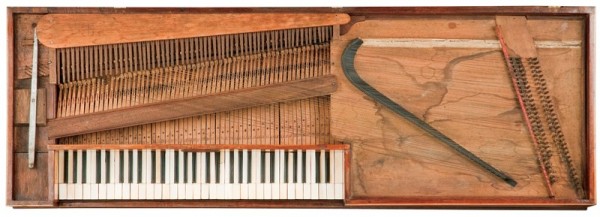
Detail of the action in the piano illustrated in fig. 105. (Photo, John Watson.)
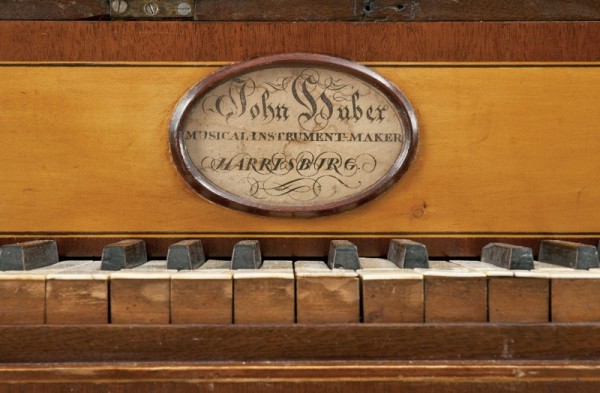
Detail of the label on the piano illustrated in fig. 105. (Photo, John Watson.)
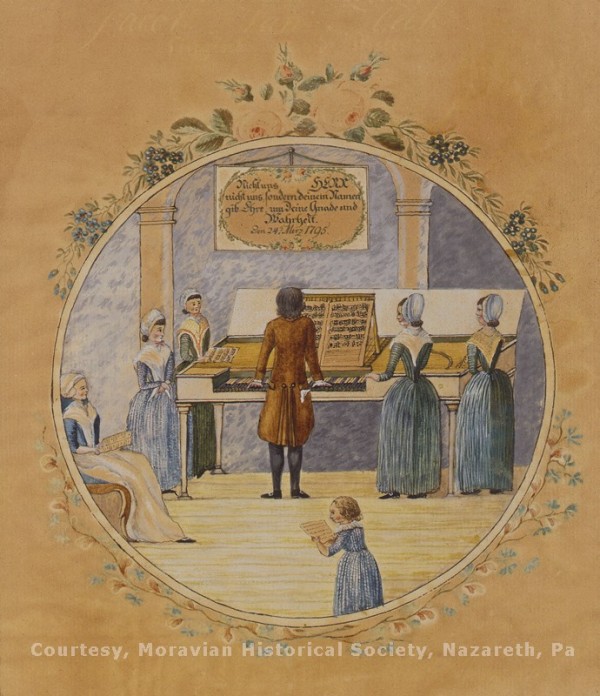
Anna Kliest, The Birthday Wish, made for Jacob van Vleck, Bethlehem, Pennsylvania, 1795. 9" x 7 1/2". Watercolor and ink on laid paper. (Courtesy, Moravian Historical Society, Nazareth, Pa.)
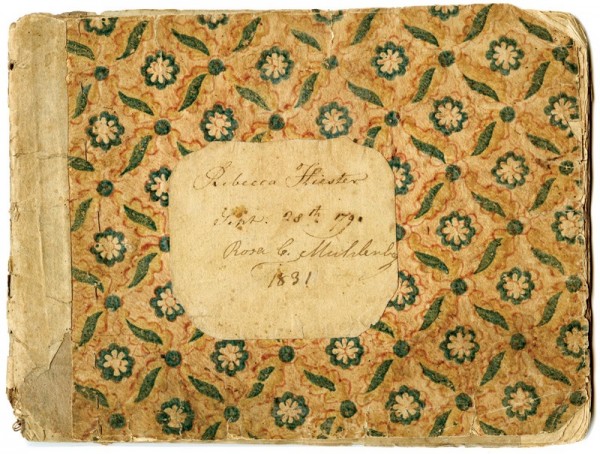
Tunebook, probably Bethlehem, Pennsylvania, 1791. (Courtesy, Winterthur Library, Joseph Downs Collection of Manuscripts and Printed Ephemera; photo, James Schneck.) This book may have been shared with Rebecca Hiester’s sister, Mary Elisabeth, whose name is inscribed within.

Detail of the nameboard on a square piano by John Haberacker, Reading, Berks County, Pennsylvania, ca. 1805. Satinwood. (Courtesy, Marlowe A. Sigal.)
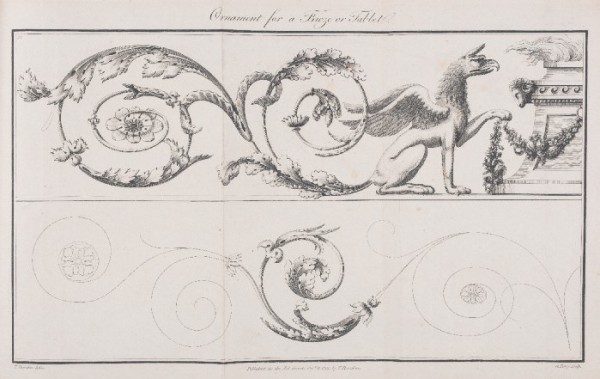
Design for a frieze or tablet illustrated in plate 36 in Thomas Sheraton’s The Cabinet-Maker and Upholsterer’s Drawing Book (London, 1791–1794). (Courtesy, Winterthur Library, Printed Book and Periodical Collection; photo, James Schneck.)
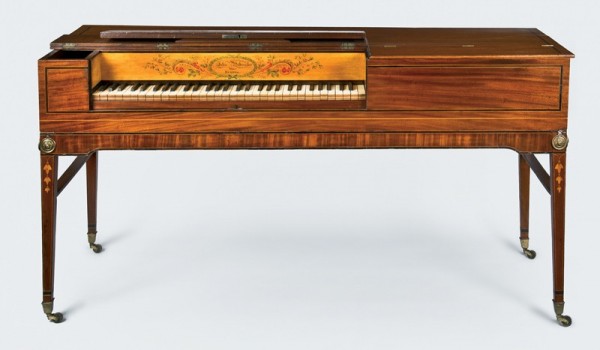
John Haberacker, square piano, Reading, Berks County, Pennsylvania, ca. 1805. Mahogany with mahogany and satinwood veneer, ivory, and ebony. H. 33 5/8, W. 64, D. 22 5/8". (Courtesy, Historic RittenhouseTown; photo, Gavin Ashworth.)

Detail of the nameboard on the piano illustrated in fig. 112. (Photo, Gavin Ashworth.)
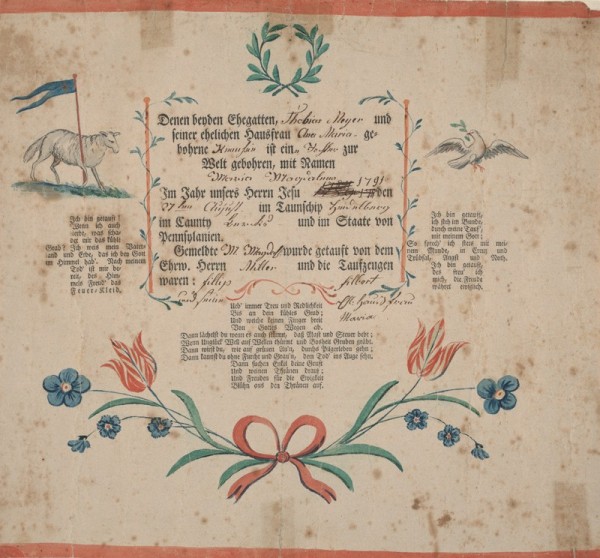
Birth and baptismal certificate of Maria Magdalena Meyer, decoration attributed to Frederick Christopher Bischoff, Reading, Berks County, Pennsylvania, ca. 1800. Watercolor and ink on laid paper. 13" x 14". (Courtesy, Rare Books Department, Free Library of Philadelphia.)
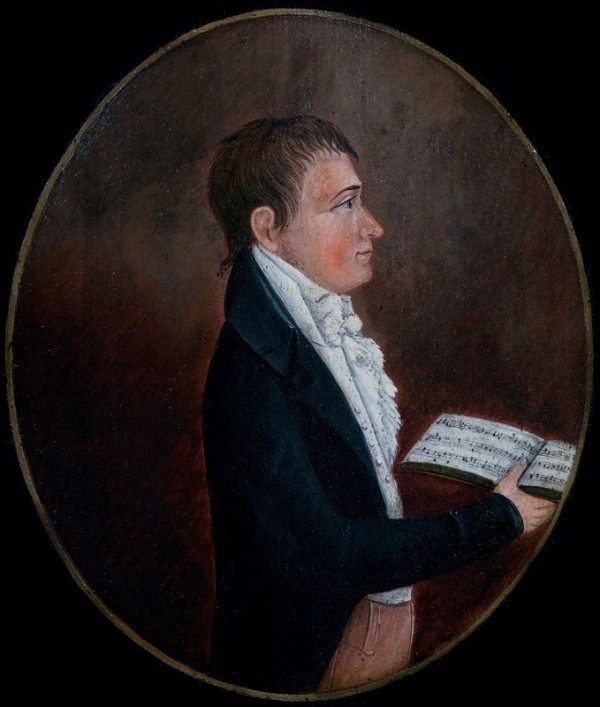
Portrait of John Stump, attributed to Frederick Christopher Bischoff, Reading, Berks County, Pennsylvania, ca. 1805. Oil on panel. 10" x 8". (Courtesy, Historical Society of Berks County, Reading, Pa.; photo, Gavin Ashworth.)
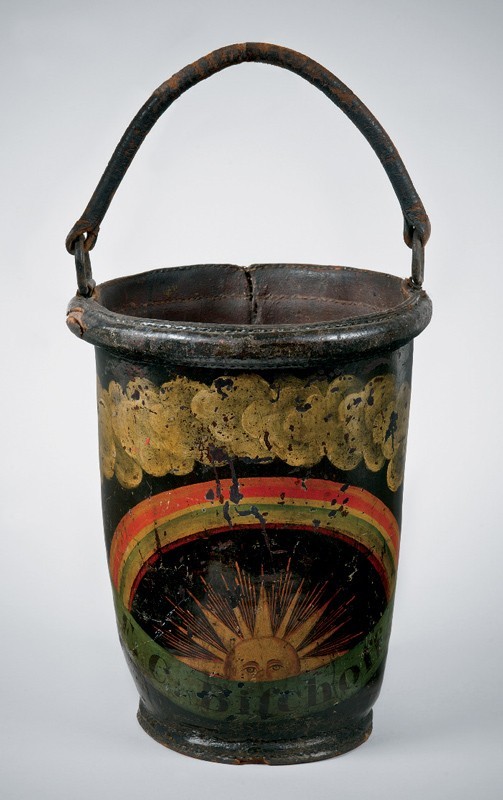
Frederick Christopher Bischoff, fire bucket, Reading, Berks County, Pennsylvania, ca. 1805. Leather. H. 13". (Courtesy, Historical Society of Berks County, Reading, Pa.; photo, Gavin Ashworth.)
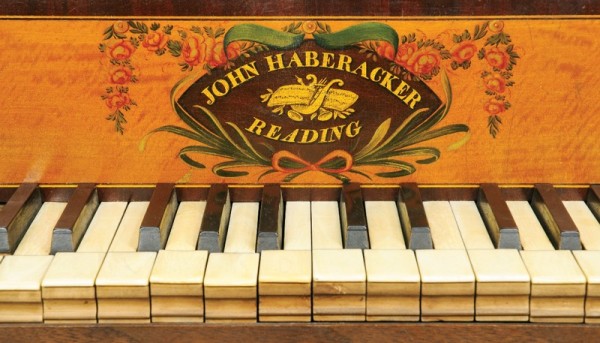
Detail of the nameboard on a square piano by John Haberacker, Reading, Berks County, Pennsylvania, ca. 1820. (Courtesy, John Watson.)

Joseph Wright, Frederick Augustus Conrad Muhlenberg, New York, 1790. Oil on canvas with applied wood strip. 47" x 37" (including frame). (Courtesy, National Portrait Gallery, Smithsonian Institution / Art Resource, NY.) A 1 3/8" strip of wood was added to the canvas at the left edge and painted by Wright.
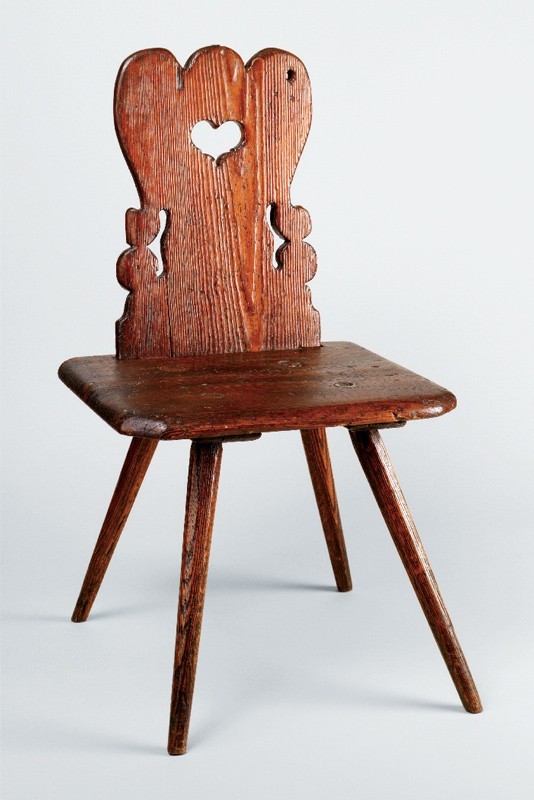
Brettstuhl (board chair), southeastern Pennsylvania, ca. 1775. Pine and oak. H. 32", W. 18", D. 18". (Courtesy, Winterthur Museum; photo, Laszlo Bodo.)

Chair attributed to Johann Friedrich Bourquin (1762–1830), Bethlehem, Northampton County, Pennsylvania, 1803–1806. Maple; paint. H. 39 1/4", W. 18 1/2", D. 18". (Courtesy, Moravian Archives, Bethlehem, Pa.; photo, Winterthur Museum, Laszlo Bodo.)
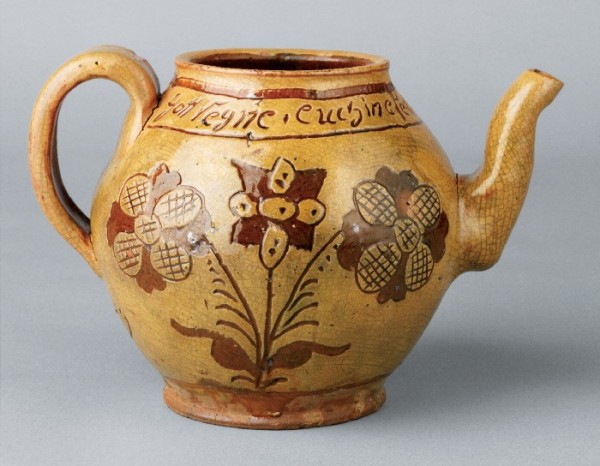
Teapot, southeastern Pennsylvania, 1779. Lead-glazed red earthenware. H. 5 5/8". (Courtesy, Winterthur Museum; photo, Laszlo Bodo.)

Christian Wiltberger (1766–1851), sugar bowl. Philadelphia, Pennsylvania, ca. 1800. Silver. H. 10 1/4". (Courtesy, Winterthur Museum.)

Chest-over-drawers, southeastern Pennsylvania, ca. 1815. Pine; paint; brass. H. 29 3/8", W. 51", D. 23". (Courtesy, Winterthur Museum; photo, Laszlo Bodo.)
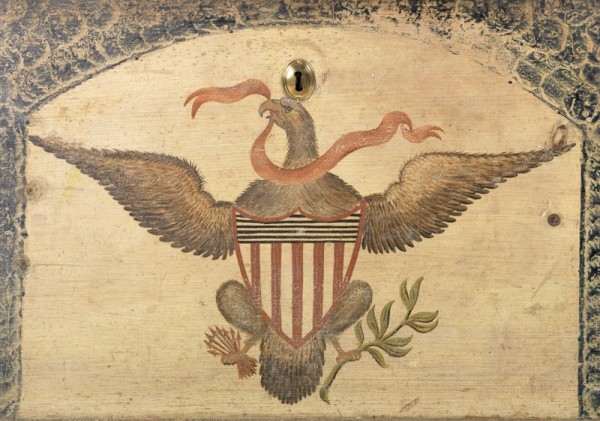
Detail of the eagle on the chest illustrated in fig. 123. (Courtesy, Winterthur Museum; photo, Laszlo Bodo.)
FIRE! Jacob Hiltzheimer heard the alarm while visiting a neighbor on the evening of December 26, 1794. About eight o’clock, the wife of Quaker merchant Henry Drinker was sitting in her back parlor when she heard “the noise of a Fire Engine, and the ringing of Bells.” Both Hiltzheimer and Drinker went to investigate and learned the fire was in the back of Zion Lutheran Church at Fourth and Cherry Streets in Philadelphia, where a steeple was under construction. By nine o’clock, the church was thought safe. Soon, however, the bells began ringing again. The fire had spread to the roof (fig. 1). Elizabeth Drinker climbed to the third floor of her house and watched while a “mighty blaze” consumed the church, a “great and superb building . . . said to be one of the most splendid in the Union.” When the sun came up the next day, she found pieces of burned shingles in her yard. The fire had caused the church roof to collapse, gutting the interior and destroying its magnificent new organ, built by David Tannenberg and completed just four years earlier. Only the brick walls remained.[1]
Zion was one of two German Lutheran churches in Philadelphia at the time, which together with St. Michael’s formed one congregation. Construction began on the first church, St. Michael’s, following the arrival of Lutheran minister and German émigré Henry Melchior Muhlenberg (1711–1787) in November 1742 (fig. 2). Appalled by the “leaky slaughterhouse” in which the members of the congregation had been worshipping, Muhlenberg led them to acquire a lot on Fifth Street at Appletree Alley and embarked on the construction of a church. Dedicated in 1748, St. Michael’s was an impressive brick edifice that cost a substantial £1,607 to build and measured 45 by 70 feet (fig. 3). It was also the first church in Philadelphia to have a steeple tower, although the weight of the tower caused the walls to bow and it had to be removed in 1750. Although the church had a seating capacity of eight hundred, it was soon overcrowded. A brick schoolhouse was built in 1761 to provide additional space, and in October 1765 the front pews were altered to accommodate more people. The congregation was becoming so large that these measures proved insufficient, even with the use of a third building (Whitefield Hall or New Building at the College of Philadelphia), so they acquired a nearby lot at Fourth and Cherry Streets on which to build a new church (fig. 4). Robert Smith was hired as the architect, and construction began in 1766. When completed, Zion measured 108 by 70 feet and had seating capacity for twenty-five hundred; it was one of the largest public buildings in the country and cost more than £9,500. The church was dedicated on two successive days in June 1769, with services held in German the first day and in English on the second. Inside, eight large fluted columns supported the arched ceiling, while the galleries were ornamented with a Doric entablature. The brick exterior was also grand, with Venetian windows, brick pilasters, and ornately carved pediments and cornices. A balustrade of urns ran along the roof. Less than ten years after it was completed, Zion was taken over during the British occupation of Philadelphia and used as a hospital, service that wreaked havoc on the interior. It was repaired and a service of thanksgiving held there on December 21, 1781, following Cornwallis’s surrender at Yorktown.
In 1786 the congregation hired David Tannenberg (1728–1804), a Moravian, to make what would be the largest and finest organ built in eighteenth-century America. With three manuals (or keyboards) and thirty-four stops, it was Tannenberg’s masterpiece and cost the congregation a staggering £1,500—not including the case. Master joiner George Vorbach/Forepaugh (ca. 1741–1817), who was a member of the congregation, built the case. Measuring 24 feet wide, 27 feet high, and 8 feet deep, the case had five towers and more than one hundred pipes. On the central tower was a painting of the sun rising above the clouds, flanked by gilded eagles and trumpeting angels on the side towers. A skilled craftsman, Vorbach was a member of the Carpenters’ Company of Philadelphia and in 1787 oversaw the construction of the senate gallery in Congress Hall. The dedication of the organ in October 1790 was held over three days to accommodate the large crowds who attended, and Michael Billmeyer of Germantown printed a special pamphlet in German for the occasion. Although the organ was lost in the fire of 1794, some sense of its scale and grandeur can be found in the organ of Trinity Lutheran Church at Lancaster (fig. 5).[2]
In an impressive campaign of one-upmanship, Trinity Lutheran commissioned an organ with twenty stops from Tannenberg in 1771; two years earlier, the German Reformed church in Lancaster had hired him to build them an organ with fifteen stops. Whereas the latter organ had a case made for £50 by local cabinetmaker George Burkhardt (d. 1783), the Lutherans hired Peter Frick (1743–1822), who had recently moved to Lancaster from Germantown, to build the case. A masterpiece of cabinetwork for which the church paid £210, the case has fluted columns on the lower half, elaborate moldings, carved and pierced overlays, and ornate finials on each of the five towers. The carving is strongly reminiscent of Philadelphia workmanship, and some of it may even have been executed there, as a payment was made in January 1774 for transporting “wood or wooden parts” for the organ from Philadelphia (fig. 6). The organ was dedicated in December 1774 and at the time was the largest built in America. Four years later, it overwhelmed a British lieutenant who saw the church interior. He wrote: “the large galleries on each side, the spacious organ loft, supported by Corinthian pillars, are exceedingly beautiful . . . . The church, as well as the organ, painted white with gilt decorations, which has a very neat appearance . . . the organ is reckoned the largest and best in America. . . . It is the largest, and I think the finest I ever saw, without exception.”[3]
Following the devastating fire at Zion Church in 1794, the congregation decided to rebuild and hired master builder William Colladay to oversee the project. The organ, which Tannenberg offered to rebuild for £3,000, was postponed for financial reasons and not completed until 1811. On November 27, 1796, the rebuilt church was consecrated. Three years later, on December 26, 1799, some four thousand people crowded into Zion to attend the state memorial service for George Washington, following a funeral procession that began at the Pennsylvania State House (Independence Hall). Bishop William White, rector of Christ Church, led the service, and General Richard Henry Lee of Virginia delivered his famous eulogy from the pulpit. Eight years earlier, on March 22, 1791, a large crowd had gathered at Zion for Benjamin Franklin’s memorial service. A photograph of Zion taken in 1866 during the church’s centennial celebration shows the post-1794 interior, with its elegant wineglass pulpit and sounding board topped with a gilt blaze finial and neoclassical ornament on the galleries (fig. 7). Little else is known about the interior, as Zion was torn down in 1869; three years later, St. Michael’s would suffer the same fate.[4]
Ethnicity and Identity
With the loss of these two buildings, the most tangible vestiges of Philadelphia’s German-speaking community disappeared and its heritage was increasingly forgotten. Scholarship on the mid-Atlantic region has long since operated under a pervasive myth of English-speaking dominance. Most studies of Philadelphia have perpetuated this problem by emphasizing the city’s Quakers and Anglicans to the near-total exclusion of its sizable German-speaking population. Monolithic stereotypes of Philadelphia as the “Quaker City” obscure the German presence, and the oft-repeated description of Quaker decorative arts—“of the best Sort, but Plain”—continues to hold sway. There is also a corresponding assumption that German-speaking people were all peasant farmers who furnished their houses with nothing but painted chests, colorful pottery, and other folk art (figs. 8, 9). The notion of sophisticated, urban objects made or owned by people of German heritage is rarely considered, a misconception revealed in statements such as “in the Germanic communities of Pennsylvania, rococo ornament was seldom employed, and then usually only on special commission.” Surviving objects—including long rifles, stove plates, silver, furniture, and even some fraktur—reveal that, on the contrary, Pennsylvania German artisans and status-conscious consumers both made and acquired objects with rococo designs (figs. 10, 11). Lancaster in particular became a center of rococo-inspired furniture, initiated by “Germanic craftsmen working for Germanic patrons, under the influence of Philadelphia-oriented taste setters.” Pennsylvania German entrepreneurs also made goods that appealed to a wide range of consumers, such as ironmaster and glassmaker Henry William Stiegel of Manheim. Some of the most elaborate rococo ornament made in Pennsylvania was on iron stoves cast at his Elizabeth Furnace (fig. 12). Although some of these stoves were made from molds carved in Philadelphia, it would be a mistake to assume that only English-speaking customers bought them, as stoves for heating were by far preferred by Germans and no examples made by Stiegel are known with a history of ownership in a non–German Pennsylvania family. Indeed, Stiegel may have been targeting wealthy Pennsylvania German customers by combining their preferred heating technology with the most fashionable ornament.[5]
A common misconception about German furniture craftsmen in Philadelphia is that those who “did well were assimilated to some degree into the dominant English community, either through business connections, kinship ties, or religious affiliation,” because “in order to be tied into the city’s economic base, German woodworkers needed an English clientele.” The Pennsylvania Germans, especially those living in Philadelphia, are generally assumed to have “rapidly assimilated,” thus implying a declension model in which Germanic identity gradually lessened and was ultimately subsumed by a dominant Anglo-American culture. Many historians and material culture scholars have clung to a tripartite model of immigrants’ adaptation to life in America: rejection of the new culture, rapid assimilation, or a “controlled acculturation” that attempted to moderate between assimilation and rejection. As Bernard L. Herman and others have argued, the problem with such interpretations is that they assume the dominance of Anglo-American culture and ignore the significant impact that German-speaking immigrants had on their non-German neighbors. Historian Steven Nolt argues that during the early national period, German-speaking immigrants and their descendants developed a distinctive Pennsylvania German identity in a process he terms “ethnicization-as-Americanization.” The latter viewpoint enables us to consider the Pennsylvania Germans as active participants in the construction of American identity, rather than as merely reacting against it or being absorbed within it. This is strongly supported by the material evidence in Philadelphia, which reveals that German-speaking people played a vital role in the formation of the city’s multicultural, cosmopolitan identity. Fashioning themselves as “representative Americans,” the Pennsylvania Germans became Americanized without having to assimilate, retaining distinctive traditions and “alternate, ethnic visions” of what it meant to be an American.[6]
Philadelphia’s Germans
Founded in 1682 by William Penn, Philadelphia was the capital of the most culturally diverse of the thirteen British colonies in North America. By 1750 it was the largest city in the colonies and one of the major seaports. Settlement grew rapidly along the banks of the Delaware and Schuylkill Rivers (figs. 13-15). Although New York would surpass it in size by 1810, Philadelphia remained the country’s most important hub of manufacturing, finance, and international trade—some seven hundred ships arrived each year—well into the 1800s. It was also the social capital of the region and the political capital of the United States during the 1790s.
German-speaking immigration began in 1683 with the establishment of Germantown, about seven miles northwest of Philadelphia, by a group of German Quakers and Mennonites. For the next twenty years, relatively few Germans, probably no more than three hundred, arrived, but a severe winter in Germany in 1709 prompted a second wave of immigration (initially to New York). The third and largest influx of Germans to America began in the 1720s and continued until the outbreak of the Revolution, peaking from 1749 to 1754, when some 35,000 Germans arrived in Pennsylvania. About 81,000 of the estimated 111,000 Germans who immigrated to America before 1783 settled in Pennsylvania.[7]
As early as 1717 Quaker merchant Jonathan Dickinson of Philadelphia predicted, “We shall have a great mixt multitude.” The increasing German population during the 1740s led Benjamin Franklin to fear that they would “shortly be so numerous as to Germanize us instead of our Anglifying them.” In 1751 he complained that the “Palatine Boors . . . swarm into our Settlements and, by herding together, establish their Language and Manners, to the Exclusion of ours.” Perhaps Franklin was disgruntled that his efforts to establish a German-language newspaper in 1732 had failed, outdone by Christopher Saur Sr. (1693–1758) of Germantown, who began printing in 1738 and started a German-language newspaper the following year. One German immigrant writing about Philadelphia in 1754 reported, “in this city and in this part of the country one can see people from every part of the entire world, especially Europeans. . . . The greatest number of inhabitants of Pennsylvania is German.” To serve this diverse population, savvy businessmen such as the looking glass retailer John Elliott used labels printed in both English and German (figs. 16, 17). This bilingual tradition continued to the end of the century. In 1772 Godfreyd Richter offered his services “to those Gentlemen who incline to learn the GERMAN LANGUAGE; and as it has been his chief study, they may depend upon due care, and the true pronunciation.” Pamphlets printed in both English and German were distributed to the crowd of onlookers who attended the Grand Federal Procession in Philadelphia on July 4, 1788.[8]
The ethnic and cultural identity of these German-speaking immigrants was complicated by a number of factors. German-speaking Europe was then subdivided into hundreds of territories under the rule of semiautonomous kings, bishops, dukes, margraves, and others. This political fragmentation tended to promote regional rather than national identity, which was compounded by the presence of multiple dialects and religious beliefs (fig. 18). Most Lutheran and Reformed immigrants came from the Palatinate, Kraichgau, and Württemberg regions of southwestern Germany as well as the Alsatian region of eastern France. The Mennonites and Amish came primarily from the German-speaking cantons of Bern and Zurich in Switzerland, the Moravians from Bohemia and Moravia, and the Schwenkfelders from Silesia (modern-day Poland). Before these immigrants could become Pennsylvania German, they had to develop a shared sense of German identity. This process began during their shared migration experiences and was fostered by participation in German-speaking churches and organizations such as the German Society of Pennsylvania (est. 1764) or the German-speaking Hermann Masonic Lodge no. 125 (est. 1811). German-speaking craftsmen also sought patronage from other Germans, such as Philadelphia clock- and watchmaker Frederick Dominick, who in 1768 encouraged his “Landesleute, die Deutschen” (countrymen, the Germans) to patronize him. A sense of common German identity was also promoted by English-speaking Philadelphians, who routinely lumped the immigrants together by referring to them all as “Germans” or “Palatines.” Under these circumstances, linguistic and other differences quickly “faded into the background as the distinctions between them and their English-speaking neighbors moved into the foreground.” The blending of Germanic dialects, religious faiths, and cultural traditions combined with New World realities led by the early nineteenth century to the formation of a hybrid Pennsylvania German culture.[9]
Although most German-speaking immigrants who arrived in Philadelphia soon settled in the surrounding backcountry, a sizable number stayed in the city. In 1730 approximately 15 percent of Philadelphia’s population was German; by 1740 this grew to 25 percent and in 1750, 35 percent. Spurred by massive waves of immigration and natural increase, Philadelphia’s German population reached a height of 45 percent in 1760. Immigration was disrupted by the Seven Years’ War and the American Revolution, but in 1800 people of German heritage vied with those of English ancestry as the largest ethnic group in Philadelphia, with both populations estimated at 32 to 35 percent of the total 68,000 residents. The single largest religious denomination in 1800 was German Lutheran, at 12.6 percent of the city’s entire population. German Reformed comprised 8 percent, while Episcopalians measured 10.5 percent and Quakers only 6.6 percent. A small percentage was Mennonite, Moravian, Catholic, Jewish, or Schwenkfelder. These numbers differed only slightly from the regional concentration of German-speaking people in southeastern Pennsylvania, which in 1790 was approximately 40 percent German, 30 percent English, and 18 percent Scots-Irish. At the same time, estimates of religious affiliation in southeastern Pennsylvania are about 30,000 Quakers (9 percent), 60,000 Presbyterians (19 percent); and 85,000 German Lutherans or Reformed (26 percent). By 1815 Philadelphia’s population had grown to approximately 100,000 but remained 20–30 percent German. More immigration following the end of the Napoleonic Wars increased these numbers; in 1847 it was estimated that one-third of Philadelphians were of German origin and 80,000 understood the German language. The presence of so many German-speaking people—who largely did not settle in ethnic enclaves within the city but wherever space permitted—had a profound effect on the ethnic, cultural, linguistic, and religious balance of the city.[10]
This German-speaking population also had a tremendous impact on Philadelphia’s material culture. Many of the leading craftsmen in Philadelphia were of German birth or heritage, including clockmaker Jacob Godschalk, pewterers William Will and Johann Philip Alberti, and silversmith Christian Wiltberger. Jacob Knorr, a master carpenter from Germantown, was the builder of Cliveden, the country house of Benjamin Chew, as well as the Germantown Academy in 1760–1761. Most scholarship, however, has focused on nonurban Pennsylvania German material culture. Benno Forman complained of this problem more than thirty years ago, writing, “virtually no recognition has been accorded the German craftsmen who disembarked from the ships in Philadelphia and never left the town, and their influence on the most sophisticated furniture-producing community in eighteenth-century America has never been considered a possibility.” He continued, “No one has even suggested that it might have been the presence of German craftsmen or German ideas in Philadelphia that made the furniture of that metropolis unique in colonial America.” Before his death in 1982, Forman argued persuasively that the ubiquitous slat-back chairs made by Solomon Fussell (d. 1762), his apprentice William Savery (1721/22–1787), and others were a direct result of German influence (fig. 19). He found that although slat-back chairs were made in other regions, those from southeastern Pennsylvania differed in having tapered stiles, slats that were arched on both the top and bottom, and arms that were undercut at both ends, rather than just at the front. Forman attributed these features to the German presence, citing related German chairs as well as an early portrait of Germantown resident Johannes Kelpius (1673–1708) seated in a slat-back armchair (fig. 20). Forman also contended that Fussell may have been of Germanic heritage, as the surname can be documented in both Germany and Switzerland in the early 1700s but not in England. He hypothesized that the distinctive seat-framing techniques used to make compass seat chairs in Philadelphia could also be traced to the influence of émigré German craftsmen. Building on his work, Désirée Caldwell concluded that these chairs were a combination of Germanic construction techniques and English design principles.[11]
The period from 1740 to 1820, however, remains largely unexplored in terms of German furniture in Philadelphia. A complex web of language, ethnicity, religious beliefs, and family ties helped shape the contours of a world that was neither German nor English but, rather, American. Many of the resulting objects were an amalgam of Continental and British forms, construction techniques, and ornament within the locally specific context of Philadelphia taste and patronage. Through a detailed investigation of three distinct groups of furniture made by German cabinetmakers in the Philadelphia area, the following article will attempt to resurrect some of this lost history while reevaluating our understanding of Philadelphia and its furniture in the process.
Early Inlay
Although the first permanent German settlement in Pennsylvania was established in 1683, few examples of Pennsylvania German furniture made before 1740 are known to survive. Chests brought over by immigrants were a common early storage form, but fewer than ten documented ones are extant. Among the earliest known surviving examples of Pennsylvania German furniture is a walnut chair that descended in the family of John Bernhard Reser (ca. 1685–1761) of Germantown, who emigrated from Schwarzenau in the late 1720s. With its raised panel back and elongated baluster turnings, the chair likely dates to the 1730s or 1740s (fig. 21). The base of the chair—turned legs, stretchers, and plank seat set within a frame—resembles that of some wainscot chairs made in Chester County, Pennsylvania, including one owned by Irish Quaker Joseph Pennock (fig. 22), but the turned rear stiles and raised panel back distinguish the Germantown chair as a more fully developed example. The narrow, vertical shape of the paneled back is also unlike the broad, horizontal back of a typical wainscot chair. It may be the work of a turner such as Johannes Bechtel (1690–1777), who trained in Heidelberg, Germany, before settling in Germantown in 1726. He later joined the Moravian church and in 1749 moved to Bethlehem.[12]
Another early object, probably built in Philadelphia by a German émigré craftsman, is a small, domed-lid chest made for St. Michael’s Lutheran Church (fig. 23). The main body of the chest is inlaid with flowers on all four sides, and the lid bears an image of the Agnus Dei, or Lamb of God (fig. 24). Clearly intended for display in the round, the chest may have been used for the storage of communion wafers on an altar. A ciborium with figure of the Agnus Dei on the lid was among the early furnishings of Christ Lutheran Church in York, Pennsylvania (est. 1733). A drawing of the church altar by York artist Lewis Miller (1796–1882) shows the ciborium, with a paten, wafers, serving spoon, two flagons, and a chalice nearby (fig. 25). The right end panel of the St. Michael’s chest slides up to reveal a shallow compartment at the bottom, about the right size for storing a spoon (fig. 26). Several other Lutheran and Reformed churches in southeastern Pennsylvania had pewter communion vessels with the Agnus Dei engraved on them.[13]
The earliest dated example of Pennsylvania German furniture is a clock case with “1740” inlaid on the top rail of the bonnet door, flanked by applied columns (fig. 27). The initials “I M C” are inlaid on the pendulum door along with flowering vines and a ruffled cartouche around the oculus. Closely related inlay is also found on a Kleiderschrank, or clothes cupboard, dated 1741 (fig. 28). This magnificent example of German baroque furniture has flat pilasters inlaid with flowering vines and large shells, flanked by ornately carved capitals and bases modeled after the Corinthian order (figs. 29-32). Together with the plain Tuscan-style columns on the clock hood, this carving indicates that the maker was familiar with academic design principles and the five orders of architecture, which were readily available in German translation. The inlay reflects the work of an émigré craftsman trained in traditional Continental marquetry, in which techniques such as scorching and line engraving are used to create detail and shading; this is particularly evident in the shells as well as the birds inlaid on the two raised panel doors (fig. 33). The bird on the left may represent the Carolina parakeet. The only parrot species native to North America, it was noted for its brilliant green body with red and yellow markings on the head and wings (fig. 34). Now extinct, the birds were common in Pennsylvania during the mid-1700s, when German immigrant Gottlieb Mittelberger described them as “grass-green ones, with red heads.” By the 1820s Carolina parakeets were increasingly rare, as farmers who considered them a pest decimated their flocks. Noted for their colorful plumage, these parrots were an inspiration to many Pennsylvania German artisans who put them on everything, from painted chests to fraktur drawings (fig. 35). The parrot on the right door is nearly identical to those on the lid of a slant-front desk, which also has closely related vines and flowers (figs. 36, 37). At the center of the lid is an inlaid human figure who grasps the base of the vine in his left hand; the inlay is so minutely detailed that even his individual curled fingers are discernible. The use of multiple woods for the inlaid flowers also yields a polychrome effect (figs. 38, 39). By comparison, the inlaid birds on two Lancaster County clocks, both dated 1755, appear rather crude and unsophisticated even though both were embellished with sand shading and engraving (fig. 40).[14]
Related inlay and structural details also appear on the door of a diminutive valuables chest or spice box, essentially a cabinet with small drawers for storing items such as coins and spices (fig. 41). The applied columns on either side of the paneled door resemble those on the clock hood, while the tiny inlaid bird relates closely to the parrots on the schrank—in particular, the use of line engraving to add detail to the feathers and tree stump (fig. 42). The cove molding that surrounds the raised panel door is also nearly identical to the doors of the schrank. Small brass knobs are on each of the seven interior drawers; the entire cabinet rests on four turned feet, all of which are original (fig. 43). Although this form is generally thought of in Pennsylvania as an English and typically Philadelphia or Chester County Quaker object, the inlaid ornament and its relation to the clock and schrank suggest that this example is of Pennsylvania German origin. The bold projecting cornice and base molding, use of large iron tulip-shape hinges, and drawer construction with tiny wedges driven into the pins of the dovetails are indicative Germanic craftsmanship. Small valuables chests were made in Britain as well as Continental Europe, which is likely where the maker of this box originated.[15]
Between 1700 and 1740, exotic birds were popular motifs for painted and inlaid furniture in Continental Europe (fig. 44). In Württemberg and Hohenlohe, bird motifs were so common that the term Papageieinschrank (parrot cupboard) came into use. Craftsmen did not have to work from live birds, as publications such as Mark Catesby’s Natural History of Carolina, Florida and the Bahama Islands (London, 1729–1747) and George Edwards’s A Natural History of Uncommon Birds (London, 1743–1751) provided illustrations of both native and exotic species, including macaws, toucans, cockatoos, and various parrots. Many of the birds were depicted perched on a branch—like the taxidermy specimens from which they were typically drawn—and closely resemble their inlaid and painted counterparts. The parrot on the right door of the schrank and those on the lid of the desk appear to be based on the engraving “A Parroqueet from Angola” in Eleazar Albin’s A Natural History of Birds (fig. 45). Published in three volumes between 1731 and 1740, the book was widely popular in Europe and would have been available before the 1741 date of the schrank. Little is known of Albin himself. He is thought to be of German heritage, although by 1708 he was in London and counted both Catesby and Edwards as friends. The work of these three naturalists provided artistic inspiration for media other than furniture, including needlework, such as a pair of silkwork pictures made in 1752 by Sarah Wistar (1738–1815), daughter of German émigré Caspar Wistar (fig. 46).[16]
A Philadelphia-area attribution for these four objects is supported by the use of related motifs on the pendulum doors of two tall clocks, one with a movement by Augustin Neisser (1717–1780) of Germantown and the other by Joseph Wills (1700–1759) of Philadelphia (figs. 47, 48). The door of the Neisser clock case is inlaid with a bird perched on a flowering branch. A nearly identical bird is inlaid on the Wills clock, above a pastoral vignette complete with buildings, agricultural fields, and a fence (fig. 49); the wood has been dyed to achieve a polychrome effect. The elaborate foliate inlay surrounding the oculus (fig. 50) bears a strong relation to the work of French designer Jean Bérain (1637–1711), whose published engravings were highly influential in western Germany, Switzerland, the Low Countries, and London during the first half of the eighteenth century. A page of Bérainesque designs for cartouches is extremely similar to the cartouche on the clock (fig. 51). Comparable, albeit more elaborate, Bérainesque motifs also appear on German furniture at this time, including a Rhenish tabernakelschrank made by Johann Georg Wahl (1702–1773) in 1743 (fig. 52). Although the Neisser and Wills clock cases appear to have been made by a different craftsman than the other inlaid group (see figs. 27, 28, 36, 41), the inlaid decoration, robust moldings, and ample use of wooden pegs in their construction suggest that all were built by craftsmen of Germanic heritage. The presence of Wills clock movements in several closely related clock cases, including one in the Yale collection whose cornice is nearly identical to that of the clock in figure 48, indicates that the maker was from the Philadelphia area.[17]
Both Neisser and Wills had close ties to the German-speaking community. Neisser was born in Schlen, Moravia, in 1717 and moved as a young boy to the estate of Count Nicholas von Zinzendorf in Herrnhut, where he joined the Moravian faith. He immigrated to America in 1736 and three years later settled in Germantown, where he worked as a clock- and watchmaker until his death in 1780. Wills was a native of South Molton Parish in Devonshire, England. Although many sources claim that he was in Philadelphia by the mid-1720s, the recent discovery that “Joseph Wills, clockmaker” of South Molton took an apprentice in 1729 suggests that he did not immigrate until the 1730s. Despite his English heritage, Wills was closely allied with Philadelphia’s German-speaking community. The records of St. Michael’s and Zion Lutheran Church list the death of his wife, Maria Dorothea, in 1757, along with the notation, “Her husband requested that they be buried in our churchyard.” The executors of Wills’s estate were Thomas Say and Maria Sophia Cogen/Gogen; Say was married to a German woman, Susannah Catharine Sprogell, and Maria Sophia Cogen/Gogen’s name is clearly also German. Because Wills had only one witness sign his will and not the required two, affidavits made by several acquaintances to confirm its validity reveal that Wills spent significant time in the area of New Hanover (now part of Montgomery County), where Lutheran schoolmaster Michael Walter and innkeeper Caspar Singer both knew him. Wills likely trained clockmaker Jacob Godschalk (d. 1781), who inventoried Wills’ estate and bought the time of his indentured mulatto servant, Benjamin. Born in Towamencin Township, in what is now Montgomery County, Jacob was probably the son of German immigrant Herman Godschalk.[18]
Although these objects appear to have been made by two different artisans, all exhibit a deep familiarity with Continental marquetry traditions and imply that they are the work of émigré German craftsmen. Multiple woods were used to achieve a polychrome effect, while a surface application of stain or dye was used to tint the leaves and birds’ plumage. This painterly technique may be an indication of the makers’ origins, as furniture from Württemberg and Hohenlohe from the early-to-mid 1700s is especially noted for using colored inlay as well as parrot motifs. In the second half of the eighteenth century, German Moravian cabinetmaker Abraham Roentgen (1711–1793) of Neuwied and his son David (1743–1807) would develop more vibrant and colorfast pictorial inlays with the use of penetrating dyes.[19]
Unfortunately, none of these objects has a firm provenance. Given the Neisser and Wills clock movements, together with the early dates, refined construction, and sophisticated inlay techniques, a Philadelphia-area origin is likely. Because Wills also had ties in the New Hanover area, which before 1784 was part of Philadelphia County, it is possible their origin may extend into what is now Montgomery County. The presence of inlaid initials on the 1740 clock and 1741 schrank (figs. 27, 28) enables further investigation and a tentative identification of the original owner in the case of the latter. The initials on the clock, “I M C,” stand for a married couple such as Johannes or Jacob and Catharina or Christina M ; numerous couples, however, fit these initials even at this early date. The initials on the schrank can be arranged as “AM MI” or “MI AM” because the drawers are interchangeable. Since it was common for full names to be abbreviated on furniture with initials (one schrank bears the initials “DV HS” for David Hottenstein), and since nearly all known documented schranks with initials or a name represent either the husband or both spouses, the original arrangement of the initials on this schrank was likely “MI AM.” Only one likely person has been found whose name fits these initials, Michael Amenzetter (1696–1784), a German immigrant who settled in Philadelphia and was a member of St. Michael’s and Zion Lutheran Church. His name does not appear in the lists of arrivals that Philadelphia began requiring in 1727, which means that either he immigrated before that year or he arrived in a different city. In 1741 Michael would have been forty-five, which is in keeping with the fact that schranks were typically acquired for established households rather than young couples. Unfortunately, although Michael’s death is recorded in the church records, no estate papers have been located.[20]
The accomplished carving and sophisticated figural inlay (which predates its use on federal furniture such as that by Bankson and Lawson of Baltimore by nearly fifty years) on these objects reveal the high level of craftsmanship that was executed by some German émigré woodworkers in America. This practice was not limited to Pennsylvania. Charleston, South Carolina, was also home to a sizable population of German émigré craftsmen, including cabinetmaker Martin Pfeninger (d. 1782), to whom is attributed a spectacular mahogany library bookcase with inlaid baroque strapwork and ivory husks (fig. 53). Given the elaborate pictorial inlay on furniture made by German craftsmen such as the Roentgens or Johann Friedrich Hintz, a Moravian working in London who in 1738 advertised furniture “inlaid with fine Figures of Brass and Mother of Pearl,” this should come as little surprise, but it is in sharp contrast with the furniture typically associated with the Pennsylvania Germans. Unlike the stereotypical painted chests, plank- bottom chairs, and other readily identifiable forms made by German-speaking craftsmen throughout southeastern Pennsylvania, the work of German craftsmen in Philadelphia can be difficult to recognize without documentation. Such is the case with a tall clock accompanied by a handwritten label inscribed, “This Clock Case Was made and Sould by William Bomberger 1765 In the Reign of King George the thirt anno domeny 1765 germantown all work and no play makes [illeg.] bould would you [illeg.] your plan [illeg.]; on the other side is written, “Made in Germantown 1765” (figs. 54, 55). The walnut case retains its original ogee feet and sarcophagus top with compressed ball finials and closely resembles several earlier clock cases housing movements by Joseph Wills and John Wood Sr.
Little is known about Bomberger beyond this label. In 1783 a “William Bomberger, carpenter” paid tax on a rented dwelling from turner Jacob Shoemaker’s estate. Three years later, Bomberger was described as a joiner and paid an occupational tax of £50. In the city directories he is listed variously as a carpenter or house carpenter, residing at 5 Elbow Lane (also known as White Horse Alley), from 1791 until 1801, with the exception of 1796, when he is listed as a joiner, and 1797, when his occupation is given as “sharpener of saws.” Starting in 1802 Bomberger is listed on Bank Street, which was another name for the north–south portion of Elbow Lane, where he remained through at least 1809. Without the label identifying this clock case as the work of William Bomberger, the ethnic identity of the cabinetmaker would be nearly impossible to determine. The following two case studies will explore this issue in more detail.[21]
Leonard Kessler
One of the leading German cabinetmakers in Philadelphia during the second half of the eighteenth century was Leonard Kessler, a member of St. Michael’s and Zion Lutheran Church. Born on September 4, 1737, Kessler emigrated from Germany circa 1750. His marriage to Anna Maria Ritschauer (1736–1825) on October 3, 1758, was witnessed by Reinhardt Uhl and his wife, Jacob Shoemaker, and the brothers Scheubele/Scheuffele. Both Reinhardt Uhl and Jacob Scheubele/Scheuffele (later Schieffelin) were Kessler’s brothers-in-law, married to his wife’s sisters, Christina Catharina and Regina Margaretta Ritschauer. The Schieffelin family Bible notes Regina’s birthplace as Mühlhausen an der Enz, a town in Württemberg; presumably all three sisters were born there and immigrated to Philadelphia. The name of the third party who attended the wedding, Jacob Shoemaker, is an important clue as to Kessler’s training as a cabinetmaker. No Jacob Shoemaker appears in the records of St. Michael’s and Zion Lutheran Church or the German Reformed Church in Philadelphia as a baptismal sponsor, communicant, or witness to a wedding except for this one instance, implying a relationship with Kessler other than that of a family member or coreligionist. Given that Kessler emigrated from Germany as a young man and would have apprenticed in Philadelphia, Shoemaker is very likely the man who trained him and can thus reasonably be identified as the turner Jacob Shoemaker Jr. (1692–1772), father of cabinetmaker Jonathan Shoemaker (1726–1793) of Philadelphia.[22]
Three generations of Schumachers/Shoemakers were woodworkers, beginning with Jacob Sr., who emigrated from Mainz in 1683 and was one of the original settlers of Germantown. A Quaker, he moved to Philadelphia circa 1715 and worked there approximately five years. In 1722 he bequeathed all of his “turning tools and all the other timber materials utensils and Tools belonging to the Trades of Turning and Wheel Making” to his son Jacob Jr., whose shop was located on Market Street next to that of Caspar Wistar, another German émigré. Jacob Jr. probably trained his son Jonathan, who signed the walnut chest-on-chest with shell-carved drawer and fluted quarter columns illustrated in figures 56 and 57. Jonathan was working as a joiner by 1750 and in 1752 acquired a shop on the west side of Second Street. In 1767 he relocated to Third Street near Arch. One of his apprentices, Samuel Mickle (1746–1803), made a series of furniture drawings that indicates his shop produced a variety of sophisticated furniture, including large case pieces and cabriole-leg chairs. An armchair that descended in the family of Jonathan Shoemaker has also been attributed to him, although attributions based solely on descent can be problematic (fig. 58).[23]
No signed or labeled furniture by Kessler is known, but the journals of Lutheran minister Henry Muhlenberg offer significant insight into his work. A member of St. Michael’s and Zion Lutheran Church, Kessler was the only cabinetmaker the Muhlenbergs are known to have patronized while they lived in Philadelphia from 1761 to 1776. In October 1762 Kessler was hired to build a chimney door for the parsonage; for this and other cabinetwork he was paid more than £12, some of which he returned to Muhlenberg as a contribution to the pastor’s salary. When five-year-old Johann Enoch Samuel Muhlenberg died in February 1764, Kessler built the coffin. On October 22, 1765, the church council passed a resolution that charged “Mr. Ehwald and Mr. Kessler, two master carpenters . . . with supervising the alterations in the pews in the front section of St. Michael’s Church” (an attempt to add more seating until Zion Church was built). On January 21, 1763, Muhlenberg paid Kessler £10.2.6 for “new chairs.” At least six chairs from this set are known, one of which is marked “xii,” indicating that it was a set of twelve or more (fig. 59). Made of mahogany, the chairs have through-tenoned side rails, two-part vertical glue blocks, and compressed ball-and-claw feet typical of Philadelphia chairs. They are ornamented with an interlaced scroll splat, fluted rear stiles, a rffled shell on the crest, and carved shells on the knees and front seat rail. Although £10.2.6 seems a low price for twelve mahogany chairs with this level of embellishment (which, according to the 1772 Philadelphia price book should have cost more than £25), Philadelphia was in a postwar economic depression in the early 1760s and artisans struggled to make ends meet. Kessler may have charged Muhlenberg a lower price for the chairs simply because he needed the work, or he may have given his pastor a discount. Muhlenberg paid for the chairs in January, the time of year when parishioners often contributed toward his salary. Although much more elaborate chairs were available in Philadelphia, these chairs do have a number of embellishments and would have been well suited to Muhlenberg’s relatively modest means. A large set of chairs would have been a necessity for the minister, who frequently hosted sizable groups of visitors at his home. Muhlenberg was also keenly aware of the need for keeping up appearances, remarking that when in the city he “would not dare” wear the clothing his wife made for him “unless I wanted the children on the streets to laugh at me behind my back.”[24]
The Muhlenberg chairs have a number of distinctive features, including structural details that identify seating from Kessler’s shop and, likely, that in which he trained. At the rear inside corners of the seat frame, thin strips of wood occupy the space created by the overlapping shoe and serve as a foundation for larger glue blocks. The chairs are also distinguished by having flared, scrolled ears decorated with four pairs of crescent-shaped chip cuts, the topmost pair being located on the apex of the ear and not visible from the front; pierced splats with large scroll volutes and high, straight plinths; scallop shells with unusually small flanges on the front seat rail; and the ball-and-claw feet with pronounced knuckles. The cartouche on the crest rail was derived from those on chairs with carving attributed to Nicholas Bernard, but subtle differences help distinguish his work from Kessler’s (figs. 60-62). On the Muhlenberg chairs, the volutes flanking the leaf at the bottom are slightly overscale, like those on the splat, and the concave sides of the cabochons are gently curved, rather than sharply peaked, at the waist. Using the Muhlenberg chair as a basis for identification, it can be seen that Kessler made less ornate chairs, including a mahogany one with plain rear stiles and no carving on the knees (figs. 63, 64). This format is identical to that of six walnut chairs from another set. Similarly, a mahogany side chair with comparable carving and a solid splat descended in the Morris family of Philadelphia (fig. 65). As will be discussed below, significant evidence suggests that Kessler was both a cabinetmaker and a carver, making it plausible that he made and carved the Muhlenberg chairs and those illustrated in figures 63–65.[25]
Documentary evidence sheds light on Kessler’s interactions with other cabinetmakers, both German and English. In 1769 he witnessed the will of joiner John Gaul. Eleven years later, Kessler and Anthony Leckler inventoried the stock of Johann Michael Barendt/Behrendt, a joiner and musical-instrument maker. Behrendt’s will had stipulated that “all my Tools of my Trade shall be particularly mentioned in the Inventory or Appraisement of my Estate and be put up and carefully kept . . . for the use of my beloved son John.” Thus, Kessler was likely selected for this task because of his knowledge of woodworking tools. The following year, carpenter George Adam Pfister appointed as executors of his estate “my worthy and Esteemed Friends Leonerd Kessler of the said City Cabinetmaker and Michael Bowes of the same Place Victualler,” together with his wife. When Benjamin Randolph’s tools, lumber, hardware, and other shop equipment were dispersed in 1778, Kessler was paid “for a lot of carved work to be sold at auction” by the vendue master, John Ross.[26]
Starting in October 1779, Kessler began working for David Evans (1748–1819), a Quaker cabinetmaker who lived and worked at 115 Arch Street. In 1780 Evans paid him £228 for walnut boards and glue along with “12 Back feet Walnut—£47.6,” “2 Pillars Walnut—£7.10,” and “12 Chair Legs—£26.5.” The following year, Evans owed Kessler £285 for “Framing Slate” and making coffins that ranged from £22.10 for a poplar one to £37.10 in walnut and £75 in mahogany. Evans also owed Kessler £75 for four days’ work on three separate occasions in 1780. Even with price inflation due to the war, this amount is remarkably high and may reflect the fact that Kessler was being paid master’s rather than journeyman’s wages. The payments for tea table pillars and chair legs, together with the carving work that Kessler did for Randolph, clearly indicate that he was both a carver and a cabinetmaker. In February 1782 Kessler made “1 Corded bonnet bedstead.” He also built significant case pieces, as indicated by a payment of £22 for a desk made for Friederich Schenckel, a maker of leather breeches in Philadelphia. It was described as a mahogany desk-and-bookcase and valued at $25 when Schenckel died in 1810. A final indication of Kessler’s range of work is suggested by the inventory taken when he died in 1804. In addition to “One lot Joiner’s Tools (very old),” valued at fifty cents, there was an extensive list of furniture, including an eight-day clock and case, desk-and-bookcase, six chairs, a chest of drawers, two bureaus, two tea tables, a stand, fire screen, and chest—all of mahogany—together with twelve chairs, a bureau, table, and tea table in walnut. Likely most, if not all, of this furniture was made by Kessler, as it made good business sense for a cabinetmaker to make pieces for his own household rather than pay someone else to do it. One of Kessler’s sons, Michael (1764–1793), became a cabinetmaker, but little is known of his work. Michael is listed in the 1791 Philadelphia City Directory as a joiner, residing at his father’s address of 125 Arch Street; he died in 1793 during the yellow fever epidemic.[27]
One way to measure Kessler’s success as a craftsman is to compare his occupational tax, which was based on yearly income, with that of other cabinetmakers. Topping the list in 1783 was Thomas Affleck at £250, followed by Benjamin Randolph and George Claypoole at £200 each. Kessler was one of eleven woodworkers who paid a tax of £100; others include David Evans, Jonathan Gostelowe, and Francis Trumble. Daniel Trotter was taxed at £75, while the majority of woodworkers were taxed at £30 to £50. Kessler paid additional tax on his dwelling and lot, a cow, and five ounces of silver plate. With the exception of Trumble, a Windsor chairmaker who in 1783 was sixty-seven years old, this cadre of woodworkers was relatively close in age: the youngest, David Evans, was thirty-five; Affleck was forty-three; Randolph and Kessler were both forty-six; and Claypoole was fifty. By 1786 Kessler’s business had apparently declined, since he paid a tax of £50, the same as Evans, while Gostelowe and Trotter were both now taxed at £100. Affleck’s business was also down significantly, taxed at £122, and Randolph was not even listed.[28]
Another method of assessing Kessler’s success is to compare the insurance records for his house with those of other cabinetmakers. In 1765 Kessler took out an insurance policy with the Philadelphia Contributionship, established in 1752 by Benjamin Franklin, for his “Dwelling house, Kitchen and Work Shop” located on the north side of Arch (or Mulberry) Street between Third and Fourth Streets. The house was three stories tall and measured 15 feet wide by 25 1/2 feet deep. On the first floor, the front room was “partitioned off for a Shop with Bord partition,” while the back room had a “Brest Sirbace and washbord.” The second storey, accessed by stairs of the “Common winding sort,” had a front room with “Brest wash bord Sirbace & Single Cornish Round the Room.” This concentration of carpentry work, together with a notation that the second storey was painted, indicates that this was the best room. Behind a plaster partition was a small back room “without any Carpentry.” The third storey had a “Brest & Washbord,” and the garret had one room that was plastered and had a board partition. Behind the house was a kitchen that measured 11 by 16 feet, two and a half stories high; there was also a two-storey frame workshop of 19 feet 6 inches by 15 feet. The three buildings were together insured for £200, the house at £150, kitchen at £35, and shop at £15. By the time the property was resurveyed in 1772, wainscoting had been added to one of the rooms and the kitchen expanded to 27 feet 6 inches by 11 feet. The house and kitchen totaled 1,752 square feet of living space (not counting the attic), with an additional 588 square feet for the workshop. This puts Kessler squarely in the category of middling-to-wealthy families, who on average occupied three-storey houses of approximately 2,000 square feet. By way of comparison, the average Philadelphia laborer occupied a two-storey house of about 500 square feet.[29]
In 1763, only two years before Kessler took out his policy, chairmaker and joiner William Savery insured his new, three-storey brick house on Third between Walnut and Spruce. Measuring 18 by 33 feet, the house—together with a two-storey kitchen of 17 1/2 feet by 11 feet—were insured for £400 and measured a total of 2,167 square feet. Savery’s old two-storey house, on Second between High and Chestnut, measured 12 feet 3 inches by 37 feet and was described as having “No Sirbase Washboard or Chimney Except Belo” (probably in the front parlor); it also had a two-storey kitchen of 16 by 9 feet. The policy also noted Savery’s “Cheer Makers Shop,” which measured 26 by 9 1/2 feet; it was three stories tall, the first of brick, the other two levels of wood. Thus, Kessler’s house and kitchen in 1765 were both larger and more highly finished than Savery’s old house, but not quite as large as his new house. Savery’s workshop was also slightly larger than Kessler’s, totaling 741 versus 588 square feet. The footprint of their two workshops was quite different, Savery’s being long and narrow, whereas Kessler’s was nearly square, likely owing to the difference in their trades as chairmaker and joiner respectively. Savery probably used the upper levels of his three-storey shop as spaces for allowing chair lists and rungs to dry while turning took place on the ground floor. Although the layout of Kessler’s workshop is unknown, its two-storey construction provided a space for lumber storage above the main work floor. The first-floor front room of Kessler’s house, which was “partitioned off for a shop,” provided additional space for him to interact with customers, tend to his accounts, and display examples of his work.[30]
As relatively few Philadelphia cabinetmakers had insurance with the Contributionship, it is rare to have this level of detail for their buildings and work spaces. Two other policyholders were Benjamin Randolph and Daniel Trotter. One of the leading cabinetmakers in Philadelphia, Randolph owned a large, three-storey brick house, located on the north side of Chestnut Street between Third and Fourth, which measured 25 by 40 feet. It was finished with wainscot paneling, cornices, pilasters, and “Tabernakles,” or overmantels on the chimneybreasts. In 1772 his policy valued the house together with a two-storey kitchen and washhouse at £1,000 and included the addendum, “No Carved Work, Gilding or History Painting ensured”—implying that such luxuries were present. By contrast, the 1784 survey of Trotter’s property on Elfreth’s Alley described his house as two stories high and measuring only 19 1/2 feet wide by 17 feet deep. It was finished in a manner similar to Kessler’s house but included “Newell Stairs.” There was also a two-storey kitchen of 11 by 15 feet, giving Trotter a total of 993 square feet of living space versus Kessler’s 1,752.[31]
The insurance surveys shed light on the physical spaces in which cabinetmakers ate, slept, and worked. Although Kessler’s house was not nearly as grand as Randolph’s, it was nearly quadruple the size of the average artisan’s dwelling in Philadelphia and provided his family with comfortable, well-outfitted living quarters. Here Leonard and Mary raised six children: Leonard Jr. (b. 1759), John (b. 1761), Michael (b. 1764), Elizabeth (b. 1766), Rachel (b. 1768), and Anna Maria/Hannah (b. 1770); a seventh child, Jacob (b. 1772) died in infancy. Details about Kessler’s personal life found in the journals of his pastor, Henry Muhlenberg, reveal that he was an active participant in congregational life. On November 7, 1761, Muhlenberg recorded his first visit from “Mr. Kessler, the joiner.” The Muhlenbergs had just moved to the city on October 29, relocating from Trappe in what is now Montgomery County. This was the first of many visits the pastor would receive from Kessler, as the congregation was in the midst of a bitter controversy over church leadership and the cost of building a new schoolhouse. Kessler was one of the chief complainants against the current trustees and elders, who were accused of mismanaging church funds and trying to avoid annual elections. Muhlenberg paid a visit to Kessler’s home on December 30 to discuss the situation. The controversy soon worsened, and after church on January 10, 1762, Muhlenberg recorded that “two dissatisfied members, Messrs. Leonhard Kessler and Enderle, delivered written complaints to my house.” Two weeks later, Muhlenberg was invited to dine at the home of Kessler’s brother-in-law, Reinhard Uhl. When he arrived, he found “Messrs. Fuchs and Kuhn, former elders, together with Leonhard Kessler and their wives.” The church controversy gave Kessler cause for concern about his spiritual state. On a Tuesday in early February 1762, Muhlenberg noted in his journal, “Toward evening had a visit from the joiner, Mr. Kessler, who conferred with me concerning his spiritual condition and requested me to pray with him.” Later that week Muhlenberg was visited in the evening by “Messrs. Kessler and Enderle, with whom I conferred and prayed, for they were awakened—Mr. Enderle by Pastor Völcker and Pastor Starck in Frankfurt, Mr. Kessler here.” The three men also discussed a religious tract that Kessler had brought along, which Muhlenberg denounced as “papistic abominations.”[32]
When these fragments of information are woven together with extant furniture, tax records, insurance policies, and other sources, a more complete picture of Leonard Kessler emerges. In addition to being a craftsman, he was a father, husband, neighbor, and Lutheran preoccupied not just with work but also with his family, friends, and spiritual matters. By the 1790s Kessler had profited enough from his trade that he began to invest in land, acquiring several rental properties. He also began to make potash (used in soapmaking, textile bleaching, and glassmaking), advertising for sale in 1790 “a quantity of POTASH, of the first quality.” And he acquired a hearse, which he advertised as a “commodious Carriage for the conveyance of the Dead either out or into town.” Since Kessler also made coffins, this was a logical expansion of his existing business. This combination of property investments, potash works, and funerary activities may have helped Kessler escape the repetitiveness of working at a single trade. As he grew older, these diverse investments provided income that was not as physically demanding as cabinetmaking. Beginning in 1798 Kessler is listed in the Philadelphia city directories as a “gentleman,” indicating that he had retired. By the time of his death on January 27, 1804, at the age of sixty-six, he had achieved a substantial degree of material comfort. In addition to the extensive assortment of mahogany and walnut furniture previously enumerated, he owned thirty-three books and two German Bibles, twelve silver spoons and sugar tongs, a silver pocketwatch with shagreen case, silver shoe buckles, three looking glasses, and a ten-plate stove. Kessler left his entire estate to his wife, Mary, who continued to live in their house at 125 Arch Street until her death in 1825.[33]
Beyond Philadelphia
In July 1776 Henry Muhlenberg and his wife moved to Trappe, about twenty-five miles northwest of Philadelphia in what is now Montgomery County, bringing the chairs that Kessler had made thirteen years earlier to their new house (fig. 66). A scalloped-top mahogany tea table that descended in the family of the Muhlenbergs’ eldest daughter, Eve Elisabeth (1748–1808), also left Philadelphia soon after it was made (fig. 67). The present location of this table is unknown, but a photograph of it in 1910 shows its elaborate scalloped top as well as acanthus carving on the knees. According to family tradition, the table was a wedding present from Eve Elisabeth’s brother Peter Muhlenberg (1746–1807) when she married Christopher Emanuel Schultze on September 23, 1766. A Lutheran minister, Schultze emigrated from Germany in 1765. The couple lived in Philadelphia for five years but in 1771 moved to the Tulpehocken region of western Berks County, where Schultze was pastor of Christ Lutheran Church near Stouchsburg. When Schultze died in 1809, he owned both a “Mohockony Table” valued at £3.15 (likely a dining table) as well as a “round Table” worth 11s. 3d. He also owned a clock valued at £14, a desk-and-bookcase worth £6, and a set of armchairs. Philadelphia furniture was available in the backcountry in a variety of ways beyond being taken there by former city dwellers. Wealthy nonurban residents often acquired Philadelphia-made furniture for their homes, such as Lancaster, Pennsylvania, attorney Jasper Yeates (1745–1817), who bought looking glasses from John Elliott, chairs from Benjamin Randolph, and a sofa and easy chair from Plunket Fleeson. In late 1776 John Cadwalader of Philadelphia asked permission to send Yeates “part of his most valuable Furniture” for safekeeping. Writing to his wife from Philadelphia, Yeates instructed her to have the furniture “put up in the Garret & have the Room locked up.”[34]
Nonurban residents commissioned, in addition to furniture, clocks, portraits, silver, and even tavern signs from Philadelphia artisans. In April 1788 John Penn spent the night in Trappe at George Brooke’s tavern, located across the road from Frederick Muhlenberg’s house and store (fig. 68). Built circa 1763, the house had a long, narrow plan like a Philadelphia town house, with a large second-floor drawing room and rear kitchen ell. The store, which was attached to the east side of the house, offered a variety of goods, including candles, ink, and soap; flour, salt, tea, coffee, sugar, and molasses; rum, wine, and tobacco; readymade clothing, fabric, and sewing notions; and imported creamware, white salt-glazed stoneware, and brass hardware. Before calling on Muhlenberg the next day, Penn paused to admire the tavern’s sign, a likeness of Benjamin Franklin, which he noted was made by George Rutter, an ornamental painter and gilder in Philadelphia. Among Rutter’s best-known works is the Pennsylvania coat of arms that he made in 1785 for the State House, its frame carved by Martin Jugiez. Some of the best-documented objects made by German craftsmen in Philadelphia for nonurban customers are church pewter vessels. When Henry Muhlenberg administered communion at Augustus Lutheran Church in Trappe, he used a flagon made by Johann Philip Alberti (d. 1780) of Philadelphia (figs. 69, 70). Another German immigrant, William Will (1742–1798) of Philadelphia, made prodigious amounts of pewter for German Lutheran and Reformed churches throughout southeastern Pennsylvania, such as the extraordinary flagon and chalice given in 1795 by Andreas and Catharina Elisabetha Morr to the Zion Lutheran Church in Penn Township, Northumberland (now Snyder) County (fig. 71).[35]
The presence of Philadelphia-made furniture outside the city, whether taken there when families moved or commissioned by nonurban residents, served as inspiration to rural cabinetmakers and joiners, as demonstrated by a set of six walnut chairs that descended in the Hiester family of Reading, Berks County (figs. 72, 73). The pierced splats and carved cartouches are similar to those on the Muhlenberg chairs, but there is no shell carving on the knees or seat rail; the crests have flat ears with simple volutes; and the stiles are plain rather than fluted. Family tradition maintains that Joseph Hiester (1751–1829), one of Reading’s most prominent citizens (fig. 74), was the original owner of the chairs illustrated in figures 72 and 73, but since those objects probably date from the late 1750s or early 1760s, they were more likely purchased by his father-in-law, Adam Witman, a wealthy Reading merchant. Joseph apprenticed to Witman and in 1771 married his only daughter, Elizabeth (fig. 75). The couple came into a sizable fortune when Adam Witman died in 1781, leaving an estate valued at £16,909.2.4. Joseph became involved in public service and was a member of the Philadelphia convention in June 1776; served in the Revolutionary War, was taken prisoner at the Battle of Long Island, and was promoted to major general in 1807; and was a member of the Pennsylvania Assembly (1787–1790), Pennsylvania Senate (1790–1794), U.S. Congress (1797–1805 and 1815–1820), and governor of Pennsylvania (1820–1823). The portrait of Elizabeth Hiester depicts her in a modest brown silk dress and seated in a Windsor chair. Joseph, by contrast, sits in an upholstered armchair with a low back known as a bergère. This distinctive style of chair became fashionable in the 1790s and was particularly appropriate for men engaged in business and politics. A set of thirty was made in 1797 by Boston cabinetmaker George Bright (1726–1805) for the new Massachusetts State House (fig. 76). Elizabeth’s elbow rests on top of a circular tea table, no doubt the one that descended in the Hiester family (fig. 77). Probably made in Reading rather than Philadelphia, the walnut table has a circular top with reverse-dish edge, identical to the one in the portrait. The Hiesters also owned an impressive silver teapot, coffeepot, and creamer engraved with their conjoined initials, made by Philadelphia silversmith Joseph Richardson Jr.[36]
The Hiesters were among Reading’s most affluent, status-conscious tastemakers. Not only were their houses well furnished, but the architecture itself was equally impressive. Joseph’s uncle Daniel Hiester (1713–1795) built a large brick house in Montgomery County before moving to Reading in 1774. Constructed of Flemish bond, glazed header brick on all four sides, the house contained two built-in schranks and an elaborate staircase with Germanic flat-sawn balusters (figs. 78-80). Many affluent, status-conscious Pennsylvania Germans turned to local craftsmen for their furniture. Peter Stichter (1761–1843), a merchant whose father emigrated from Germany in 1750 and was one of the first settlers in Reading, owned a walnut chair with pierced splat, claw-and-ball feet, and carved shell on the seat rail (fig. 81). Made by a local craftsman but clearly inspired by a Philadelphia model, the carving of the cartouche on the crest (fig. 82) lacks the detail of that on the Hiester or Muhlenberg chairs. The flatness of the leaf at the bottom conveys only a vague sense of reality, while the cabochons around the ruffled edge are not nearly as crisp and well defined as those on the Philadelphia chairs. Nonetheless, compared with other locally made chairs such as one with straight legs, no carving, and a yoke crest that was owned by the Bertolet family of Berks County (fig. 83), Peter Stichter had a much more stylish and expensive chair.[37]
The discovery of Leonard Kessler—a heretofore unknown carver and cabinetmaker working in Philadelphia from the late 1750s through the mid-1790s—and the evident success and importance of his shop underscore the vital contribution made by German-speaking craftsmen to the production of Philadelphia furniture. In light of this information, the search for unidentified carvers should not overlook German craftsmen. Although it is easy to interpret the chairs Kessler made for the Muhlenberg family as English-style chairs and therefore as evidence of assimilation, it is less clear what contemporary Philadelphians thought of them. Rather than being seen as a product of one ethnic group succumbing to the influence of another, the chairs were likely seen as fashionable seating furniture. Now that chairs by Kessler have been identified, it remains to be determined what, if any, case furniture from his shop survives. While the task of resurrecting the output of Kessler’s shop is challenging in the absence of signed or labeled pieces, the next case study focuses on a maker who produced a significant body of clearly marked furniture.
Charles Albrecht, Joiner and Instrument Maker
Music was a vital part of everyday life in early American cities. Bells called people to worship, announced the time, and marked important events. When the infamous Stamp Act was reported in 1765, Philadelphia’s ministers were asked to muffle their church bells and toll them in mourning as a sign of protest. After George Washington’s death on December 14, 1799, the bells of Christ Church, which he had attended while residing in Philadelphia, were muffled for three days. Because the Quakers largely eschewed music, German-speaking immigrants were among the first and most enthusiastic promoters of both sacred and secular music in colonial Pennsylvania. Due to its large Germanic population, Philadelphia soon became the leading center of musical-instrument making in colonial America and the early republic. One of the earliest known portraits of a German resident of Pennsylvania is a self-portrait by Germantown artist and musician John Meng (1734–ca. 1754), who painted himself with a sheet of music held prominently in his right hand (fig. 84). Philadelphia was particularly noted for the production of keyboard instruments and dominated the manufacturing of pianos in America from 1775 until the 1830s, when New York and Boston took over. The oldest surviving dated American piano was built in 1789 by Charles Albrecht, a German immigrant (see fig. 88).[38]
One of the first keyboard instrument makers in the colonies was Johann Gottlob Klemm (1690–1762), a German Moravian. In 1733 he immigrated to Philadelphia, where he made and signed a spinet six years later that is the earliest American-made keyboard instrument (fig. 85). Also in 1739 Klemm completed an organ for the Swedish Lutheran Church (Gloria Dei) of Philadelphia. In 1741 New York’s Trinity Church acquired an organ from Klemm, which was his principal stock-in-trade. Music was an expected part of German Lutheran, Reformed, and Moravian worship, and their churches were among the first to acquire an organ. The earliest known use of an organ in the American colonies was in Philadelphia in 1703 at the ordination of Justus Falckner (1672–1723) at Gloria Dei. Other musical instruments played during the service included trumpets, drums, a viol, and hautboy (oboe). By 1742 St. Michael’s Lutheran Church in Germantown owned a small organ, as did First Moravian in Philadelphia by 1743. Trinity Lutheran Church in Lancaster acquired its first organ before 1744. St. Michael’s Lutheran Church of Philadelphia dedicated an organ in May 1751, built by Johann Adam Schmahl of Heilbronn, Germany; that same year Augustus Lutheran Church in Trappe acquired an organ built by Klemm. The Moravians were especially noted for their love of music. Bethlehem, founded in 1741, had organized a trombone choir by 1754 and could boast of “an active and sophisticated musical life, fully European in its tastes, standards, and repertoire” by 1757.[39]
Due to the nature of their construction, keyboard instruments were a highly specialized area of cabinetmaking. In addition to technical expertise, instrument makers needed a detailed knowledge of many different types of wood and their properties relative to the special needs of musical instruments. For example, the tuning pins of a piano are inserted into a wrest plank, which in America is typically made of maple and may be up to 1 1/2 inches thick; it is often of laminated construction with alternating grain to prevent splitting. The soundboard, which produces the tone of the piano, is a thin sheet of wood (often spruce or white pine) that covers about one-third of the right side of the piano interior. To this is affixed the bridge, which transmits the vibrations to the soundboard that are caused by the hammer striking the piano wires. The keys also had to be cut from wood; in America basswood or tulip poplar was preferred. The naturals were then covered in ivory and the black keys in ebony or dyed wood. Many instrument makers were first trained as joiners and later specialized in instruments or developed it as a sideline trade. Demand was an important factor, since in many areas there were not enough people or churches to support instrument making as a full-time occupation. Instruments were also complicated to build; a large organ could take a single craftsman a year or more to finish, while a piano might take anywhere from 57 to 143 working days, depending on its complexity.[40]
Both Klemm and his protégé—David Tannenberg of Berthelsdorf, Germany—worked as joiners. After Klemm died in 1762, Tannenberg was directed by the Moravian authorities to return to cabinetmaking, likely because another Moravian, Philip Feyring (1730–1767), had arrived in Philadelphia and built several instruments, including a clavichord for Henry William Stiegel in 1762 and an organ for Christ Church in 1766. Tannenberg began building organs again by 1765, however, and would become the most prolific and renowned organ builder in early America—producing nearly fifty organs before his death in 1804. He also built stringed keyboard instruments, including a clavichord dated 1761. Tannenberg’s son David Jr. followed his father in the cabinetmaking trade and later worked in the shop of organ builders John and Andrew Krauss. In Lancaster, Conrad Doll (1772–1819) was described in the tax lists from 1799 to 1814 as a “spinet and organ maker” and in an 1805 deed as a “joiner and cabinetmaker.” George Burkhardt, the cabinetmaker who built the case of the Tannenberg organ for Lancaster’s First Reformed Church in 1770, was Doll’s nephew. When Johannes Scheible of New Holland, Lancaster County, died in 1793, the inventory of his estate included an unfinished fortepiano, an unfinished house organ, as well as patterns for clock cases, a painted chest, one chest “not painted without hindges,” and “1 unfinished Wallnut Chest.” Scheible also had walnut, cherry, and poplar boards; a workbench and lathe; seven new spinning wheels, spinning wheel parts, and bedsteads; tea-table tops and feet; carpenter’s tools and unspecified carpentry books; saws, files, bits, chisels, gouges, and thirty-seven molding planes, in addition to four “Croofing” or grooving planes, two plough planes, paintbrushes, and one “Sea Cow Tooth,” probably a walrus tusk. When piano maker George Albrecht of Baltimore died in 1802, his inventory included six pianos, ranging in value from $70 to $110, along with twenty-five feet of half-inch mahogany boards, a piece of “purple wood,” ivory, and a box of music wire. Items in his “Worck Shop” included two stoves, sixteen planes, four saws, seventeen hand screws (probably used to clamp veneer), a piece of ebony, two workbenches, sundry tools, a glue pot, three boxes with lathes, and a “Frame & unfinished case for a Forte Piano.” Samuel Ache (1764–1832) of Schaefferstown, Lebanon County, Pennsylvania, owned pieces of ebony and ivory; piano patterns and piano wire; three hundred feet of cherry boards; two carpenter’s benches; chisels, planes, augers, files, clamps, saws, and other tools; gold leaf and “2 Sets wooden Alphibets” (possibly for laying out inscriptions on piano nameboards). Ache also owned a “Forte Piano and a House Organ” and is thought to be the maker of a paint-decorated zither that bears his name and the date 1788 as well as a group of painted chests—including two made for his sisters. Because of the close connection between the makers of musical instruments and furniture, objects such as harpsichords and pianos (which typically bear the maker’s name and location) can be very useful in the study of American furniture because they document the appearance of particular styles of casework, inlay, and other types of ornament.[41]
With the exception of the rare house or chamber organ, most keyboard instruments in colonial American homes were harpsichords and other related instruments (spinets, virginals, or clavichords), which use plectra (often made of quills) to pluck the wire strings. Mechanical devices such as stops and dampers helped vary the instrument’s tone and volume, but in a limited fashion. By the end of the eighteenth century, harpsichords were rapidly becoming obsolete owing to the rising popularity of the piano—generally credited as being invented by Bartolomeo Cristofori (1655–1731) of Florence in the late 1600s. Distinguished by the use of small hammers to strike the strings, a piano enabled the player to control the sound to a much greater extent simply by varying the pressure applied to the keys. Although keyboard instruments were referred to by many names, often incorrectly or inconsistently, the term “fortepiano” (pianoforte in French), literally meaning “loud-soft,” was introduced by the early 1700s and was widely used to differentiate hammered from plucked string keyboard instruments. Most pianos made for a domestic setting were of an oblong, rectangular shape that resembled the harpsichord; the form was called a square piano or, in German, a Tafelklavier. The piano quickly became popular with German musicians and instrument makers, who introduced it to England in the mid-1700s. One of these émigré craftsmen, Johannes Zumpe (1726–1790), settled in London and by 1766 is said to have built the first square piano made in England. Another German instrument maker, Johannes Geib (1744–1818), moved to London, where he received several patents for his inventions, including the so-called English double or grasshopper-action piano movement in 1786. He immigrated in 1797 to New York, where he made pianos well into the 1800s.[42] The square piano was ideal for household use, having “a pleasing tone that was neither too loud nor too harsh.”[43] It was typically played in the parlor, although some homes had designated music rooms. The undecorated back of the piano was placed against the wall, and the player sat with her back to the room. A small, upholstered stool was typically used for seating, like that in the portrait of a young woman with her square piano (fig. 86). The top of her round stool is covered in red upholstery, secured with a row of brass nails. Music stools typically swiveled so the player could easily rotate back and forth between her audience and her instrument, and the height on some was adjustable by means of a large screw (fig. 87).[44]
The earliest known reference to a piano made in America was in Philadelphia by Johann Michael Behrent (d. 1780), “Joiner and Instrument Maker,” who in March of 1775 announced that he had “just finished for sale, an extraordinary instrument, by the name of PIANOFORTE, of Mohogany, in the manner of an harpsichord, with hammers.” Eight years later, James Juhan moved to Philadelphia and advertised “that he makes the great North American forte pianos, the mechanical part of them being entirely of his own invention.” In 1789 Charles Albrecht built what is the oldest known dated American-made piano (fig. 88). Constructed of highly figured mahogany with square tapered legs and string inlay, it is also the earliest known piece of dated federal furniture from Philadelphia and possibly even America. The nameboard of the piano bears a long, horizontal oval plaque on which the phrase “Charles Albrecht Philadelphia 1789” was carefully inscribed, then infilled with a black substance, possibly mastic, to contrast with the satinwood veneer (figs. 89, 90). The lettering, particularly the “C” and the “A,” is rendered in an elaborate font resembling the German Fraktur typeface. The piano, which employs Broadwood’s single action and has the tuning pins along the back, once had two pedals that raised the dampers and controlled an overhead mute.[45]
A German native, Carl or Charles Albrecht (ca. 1760–1848), immigrated to Philadelphia in the mid- to late 1780s and may have been the “Jno Carl Allbrink” (as the ship captain spelled it) who arrived on the Hamburgh on October 11, 1785. On June 17, 1787, he married the widow Mary Fox (1752–1837), née Knies, at St. Michael’s and Zion Lutheran Church. Mary, who was eight years older than Charles, had two children from her first marriage but none with Charles. Her first husband, John Fox/Fuchs (1746–1780), was a cabinetmaker; he is likely the “John Fox, cabinetmaker” listed as one of the original subscribers to the Philadelphia edition of Abraham Swan’s British Architect, printed by Robert Bell in 1775. Fox left a sizable estate when he died, including £80 of lumber, two “Carpenter or Joyners Benches,” a “Chest & Joyners Tools” valued at £800, and “Sundries in the Shop,” probably unfinished furniture, worth £200. His output included coffins, as “Sundery Coffen Furniture” worth £80 was also noted. Among his household furnishings were a “Low Case of Wallnut Drawers,” a high case of drawers and dressing table, mahogany stand, eight-day clock, tea table, silver spoons, a globe, and a fiddle. The entire estate was valued at £5,960.10.0. No evidence of these items being sold after John Fox’s death has been found; thus, Charles Albrecht may have gained access to Fox’s shop contents and tools in addition to his well-furnished home when he married Fox’s widow.[46]
For a recent immigrant, marriage was a quick way to gain the support of a family network. By all appearances Charles became quite close with his in-laws, who introduced him to a larger circle of German-speaking craftsmen. His wife, Mary, was the daughter of John and Maria Barbara Knies, who were members of First Reformed Church in Philadelphia. Her younger sister, Elizabeth Knies (b. 1765), married storekeeper Jacob Deal in 1787. In 1793 Elizabeth and Jacob named one of their children Charles Albrecht Deal (he later worked for Charles), and in 1808 Jacob appointed his “esteemed Friend Charles Albrecht” as co-executor of his estate. Peter Deal Jr. (ca. 1751–after 1830), Jacob’s brother, was a house carpenter. A third brother, Daniel Deal, was a blacksmith. The patriarch of the Deal family, Peter Sr., lived at 130 Vine Street in the Northern Liberties section of Philadelphia. Charles and Mary Albrecht lived next door at 128 Vine Street after their marriage before moving to 95 Vine Street in 1793. During the 1790s Joseph Fox, a house carpenter, lived at 132 Vine Street; he may have been related to John Fox, Mary’s first husband. In September 1792, Charles Albrecht’s brothers, George and Henry, emigrated from Germany on the Columbia. George (ca. 1767–1802) worked with Charles for a time in Philadelphia before moving to Baltimore, where he married Ann Scriver in 1800 but died only two years later without issue. Henry Albrecht went back to Germany to rejoin his family but returned to Pennsylvania in 1804 together with his wife, Margaret, and two children. Soon more relatives emigrated from Germany, including Charles’s nephew Philip Albrecht (ca. 1777–1860) in 1805 and his niece Carolina Scheib, her husband, Henry, and sons Cassimer and William Scheib. Philip was a cabinetmaker and settled in Reading; the Scheibs were carpenters and both settled in Berks County.[47]
Albrecht’s Pianos
Charles Albrecht was a prolific maker. By 1798 his shop had produced at least ninety-three pianos. More than twenty examples survive, including one with the serial number 166 (see fig. 98). The piano dated 1789 is Albrecht’s earliest known instrument; three others with similar nameboards survive, all inscribed “Charles Albrecht Fecit Philadelphia” in elaborate lettering (fig. 91). Although probably rendered by a professional calligrapher, the alphabet chosen closely resembles one identified as “German Text” in George Bickham’s popular writing manual, The Universal Penman (London, 1743). The decoration on Albrecht’s nameboards evolved over time and is one means of determining the relative sequence of his pianos. From the earliest examples with incised and filled lettering, the ornament shifted to being inlaid and then gilded and painted, reflecting the growing popularity of fancy decoration by the turn of the nineteenth century. Three Albrecht pianos with inlaid nameboards are known; they feature a small oval plaque at the center, surmounted by a bowknot and flanked by undulating, flowering vines that terminate in a kylix urn at either end and two paterae (figs. 92, 93). The inscriptions within the plaques vary slightly; one is inscribed in Roman lettering “CHARLES ALBRECHT / MAKER / Philadelphia” (fig. 94); another is inscribed in German-style lettering “Charles Albrecht / Philadelphia”; and one is inscribed in italicized Roman font “CHARLES ALBRECHT / Philadelphia.” A fourth piano with related inlay was made by Charles Albrecht’s brother George and is the only known example of his work (fig. 95). Inscribed “George Allbright / Philadelphia” on the central plaque, the nameboard has a smaller flowering vine and a different, more leafy paterae at either end of the key well (figs. 96, 97). Nearly identical patera appear on a piano signed and dated by Charles Taws of Philadelphia in 1794, indicating that the inlay was likely acquired from a specialist outside the Albrecht workshop. It is also noteworthy that George spelled his surname as “Allbright,” whereas Charles consistently spelled his “Albrecht” (although the compilers of the Philadelphia city directories often Anglicized it to Albright).[48]
The third and most common style of nameboard decoration features a small, pointed oval cartouche flanked by a swagged floral garland and bowknots. It appears that Albrecht switched to this nameboard style early on and then continued using it, as it is found on pianos with the serial numbers 24 and 166 (figs. 98, 99). The inscription is typically rendered in gilt lettering as “CHARLES ALBRECHT / MAKER / Philadelphia,” though on some his first name is abbreviated “CHA’S.” These nameboards were likely decorated by an ornamental painter, who could also do the ornamental lettering of Albrecht’s name. The piano illustrated in figure 98 is noteworthy, as it is inscribed with both the serial number 166 and the signature “Joshua Baker Maker” on the key bed. Born in 1773, Baker was almost certainly trained by Albrecht; Baker’s wife, Mary Deal, was the daughter of Albrecht’s sister-in-law, Elizabeth Knies, and her husband, Jacob Deal. Two other Albrecht pianos are known that Baker signed on the interior. From 1810 until 1816 Baker is listed in the Philadelphia city directories as an instrument or piano maker at 130 Vine Street (previously the residence of his wife’s grandfather); he died in 1821. A rare variation on Albrecht’s typical painted nameboards uses oak leaves rather than flowers for the swagged ornament (fig. 100). Another variant that appears on two known examples has the pointed oval cartouche, but rather than swags of flowers it is flanked by a long, flowering vine of pink roses that extends across most of the nameboard (fig. 101).[49]
Although the nameboard decoration on the pianos varies, in general the cases are similar. This began to change by 1813, when Albrecht’s shop produced a piano with six round, reeded legs and matching foot pedal, shallow drawers, and rounded front corners (fig. 102). This piano is signed on the interior: “C. Deal Philadelphia [illeg.] 1813 / No 71.” Deal was Albrecht’s nephew and namesake, born Charles Albrecht Deal in 1793. He was also the brother-in-law of Joshua Baker, another member of Albrecht’s shop. The piano contains a handwritten note that was concealed underneath a board covering the wedge-shaped hollow area between the tuning pin block and inside corner of the frame. Placed there during construction, the note reads, “The Person who first casts his eye on this may know that this Piano was made in the year 1813 about the time Bonaparte was defeated by the Russians. Charles Deal.” The serial number 71 inscribed below Deal’s signature is likely a reference to how many pianos Deal had made, as an Albrecht piano dated 1798 is labeled number 93. In 1815 Deal worked on a piano owned by Andrew Law (1749–1821), then one of the leading music instructors and composers in the country. A letter sent in December 1815 from Deal to Law, who was then in Newark, New Jersey, describes the renovations under way to Law’s piano. The nameboard of the piano signed by Deal continues to have a pointed oval cartouche and floral swags, but the roses are now much larger and painted with brushier strokes. The inscription has also changed slightly to include an address: “CHAS ALBRECHT / No 95 Vine St / Philadelphia” (fig. 103).[50]
Noted for their excellent craftsmanship and elegant design, Albrecht’s pianos are typically built of mahogany with lightwood stringing and satinwood nameboards. All known examples are of the square piano form in what is generally considered an English style, though it bears repeating that many of the piano makers in England at this time were Germans. A contrasting satinwood veneer banding was sometimes used to frame the nameboard and front of the case, which was finished with a linseed oil polish or varnish to produce a high sheen on the wood. Most have four, square, tapered legs, although the two latest examples each have six reeded legs. The tapered legs are outlined in lightwood stringing, terminating in cuffs and small brass casters. Stretchers at either side help reinforce the delicate legs and add stability to the frame, which is attached with large bolts. Some models have a wooden shelf running from side to side, beneath the mechanism, to hold sheet music. Mitered dovetail joints were typically used to conceal all evidence of the joinery in the frame, which was usually built of solid rather than veneered mahogany because of the enormous strain exerted by the tension of the strings. Heavy bases and diagonal braces made of oak, tulip poplar, or other local woods were often used within the frame. The piano lid was usually segmented to enable only a small panel covering the key well area to be opened, which could be folded back and used to prop up sheet music. Like most square pianos, Albrecht’s are made with the keyboard at the left side, but when the lid is fully closed, it has a symmetrical appearance. The entire lid could be propped open if more sound was desired; some pianos even had an internal folding music rack that could be deployed to help hold the lid open as well.
The actions of Albrecht’s pianos were of a very high quality and had a range of five to five and one half octaves (fig. 104). The action is the mechanism by which the force applied to the keys sets the hammers in motion, causing them to strike the wire strings. The action must have an escapement that disengages it from the hammer once it is set in motion; numerous action types were developed and some patented during the late 1700s and 1800s. Albrecht built pianos with a variety of mechanisms, including single action, double action, and the Viennese Prellmechanik, which may reflect the size of his workshop and indicate that he had assistants of varying backgrounds. In some cases it is difficult to know how the original action functioned, as the moving parts of pianos wear out, break, or get updated over time, and many have suffered from insensitive restorations. Albrecht’s pianos also employed a variety of damper mechanisms, knee levers, foot pedals, hand stops, and swells as options for moderating sound and tone. These features were more gimmicks than necessity, but their presence reveals that he was capable of producing pianos with a wide variety of options to meet the demands of his clientele. That said, pianos 24 and 166 both have rather old-fashioned features, including a hand stop to raise the dampers, rather than a pedal or knee lever, and the placement of the tuning pins at the right along a diagonal block. This suggests that Albrecht’s pianos do not follow a technological progression, perhaps an indication of customer preferences, since he clearly was capable of making more advanced actions.[51]
A comparison of pianos made by Albrecht and John Huber of Harrisburg, Pennsylvania, reveals, at first glance, remarkably similar exterior cases (figs. 105, 106). The lid of the Huber piano, however, has battens applied at either end—a common technique in the construction of Pennsylvania German chest lids and tabletops to keep them from warping but one that is unknown on pianos of British origin. Both have a single-action English movement, but the dark color of the bridge and the ogee terminal of the hitch pin rail extension (near the curved or treble end of the bridge) on the Huber piano are Germanic features that do not appear on the Albrecht movement (see fig. 104). The black keys of the Huber piano are made of ebony veneer over a black-stained hardwood, whereas those on the Albrecht piano are of solid ebony. The label on the Huber piano is a paper insert printed from a copperplate engraving (fig. 107) rather than an inlaid or painted one like those used by Albrecht—indicating that Huber probably lacked access to an ornamental painter.[52]
Documenting Albrecht
Charles Albrecht is listed in the 1791 Philadelphia city directory as a joiner, residing at 128 Vine Street between Third and Fourth. He began advertising in March of that year, offering for sale an “Elegant Double Key’d Harpsichord, Also a Piano Forte Harpsichord,” and informing readers that in addition he “makes and repairs Harpsichords, Piano Forte’s and Spinnet’s and also tunes the same at a moderate rate.” By January 28, 1792, he had moved to 95 Vine Street, where he described himself as a “Musical Instrument-Maker” and offered for sale “TWO new and elegant PIANO FORTES which he will warrant to be good.” He may have struggled to sell them, since he ran the same ad through June 12, 1792. By March 1796 Charles was joined in business by his brother George, when he advertised that they “continue to carry on business . . . [and] have now for sale, two Piano Fortes, which they will warrant to be good.” The 1797 Philadelphia city directory lists George Albrecht at 95 Vine Street, but Charles is absent, having moved out of the city to Vincent Township, Chester County, where he acquired a 23-acre woodlot (primarily of chestnut and oak) and a 175-acre farm. In February 1797 he offered the two tracts for sale and sold them in June to George Hubener, an earthenware potter (see fig. 9). In November Charles Albrecht announced that “he has commenced business again, and makes in the newest stile, all kinds of Forte Piano’s and Harpsichords, which he will warrant to be good—and has now on hand several of an excellent quality and workmanship.” By August 1798 George moved to Baltimore, where he advertised himself as a “Piano Forte Maker, From Philadelphia,” noting that he “TURNS Piano Fortes, Harpsichords, and spinnets, by the quarter or single time” as well as repairs them. On October 17, 1798, he advertised, “FOR SALE, A new Piano Forte MADE in this city by the subscriber, who tunes and repairs Pianos, Harpsichords and Spinnets.” George was one of only two piano makers in Baltimore before 1800, the other being John Harper.[53]
On February 15, 1798, Charles Albrecht officially became a citizen of the United States. In November 1799 he began advertising pianos imported from London “of the latest patent . . . with additional keys, of the neatest workmanship and first quality, for sale on the most reasonable terms.” In March 1800 he advertised, “JUST ARRIVED . . . from London, Piano Fortes, Of superior quality, new patent, with and without additional keys, and also common.” Apparently the pianos sold well, as later that year, in October, he advertised a shipment of “Common, new patent, elegant patent with and without additional keys—Also new patent with six octaves, superior to any hitherto imported, and from the first workman in London.” The same ad also offered for sale a “very good Hand Organ with four stops and three barrels, and plays thirty choice tunes.” In May 1802 he advertised “Piano Fortes, Of a superior quality, LATELY imported from London . . . Likewise, patent Hand-Organs, with drum and triangle, playing the most modern tunes.” The following year, “Charles Albright” advertised for the return of books and notification of claims against the estate of Frederick Whitesecker, “late teacher of Musick, of Philadelphia.” Then ensued a long hiatus in Albrecht’s advertising, part of which coincided with his ownership of a house and farm in Trappe formerly owned by Frederick Muhlenberg (see fig. 68), which Albrecht bought from Muhlenberg’s sister, Mary, and her husband, Francis Swaine, in November 1803. Although Albrecht likely knew the Muhlenbergs already, earlier that year he sold a piano to Peter Muhlenberg, which may have been the occasion of his learning about the Trappe property. Albrecht appears on the Montgomery County tax lists from 1804 to 1807 as an instrument maker; he may have used the 20-by-40-foot general store built by Frederick Muhlenberg as his workshop. On December 1, 1807, he advertised the property for sale in the German-language Reading newspaper, describing it as the “plantation on which the undersigned lives” and referring to himself as “Carl Albrecht.” In 1808 he is listed in the tax records as a “farmer,” but the entry is crossed out, indicating he had already returned to Philadelphia.[54]
Albrecht did not commence advertising again until January 1813, when he offered for sale “a handsome assortment of elegant Piano Fortes, made of the best materials and workmanship, equal to any imported or made here,” at his “Manufactory” at 95 Vine Street. In October of that year, he advertised a wide range of pianos for sale, including “upright, grand, portable—organised, circular front, square, &c.” He retired from piano making by 1825, when he is listed in the Philadelphia city directory as a “gentleman.” In 1841 he acquired a farm in Montgomery Township, Montgomery County, where he moved in 1844 and resided until his death on June 28, 1848. Albrecht’s obituary described him as “in the 88th year of his age . . . for seven years a resident of Montgomery township, Montgomery county, for fifty-eight years, a citizen of Philadelphia.” Friends were directed to join his funeral procession starting from the house of Charles Deal, 22 Palmyra Row on Vine Street. Albrecht’s will, written in 1844, identified him as a “Piano Forte Manufacturer” and included bequests to many of his relatives. His nephew Philip Albrecht/Albright (ca. 1777–1860), a cabinetmaker who immigrated from Germany in 1805 and settled in Reading, was bequeathed $2,000 and all of Charles’s clothes and wearing apparel. He left a gold watch to Charles Deal, and to Mary (Deal) Baker, his wife’s niece and the widow of his former employee Joshua Baker, he left $1,000 and all of his “Household Furniture, Beds, Bedding, Bedsteads and Plate.” Also named in the will are Cassimer and William Scheib, the grandsons of Charles’s late sister, Elizabeth, who both immigrated from Germany and settled in Berks County, where they worked as carpenters. The inventory of his estate included farm equipment and household furnishings, including a mahogany breakfast table, mahogany desk, eight-day clock; a tea table and silver spoons, cream jug, and sugar tongs; and an organ but no piano.[55]
Pianos and Patrons
Only the wealthiest Americans could afford pianos. Virginia planter Robert Carter of Nomini Hall was one of the first in the colonies to own a piano, which he acquired in 1771. Philip Vickers Fithian, the tutor of the Carter children, noted many occasions on which Carter entertained guests by playing the piano during supper. Thomas Jefferson was another early owner of a piano, which he ordered from London in 1771 while simultaneously canceling an order for a harpsichord. In 1789 George Washington ordered a piano for his step-granddaughter, Nelly Custis, from “Mr. Dodd,” likely Dodd & Claus of New York. Square pianos were primarily used by young women, who learned to play them and other musical instruments to entertain family and friends within the home. The mother-in-law of Nancy Shippen (b. 1763) of Philadelphia, who played the harpsichord and guitar, told her that “A little music at the age of 12 or 14, sufficient to entertain herself and friends,” was enough. Women were not expected to make a career of music nor to perform in concerts or other public events. Church organists, professional musicians, and even music teachers were almost exclusively male. At the Moravian Seminary for Young Ladies in Bethlehem, founded in 1742 and opened to non-Moravian students in 1785, music and needlework were major parts of the curriculum. A rare view of a music lesson at Bethlehem shows four young women standing at a square piano, which is being played by their male instructor (fig. 108). By 1792 the seminary owned seven pianos and clavichords. The previous year, Joseph and Elizabeth Hiester of Reading sent their two youngest daughters, Rebecca and Mary Elisabeth, to the school (fig. 109). One twelve-year-old girl, writing home from Bethlehem in 1787, reported, “Here I am taught music, both vocal and instrumental, I play the guitar twice a day—am taught the spinet and forte-piano; and sometimes I play the organ.”[56]
Only five of Charles Albrecht’s clients are known, and in just three cases can the actual pianos associated with them be identified. In 1803 he sold a piano to Peter Muhlenberg, the older brother of Speaker Frederick Muhlenberg, shortly before buying a property from the Muhlenberg family in Trappe. The Muhlenbergs were musically inclined; Frederick Muhlenberg owned both a violin and “Spinet,” valued at £7.10.0, when he died in 1801. The Seibert family of Philadelphia also purchased an Albrecht piano before 1807, according to family lore. Another piano was made for Catherine Naylor Brearley of New Jersey; its nameboard has a pointed oval cartouche with swagged roses. A fourth piano (see fig. 100) was owned by Colonel Abner Lord (1760–1821), a native of Connecticut who moved to Marietta, Ohio, circa 1800; it supposedly then resided in the home of Harman Blennerhassett (1764–1831), located on an island in the Ohio River. Peter and Anna Catharine Dieffenbach of Tulpehocken Township, Berks County, acquired the fifth piano for their daughter Esther (1793–1851). That piano also has the pointed oval cartouche. This sale is particularly noteworthy, as Peter Dieffenbach (1755–1838) was the younger brother of Jacob Dieffenbach (1744–1803), a cabinetmaker who by 1787 took up organ building. It is unknown how Jacob learned to make instruments, although family tradition claims that he went to Philadelphia in 1774 to study an organ and returned home with measurements and notes. David Tannenberg, who by then was living in Lititz, Pennsylvania, about twenty miles from the Dieffenbach farm, may have influenced him. Jacob’s son, Christian Dieffenbach, continued the trade and built at least seven organs before 1820; the next two generations of the family also built organs.[57]
Other Instrument Makers
Although Charles Albrecht may have been one of the first piano makers in Philadelphia, by the 1790s he faced increasing competition from a number of recent arrivals. One of his major competitors was Charles Taws (ca. 1742–1836), who emigrated from Scotland in 1786 and settled initially in New York. By late 1787 he relocated to Philadelphia, where the following year he married Elizabeth Bucher/Butcher, a German Catholic, at St. Joseph’s Church. Taws began advertising in 1790, when he offered for sale “of his own manufacture, a few elegant and well toned Piano Fortes.” In 1791 he is listed in the Philadelphia city directory as an “organ builder” and in subsequent years as a musical-instrument maker or instrument maker. In February 1792 Taws and Albrecht placed dueling advertisements that appeared directly next to one another. In what may have been a dig at Albrecht, Taws noted that the “unfair practice of making an allowance to Musicians, for their influences with Ladies and Gentlemen in recommending particular Instruments, shall not be adopted by him . . . it is recommended to purchasers to apply in the first instance to the Maker.” The following year, Taws advertised “a few fine toned FORTE PIANOS which he will warrant superior to any imported,” warning readers against the “great number of Forte-Pianos lately imported from London and Dublin,” which he derided as “inferior, and including repairs, cost twice their purchase price.” In 1799 he complained that music teachers, “when they find a Lady or Gentleman wanting an instrument of Music,” brought them to his shop to inspect the wares, then afterward demanded a 10 or 15 percent commission in return for the business or threatened to take their client elsewhere. By 1805 Taws began advertising imported London pianos, which he now praised as superior to local products. In 1813 he derided “certain instrument makers (calling themselves such) in this city, [who] vainly pretend they can make Forte Pianos from 50 to 200 dollars cheaper than those of Clementi and Company, but such assertion is an error and a silly pretension, for their HOME MADE instruments will by no means, bear a comparison.”[58]
Taws found clients both near and far. Sarah Whipple Sproat (1782–1851), who learned to play while a student at the Bethlehem Seminary, owned one of his instruments. Her father, Colonel Ebenezer Sproat, helped found Marietta, Ohio, in 1788. Sarah married Solomon Sibley (1769–1846), a Marietta attorney who became the first mayor of Detroit; her piano was transported from Bethlehem to Marietta and then to Detroit and is claimed to be the first piano in the Northwest Territory. In 1791 Richard Butler of Pittsburgh, Pennsylvania, acquired a piano from Taws for his daughter Mary and had it transported across the state. Another Taws piano, dated 1794, was purchased by Henley Chapman (1779–1864) of Giles County, Virginia. Taws built organs in addition to pianos, including one for St. Augustine’s Catholic Church in 1800 and one for St. Mary’s in 1805. In 1802 and 1803 he also bid on the new organ for Zion Lutheran Church, to replace the one by Tannenberg that was lost in the 1794 fire, but John Lowe was awarded the contract and completed the organ in 1811. Two of Charles Taws’s sons, James and Lewis, also made pianos.[59]
Another rival of Albrecht was Charles Trute, who had worked in London since the 1760s and made harpsichords and pianos. Trute immigrated to Philadelphia by 1794. Together with a man named Wiedberg, he established a shop at 25 Filbert Street, and in January 1794 advertised that they had “just finished a Grand-Piano Forte . . . and a double key’d Harpsichord.” A two-manual harpsichord, dated 1794, is in a private collection and is likely the one mentioned in the ad. In September 1795 Trute and Wiedberg sold a piano for £41.5 to the Moravians, likely for use at the Young Ladies Seminary in Bethlehem. During the mid-1790s they moved to Wilmington, Delaware, where they continued to make pianos; Trute also became a tavern keeper. Wiedberg died in 1803 and Trute in 1807. Thomas Loud Evenden was another London émigré; he arrived in 1811 in Philadelphia and went into business with Joshua Baker, who previously had worked for Albrecht and was married to Albrecht’s niece Mary Deal. The partnership lasted only briefly, however, for in March 1812 Baker announced that it was being dissolved and “business will be carried on solely by the said J. Baker” at 130 Vine Street. After leaving Baker, Evenden continued in the piano-making and importing business and was joined by his son Thomas Jr. and two of his brothers. By 1817 the Evenden name was dropped and the company became known as Loud & Brothers. The firm dominated the Philadelphia piano trade during the 1820s and 1830s, exporting pianos to South America and the West Indies by 1821; in 1824 it reportedly made an astonishing 680 pianos. One of the Louds’ chief rivals was Christian Frederick Lewis Albrecht (1788–1843), who emigrated from Germany in 1822 and opened a piano shop in Philadelphia the following year. Although many have speculated that he was related to Charles Albrecht, no connection between the two men has been found. Philadelphia continued to dominate the piano trade, and in 1830 the city could boast of eighty piano makers. Even Alpheus Babcock (1785–1842), the renowned Boston piano maker, worked in Philadelphia from circa 1830 to 1837. New York and Boston were gaining ground, however. In 1829 approximately 2,500 pianos were built in America: 900 in Philadelphia, 800 in New York, and 700 in Boston. German immigrants such as John Geib (1744–1818) and his sons, followed by Heinrich Engelhard Steinweg (1797–1871) and the establishment of Steinway & Sons in 1853, would soon shift the locus of the piano industry to New York; Boston would also become a major production center.[60]
By the early 1800s even smaller urban centers throughout Pennsylvania began to have piano makers. Lancaster, Pennsylvania, which in 1776 was the largest inland town in North America, was home to instrument maker John Wind (1783–1858). Wind was at work by March 1810, when Jacob Eichholtz (who was also a portrait painter) charged him fifteen shillings for “painting a frontis piece,” or nameboard. Eichholtz also charged organ builder Conrad Doll for a “frontispiece” and clockmaker George Hoff for “painting his name,” no doubt on a white painted dial. Starting in 1815 Wind is listed as a “spinnetmaker” and, later, a cabinetmaker in the Lancaster tax records. In Reading, the seat of Berks County, John Haberacker (1780–1846) was active as a piano and instrument maker. At least four of his pianos are known to survive. The earlier models have satinwood nameboards with elaborate painted decoration of Grecian scrolls, anthemion, and acanthus leaves that closely resemble elements in plate 36, “Ornament for a Frieze or Tablet,” of Sheraton’s Drawing Book (figs. 110, 111). Classical ornament was popular not just with English-speaking Americans; many leaders in the “antique” movement were German, including art historian and archaeologist Johann Joachim Winckelmann (1717–1768), author of Geschichte der Kunst des Alterthums (History of Art in Antiquity), published in 1764 and soon translated into French, English, and Italian. Neoclassical architect-designer Benjamin Henry Latrobe was also of German heritage; his mother was the daughter of Moravian master builder Henry Antes.[61]
One of Haberacker’s pianos descended in a branch of the Rittenhouse family of Philadelphia (figs. 112, 113). Built of highly figured mahogany, the piano has inlaid bellflowers on the front legs that relate to those found on several tall-case clocks with Reading movements dating circa 1805–1810. Frederick Christopher Bischoff (1771–1834), a German émigré artist who arrived in Reading circa 1799, may have been responsible for the elaborate script of John Haberacker’s name as well as the painted decoration on the nameboard. Bischoff is known to have used delicate floral imagery and a palette of pastel colors on birth and baptismal certificates that he decorated, most of which were printed in Reading between 1802 and 1804 (fig. 114). In 1809 he advertised in the Reading newspaper that he painted portraits on wood for $1 and on paper for 25¢. One of his oil portraits depicts a young man in profile holding a music book. Bischoff is also known to have painted fire buckets (figs. 115, 116). He was a founding member of the Readinger Deutsche Lese-Gesellschaft (Reading German Reading Society), begun in 1803. Reading’s first subscription library was founded in 1764; it went defunct in 1774 but was revived in 1808 as the Library Company of Reading. Bischoff may have had access to design books such as Sheraton’s through one or both of these resources.[62]
Two later Haberacker pianos have a different style of classical ornament on the nameboard, including a painted floral swag surrounding a pointed oval cartouche with the gilt inscription “JOHN HABERACKER / READING” and a trophy of musical instruments including a lyre and oboe together with an open book of music (fig. 117). The frame of one of these pianos has rounded front corners and is on six turned legs; it is labeled as serial number 104. Haberacker probably trained his son, John W. Haberacker (1804–1833), as a cabinetmaker. In 1824 John W. advertised the opening of a new shop in 1824 beside his house on East Penn Street in Reading, by the name of John W. Haberacker & Co.,” where they will be ready and are determined to execute every description of cabinetwork at the most reduced prices.” He also noted “highest prices will at all times be given for good walnut, cherry, poplar and other stuff used in the like of their business.” In 1829 he advertised for a runaway named Abraham Meyers, “indented apprentice to the Cabinet-making business.”[63]
Conclusion
When the sun came up on the smoldering ruins of Zion Lutheran Church on the morning of December 27, 1794, the situation must have looked bleak. Gone was the beautiful interior, with its eight fluted columns and Doric entablature, along with the Tannenberg organ for which the church had paid a small fortune (£3,500 total, according to Elizabeth Drinker). When the trustees of St. Michael’s and Zion met and decided to rebuild, they were led by Frederick Augustus Muhlenberg, son of the late pastor Henry Muhlenberg. Born in Trappe, Montgomery County, on January 1, 1750, Frederick was an all-American success story (fig. 118). Sent to Germany in 1763 for his education—which included Latin, Greek, Hebrew, French, theology, general and ecclesiastical history, biblical criticism, and logic—Frederick returned in 1770 and was ordained a Lutheran minister. After serving congregations in Pennsylvania and New York for nine years, in 1779 he left the ministry and joined the Continental Congress. The following year, he was elected to the Pennsylvania Assembly and made speaker. When Montgomery County was established in 1784, he was the first president judge, recorder of deeds, and register of wills. Three years later, Frederick was president of the Pennsylvania Constitutional Convention. On November 26, 1788, he was elected to the U.S. House of Representatives along with his brother Peter and friend Daniel Hiester. While waiting for enough delegates to arrive in New York to make a quorum, Frederick wrote a letter to Benjamin Rush in Philadelphia: “My friends here . . . think of me as a Candidate for the Speakers Chair. . . . Never did I dread a Business more.” He continued, “I feel the want of Abilities & knowledge to such a Degree that the Thought of it makes me tremble & yet on the other Hand to refuse . . . those who have honoured me with their Confidence & a Seat in the Legislature would in my opinion be a Crime which I hope never to be guilty of.” On April 4, 1789, Frederick was elected speaker by a landslide vote of 23 to 7. The Pennsylvania Packet announced “the German gentleman has been honored with the chair of speaker of the legislature,” while the Philadelphische Correspondenz proclaimed that “the blood of the grandchildren of our grandchildren will proudly well up in their hearts when they will read in the histories of America that the first Speaker . . . was a German, born of German parents in Pennsylvania.”[64]
Unfortunately, Muhlenberg has rarely made the history books. His unpopular tie-breaking vote to fund the Jay Treaty in 1796 led to a fall from political power, followed by his early demise in 1801 at the age of fifty-one, likely have something to do with this. But the larger reason returns to the issue of how Pennsylvania German culture has come to be defined. For generations, we have been taught to think of the Brettstuhl as a Pennsylvania German chair but not the oval-back one made by Johann Friedrich Bourquin; the redware teapot as Pennsylvania German but not the silver sugar bowl made by Christian Wiltberger (figs. 119-122). As a result, our understanding of Pennsylvania German culture has been flattened and compressed into a heavily skewed perception of what in reality was an extraordinarily diverse and dynamic society. People such as Frederick Muhlenberg—along with other influential, affluent, and successful Pennsylvania Germans who were merchants, doctors, scientists, educators, lawyers, ministers, and so on—do not conform to the rural peasant stereotype to which we have been accustomed. Nor does Frederick Muhlenberg fit within the exalted ranks of the Founding Fathers or the English-speaking, Quaker mythology that characterizes most studies of the mid-Atlantic. Thus, when it is discovered that Frederick furnished his house with stylish mahogany furniture, silver, china, and other expensive “English” goods, it becomes all too easy to interpret his actions as assimilation. Yet clearly his contemporaries continued to identify him as German. Why the distinction?
Being Pennsylvania German in early America has come to be defined as being ethnically distinctive, a boundary that during this period was much less rigid or clear than we think of it today. As these case studies have demonstrated, Pennsylvania German material culture was sometimes not ethnically specific, as in the chairs made by Leonard Kessler or the pianos by Charles Albrecht. Ethnicity could also be expressed through language, religion, heating preferences, foodways, and other less tangible means. Status-conscious, affluent Pennsylvania Germans such as Frederick Muhlenberg were probably first and foremost concerned with acquiring fashionable furnishings for their homes. It did not matter much to them whether the dovetails were wedged or the drawer bottoms pegged up, so long as the object was well built and the overall appearance suited. The objects made and owned by elite German-speaking people in southeastern Pennsylvania helped them become active participants in the formation of national identity and a sensus communis of sociability and refinement. A chair made by a German Lutheran cabinetmaker for his pastor in the rococo style had multiple meanings; it cannot simply be read as evidence of ethnicity. By furnishing their houses with fashionable goods, elite Pennsylvania Germans allied themselves with other elites, not as a rejection of their German heritage. Connected variously by marriage, politics, language, ethnicity, religion, and commerce, both urban and nonurban Pennsylvania Germans sought to fashion themselves not as Germans or Englishmen but as Americans (figs. 123, 124).
In Philadelphia’s multicultural, multiethnic society, identity was a much more fluid, multivalent concept. Working from both British and Continental sources, English Protestants, German Lutherans, French Catholics, Welsh Quakers, and others produced an astonishing range of furniture. Together, they formed a furniture tradition that was more specific as to region than it was to any one ethnic group. The work of many German émigré craftsmen in Philadelphia is unknown. In her study of early Philadelphia seating furniture, Désirée Caldwell identified sixty-six Germanic woodworkers in Philadelphia and Germantown between 1681 and 1755. The church records of St. Michael’s and Zion note the occupations of some members, such as Jeremias Schoenbach (d. 1757), a “master scribe, singer, engraver, [and] woodcarver.” We can only wonder what his carving and engraving looked like. Newspapers carried advertisements announcing the arrival of craftsmen seeking indentures to pay for their voyage; one notice in 1784 highlighted “several German Tradesmen, among whom are joiners, cabinet-makers, Bookbinders, engravers, taylors, and tanners . . . desirous of engaging themselves in their respective branches, for a stipulated time, on the most reasonable terms.” Beginning in the 1820s, a new influx of German immigrants included cabinetmakers who brought the Biedermeier style with them. Twenty years later, German émigré Johann Heinrich Belter would establish himself as one of the leading makers of rococo-revival furniture. By the 1850s more than one-third of Philadelphia’s cabinetmakers and nearly two-thirds of their New York counterparts were German-born. From the city’s founding in 1682 through the nineteenth century, Philadelphia’s German-speaking craftsmen and their patrons contributed to the rise of a furniture tradition that may have been derived from European sources but ultimately became American.[65]
ACKNOWLEDGMENTS
For assistance with this article, the author thanks Gary Albright; Gavin Ashworth; Steve and Susan Babinsky; Luke Beckerdite; Blennerhassett Museum, Ray Swick; Philip Bradley; Ray Brunner; H. L. Chalfant; Charleston Museum, Grahame Long and Jennifer Scheetz; Christie’s, Andrew Holter and Hillary Mazanec; Colonial Williamsburg Foundation, Ron Hurst, Angelika Kuettner, Margaret Pritchard, Kate Teiken, and John Watson; Phil Cooper; William K. du Pont; Don Fennimore; Freeman’s, Lynda Cain; Ritchie Garrison; Chip and Vonnie Henderson; Don Herr; Hershey Museum, Valerie Seiber; Historic Rittenhouse Town, Chris Owens; Historical Society of Berks County, Joshua Blay, Kim Richards Brown, and Kim Longlott; Historical Society of Pennsylvania, Hillary, Kativa; Holy Trinity Lutheran Church, Peter Brown and Andrea Collins; Charlie Hummel; Louise Kale; Alan Keyser; Joe Kindig; Ed LaFond; Landis Valley Museum, Mike Emery; Frank Levy; Laurence Libin; Lutheran Theological Seminary at Philadelphia, Karl Krueger; Mennonite Heritage Center, Joel Alderfer; Metropolitan Museum of Art, Nick Vincent; Ken Milano; Alan Miller; Leslie Miller and Richard Worley; Rick Mones; Moravian Archives, Paul Peucker; Museum of Fine Arts, Boston, Nonie Gadsen and Darcy Kuronen; National Museum of American History, Smithsonian Institution, Cynthia Adams Hoover and Stacey Kluck; Newark Museum, Ulysses Dietz and Andrea Hagy; Oberlin College, Barbara Lambert; Old Barracks Museum, Rebecca Heiliczer; Pennsylvania Governor’s Residence, Tammy McClenaghan; Pennsylvania Historical and Museum Commission, Beatrice Hulsberg and Mary Jane Miller; Pennsylvania State Archives, Jonathan Stayer; Philadelphia History Museum, Susan Drinan; Philadelphia Museum of Art, Alexandra Kirtley; Pook & Pook, James Pook and Deirdre Magarelli; Jamie Price; Reading Public Museum, Ashley Hamilton; Becky Roberts; Merri Lou Schaumann; Margaret Schiffer; Marlowe A. Sigal; John J. Snyder Jr.; Sotheby’s, Erik Gronning and Kristin Nottebohm; Teylers Museum, Martijn Zegel; University of Pennsylvania, Jim Duffin; Vassar College Department of Music, Kathryn Libin; Fred Vogel; Charlie Wilson; Winterthur Museum, Mark Anderson, Laszlo Bodo, Emily Guthrie, Brock Jobe, Susan Newton, Lauri Perkins, Tom Savage, Jim Schneck, and Jeanne Solensky; Bob Wood; Yale University Art Gallery, Patricia Kane, Nancy Yates; Don Yoder; and York County Heritage Trust, Cindy Brown, Lila Fourhman-Shaull, and Joan Mummert.
Jacob Cox Parsons, Extracts from the Diary of Jacob Hiltzheimer, of Philadelphia, 1765–1798 (Philadelphia: Wm. Fell & Co., 1893), p. 210. The Diary of Elizabeth Drinker, edited by Elaine Forman Crane, 3 vols. (Boston: Northeastern University Press, 1991), 2: 634–35. Many of the organ pipes, along with the church’s records and library, were saved before the roof collapsed; see Raymond J. Brunner, That Ingenious Business: Pennsylvania German Organ Builders (Birdsboro, Pa.: Pennsylvania German Society, 1990), p. 87.
Charles E. Peterson, Robert Smith: Architect, Builder, Patriot, 1722–1777 (Philadelphia: Athenaeum of Philadelphia, 2000), p. 76. The Journals of Henry Melchior Muhlenberg, translated and edited by Theodore G. Tappert and John W. Doberstein, 3 vols. (1942; reprint, Camden, Maine: Picton Press, 1980), 2: 277. Dimensions are from the 1788 fire insurance survey; The Philadelphia Contributionship Digital Archives (hereafter PCDA), policy no. 2423. Independence Hall was 107 by 44 1/2 feet; Christ Church in Philadelphia was 87 by 61 1/2 feet; Faneuil Hall in Boston was 100 by 40 feet before its 1805 expansion; Nassau Hall in Princeton was 177 feet by 53 feet 8 inches; see Peterson, Robert Smith, p. 49. On the Zion organ, see Brunner, That Ingenious Business, pp. 85–87; also Raymond J. Brunner, “The Historical and Cultural Importance of David Tannenberg and Other Pennsylvania German Organ Builders, in “Pleasing for Our Use”: David Tannenberg and the Organs of the Moravians, edited by Carol A. Traupman-Carr (Bethlehem, Pa.: Lehigh University Press, 2000), p. 73; and William H. Armstrong, Organs for America: The Life and Work of David Tannenberg (Philadelphia: University of Pennsylvania Press, 1967), pp. 44–45. Specifications do not survive for the organ of St. Michael’s Lutheran Church in Charleston, S.C., acquired in 1768, built in London by Johann Snetzler; see Louis P. Nelson, The Beauty of Holiness: Anglicanism & Architecture in Colonial South Carolina (Chapel Hill: University of North Carolina Press, 2008), p. 231; also Maurie D. McInnis et al., In Pursuit of Refinement: Charlestonians Abroad, 1740–1860 (Columbia: University of South Carolina Press, 1999), p. 57. Relatively little is known about Vorbach’s work. In 1776 he executed £181.13.3 worth of woodwork for the new house of Jacob Graff (1727–1780), a German émigré bricklayer and master builder, at the corner of Seventh and Market Streets in Philadelphia. That same year, Thomas Jefferson rented two rooms in this house, where he wrote the Declaration of Independence. Jacob Graff to George Forepaugh, April 25, 1774, Graff Family Papers, col. 388, Downs Collection of Manuscripts and Printed Ephemera, Winterthur Library. Vorbach’s obituary in 1817 gives his age as seventy-six, putting his birth date about 1741; see Poulson’s American Daily Advertiser, Philadelphia, December 26, 1817, Early American Newspapers Database (hereafter EAND). On June 23, 1768, he married Anna Margreth Binghardt. Their sons Andreas (b. 1769) and George Jr. (b. 1774) were baptized at St. Michael’s and Zion; the latter’s entry notes his father’s name as “Georg Vorbach (also known as Forepaugh).” 18th-Century Records of the German Lutheran Church at Philadelphia, Pennsylvania (St. Michael’s and Zion), translated by Robert L. Hess and edited by F. Edward Wright, 5 vols., Pennsylvania German Church Records, CD-ROM, 1: 257, 2: 348, 4: 922 (hereafter SM&Z). Karl John Richard Arndt and Reimer C. Eck, The First Century of German Language-Printing in the United States of America, vol. 1, 1728–1807 (Göttingen: Hubert & Co., 1989), p. 311. On the Muhlenbergs, see Lisa Minardi, Pastors & Patriots: The Muhlenberg Family of Pennsylvania (Collegeville, Pa.: Berman Museum of Art, 2011).
. John J. Snyder Jr., “Carved Chippendale Case Furniture from Lancaster, Pennsylvania,” Antiques 107, no. 5 (May 1975): 964–69; Brunner, That Ingenious Business, pp. 71–72, quotes the lieutenant. The Tannenberg organ for Trinity Lutheran was replaced in 1885, but the case was retained. Two more towers were added at either side in 1893 and remain today.
Crane, ed., Elizabeth Drinker, 3: 1250. Peterson, Robert Smith, pp. 89–93.
Huguenot material culture has been subject to similar prejudices; see Neil Kamil, “Hidden in Plain Sight: Disappearance and Material Life in Colonial New York,” in American Furniture, edited by Luke Beckerdite (Hanover, N.H.: University Press of New England for the Chipstone Foundation, 1995), pp. 191–249; Luke Beckerdite, “Religion, Artistry, and Cultural Identity: The Huguenot Experience in South Carolina, 1680–1725,” in American Furniture, edited by Luke Beckerdite (Hanover, N.H.: University Press of New England for the Chipstone Foundation, 1997), pp. 196–227. On Quaker plainness, see J. William Frost, “From Plainness to Simplicity: Changing Ideals for Quaker Material Culture,” in Quaker Aesthetics: Reflections on a Quaker Ethic in American Design and Consumption, edited by Emma Jones Lapsansky and Anne A. Verplanck (Philadelphia: University of Pennsylvania Press, 2003), pp. 16–40; also Susan Garfinkel, “Quakers and High Chests: The Plainness Problem Reconsidered,” in ibid., pp. 50–89. Morrison H. Heckscher and Leslie Greene Bowman, American Rococo, 1750–1775: Elegance in Ornament (New York: Harry N. Abrams, 1992), p. 59. Snyder, “Carved Chippendale Case Furniture,” p. 965. On rococo influence on long rifles, see Joe K. Kindig III, Artistic Ingredients of the Longrifle (York, Pa.: George Shumway, 1989), esp. pp. 50–53. A silver tureen with rococo ornament by Lancaster silversmith Peter Getz (1764–1809) is in the collection of the Wadsworth Atheneum Museum of Art, Hartford, Connecticut; see Beatrice B. Garvan and Charles F. Hummel, The Pennsylvania Germans: A Celebration of Their Arts, 1683–1850 (Philadelphia: Philadelphia Museum of Art, 1982), pl. 23. On stoves, see Heckscher and Bowman, American Rococo, pp. 223–28; also Henry C. Mercer, The Bible in Iron, rev. ed. (1914; Doylestown, Pa.: Bucks County Historical Society, 1961), esp. figs. 283–320.
Désirée Caldwell, “Germanic Influences on Philadelphia Early Georgian Seating Furniture” (master’s thesis, University of Delaware, 1985), pp. 54–55. “[R]apid assimilation” is in David Hackett Fischer, Albion’s Seed: Four British Folkways in America (New York: Oxford University Press, 1989), pp. 428–33. On the tripartite model, see Scott T. Swank, “The Germanic Fragment,” in Arts of the Pennsylvania Germans, edited by Catherine E. Hutchins (New York: W. W. Norton for the Henry Francis du Pont Winterthur Museum, 1983), pp. 4–5. See also Cynthia G. Falk, Architecture and Artifacts of the Pennsylvania Germans: Constructing Identity in Early America (University Park: Pennsylvania State University Press, 2008), esp. pp. 13–29. Steven M. Nolt, Foreigners in Their Own Land: Pennsylvania Germans in the Early Republic (University Park: Pennsylvania State University Press, 2002), pp. 3, 5–9.
On Philadelphia’s economy, see Thomas M. Doerflinger, A Vigorous Spirit of Enterprise: Merchants and Economic Development in Revolutionary Philadelphia (Chapel Hill: University of North Carolina Press, 1986); the information on ship arrivals is on p. 292; Mary M. Schweitzer, Custom and Contract: Household, Government, and the Economy in Colonial Pennsylvania (New York: Columbia University Press, 1987); and James T. Lemon, The Best Poor Man’s Country: A Geographical Study of Early Southeastern Pennsylvania (Baltimore: Johns Hopkins University Press, 1972). On immigration, see Marianne S. Wokeck, Trade in Strangers: The Beginnings of Mass Migration to North America (University Park: Pennsylvania State University Press, 1999), pp. 37–46, 53. On Germantown, see Stephanie Grauman Wolf, Urban Village: Population, Community, and Family Structure in Germantown, Pennsylvania, 1683–1800 (Princeton: Princeton University Press, 1980).
Jonathan Dickinson to John Askew, October 24, 1717, Jonathan Dickinson Copy Books of Letters, pp. 163–64, quoted in Wendy A. Cooper and Lisa Minardi, Paint, Pattern & People: Furniture of Southeastern Pennsylvania, 1725–1850 (Winterthur, Del.: Henry Francis du Pont Winterthur Museum, 2011), p. xiv. Benjamin Franklin, quoted in Falk, Architecture and Artifacts, pp. 53–54. On Saur, see Arndt and Eck, The First Century of German Language-Printing, 1: 6. Christopher Saur Jr. (1721–1784) and Saur III (1754–1799) continued the business; other German printers include Michael Billmeyer (1752–1838) of Germantown, and Henrich Miller (1702–1782) and Carl Cist (1738?–1805) of Philadelphia. Journey to Pennsylvania by Gottlieb Mittelberger, translated and edited by Oscar Handlin and John Clive (Cambridge, Mass.: Harvard University Press, 1960), p. 38. The Pennsylvania Packet; and the General Advertiser, May 11, 1772, EAND. A. Kristen Foster, Moral Visions and Material Ambitions: Philadelphia Struggles to Define the Republic, 1776–1836 (New York: Lexington Books, 2004), p. 46.
A. G. Roeber, “‘The Origin of Whatever Is Not English Among Us’: The Dutch-Speaking and the German-Speaking Peoples of Colonial British America,” in Strangers within the Realm: Cultural Margins of the First British Empire, ed. Bernard Bailyn and Philip D. Morgan (Chapel Hill: University of North Carolina Press, 1991), pp. 245–47; also A. G. Roeber, “In German Ways? Problems and Potentials of Eighteenth-Century German Social and Emigration History,” William & Mary Quarterly, 3rd ser., 44 (1987): 750–74. Pennsylvanische Staatsbote, Philadelphia, July 12, 1768, quoted in J. Carter Harris, The Clock & Watch Maker’s American Advertiser (Sussex, U.K.: Antiquarian Horological Society, 2003), no. 453; see also George H. Eckhardt, Pennsylvania Clocks and Clockmakers (New York: Devin-Adair Company, 1955), p. 175. Marie Basil McDaniel, “Processes of Identity Formation among German Speakers, 1730–1760,” in A Peculiar Mixture: German-Language Cultures and Identities in Eighteenth-Century North America, edited by Jan Stievermann and Oliver Scheiding (University Park: Pennsylvania State University Press, 2013), pp. 189, 191, 193. Friederike Baer, The Trial of Frederick Eberle: Language, Patriotism, and Citizenship in Philadelphia’s German Community, 1790 to 1830 (New York: New York University Press, 2008), p. 12. See also Philip Otterness, Becoming German: The 1709 Palatine Migration to New York (Ithaca, N.Y.: Cornell University Press, 2004), esp. pp. 1–6.
Population estimates for 1730–1760 are from McDaniel, “Processes of Identity Formation,” p. 189. Information on Philadelphia’s population in 1800 by ethnicity and religion is based on tables 1 and 2 in Robert J. Gough, “The Philadelphia Economic Elite at the End of the Eighteenth Century,” in Shaping a National Culture: The Philadelphia Experience, 1750–1800, edited by Catherine E. Hutchins (Winterthur, Del.: Henry Francis du Pont Winterthur Museum, 1994), pp. 18–19. For 1790, see Lemon, Best Poor Man’s Country, pp. 14, 18. For 1815, see Baer, Trial of Frederick Eberle, p. 19. For 1847, see Franz Löhrer, History and Status of the Germans in America (1847), cited in Charles L. Venable, “Germanic Craftsmen and Furniture Design in Philadelphia, 1820–1850,” in American Furniture, edited by Luke Beckerdite (Hanover, N.H.: University Press of New England for the Chipstone Foundation, 1998), p. 45.
On Knorr, see Philadelphia: Three Centuries of American Art (Philadelphia: Philadelphia Museum of Art, 1976), pp. 81–83. Benno M. Forman, “German Influences in Pennsylvania Furniture,” in Hutchins, ed., Arts of the Pennsylvania Germans, pp. 102–3. Benno M. Forman, “Delaware Valley ‘Crookt Foot’ and Slat-Back Chairs: The Fussell-Savery Connection,” Winterthur Portfolio 15, no. 1 (1980): 47, 50–54. Caldwell, “Germanic Influences on Philadelphia Early Georgian Seating Furniture,” pp. 40, 62–63. Venable, “Germanic Craftsmen and Furniture Design in Philadelphia, 1820–1850,” pp. 41–80. For research on German cabinetmakers in Philadelphia from 1820 to 1850, see Charles L. Venable, “Philadelphia Biedermeier: Germanic Craftsmen and Design in Philadelphia, 1820–1850” (master’s thesis, University of Delaware, 1986).
On immigrant chests, see Cooper and Minardi, Paint, Pattern & People, pp. 28–29. A note that accompanied the Reser chair states, “This chair when fitted up in 1851 was 105 yrs old. It belonged to Grandmother Reasor.” A mate to this chair descended to the Twaddell sisters of Germantown, from the Ashe-Davis family, and is illustrated in Jack L. Lindsey, Worldly Goods: The Arts of Early Pennsylvania, 1680–1758 (Philadelphia: Philadelphia Museum of Art, 1999), cat. no. 125. On wainscot chairs, see Cooper and Minardi, Paint, Pattern & People, pp. 11, 27; also Joseph K. Kindig III, The Philadelphia Chair, 1685–1785 (York, Pa.: Historical Society of York County, 1978), figs. 1-7. On Bechtel, see Caldwell, “Germanic Influences,” pp. 57-58; also John W. Jordan, “John Bechtel: His Contributions to Literature, and His Descendants,” Pennsylvania Magazaine of History and Biography 19, no. 2 (1895): 137-51. Bechtel worked in the Bethlehem turner's shop after moving there in 1749. His daughter Mary Agneta married Cornelius Weygandt, another German émigré turner, who lived in Germantown, while daughter Mary Susan married John Levering, son of joiner Jacob Levering (d. 1753) of Germantown and Roxborough.
The Agnus Dei is engraved on the side of a communion flagon used by Trinity Lutheran Church in Lancaster, Pennsylvania, and a chalice used by Swamp Reformed Church in Reinholds, Lancaster County, Pennsylvania; see Donald M. Herr, Pewter in Pennsylvania German Churches (Birdsboro, Pa.: Pennsylvania German Society, 1995), p. 45.
The clock and schrank are also discussed in Cooper and Minardi, Paint, Pattern & People, pp. 30–31. Handlin and Clive, Journey to Pennsylvania by Gottlieb Mittelberger, p. 57. Carole Boston Weatherford, The Carolina Parakeet: America’s Lost Parrot in Art and Memory (Minneapolis: Avian Publications, 2005), pp. 41, 50. The desk is illustrated in Margaret Berwind Schiffer, Furniture and Its Makers of Chester County, Pennsylvania (Philadelphia: University of Pennsylvania Press, 1966), figs. 140, 141. The interior relates to a group of desks from the Carlisle area of Cumberland County, Pennsylvania, where several Philadelphia-area cabinetmakers moved by the 1770s. One clock is inscribed “GORG IUNT ANNO 1755”; see Cooper and Minardi, Paint, Pattern, & People, pp. 136–37. The other is inscribed “ANNO 1755” and was sold at Pook & Pook, Downingtown, Pa., The Collection of Richard and Joane Smith, October 30, 2010, lot 210.
Lee Ellen Griffith, The Pennsylvania Spice Box: Paneled Doors and Secret Drawers (West Chester, Pa.: Chester County Historical Society, 1986); see also Cooper and Minardi, Paint, Pattern & People, pp. 12–14, 72, 129–30.
Möbel zwischen Handwerk und Kunst: Die Möbelgestaltung Johann Michael Rößlers und ihre Ursprünge (Schwäbisch Hall: Hohenloher Freilandmuseum, 1999), pp. 43–44; Barockmöbel aus Württemberg und Hohenlohe, 1700–1750 (Ulm: Württembergisches Landesmuseum Stuttgart, 1985), pp. 28–29; Bernward Deneke, Bauernmöbel: Ein Handbuch für Sammler und Liebhaber (Munich, 1969), 314. Bird inlay was also used in Switzerland at this time; a commode inlaid with parrots, circa 1740, is illustrated in Walter R. C. Abeggeln and Sibylle E. Burckhardt, Das Luzerner Möbel: Von der Spätrenaissance bis zum Biedermeier (Lucerne: Pro Libro, 2011), p. 105. Albin was actually selected to come to America by the Royal Society to prepare a natural history but declined, and Catesby came in his place; see Amy R. W. Meyers and Margaret Beck Pritchard, eds., Empire’s Nature: Mark Catesby’s New World Vision (Chapel Hill: University of North Carolina Press for the Omohundro Institute of Early American History and Culture and the Colonial Williamsburg Foundation, 1998), p. 6. With thanks to Margaret Pritchard and Kate Teiken at Colonial Williamsburg for their assistance in identifying this print source.
The Tabernakelschrank is illustrated and discussed at length in Robert C. Smith, “A Rhenish Cabinet of the Eighteenth Century,” Antiques 87, no. 1 (January 1965): 68–72. For an illustration of the Yale clock, see Edwin A. Battison and Patricia E. Kane, The American Clock, 1725–1865 (New Haven, Conn.: Yale University Art Gallery, 1973), pp. 110–13.
On Neisser, see William J. Murtaugh, Moravian Architecture and Town Planning: Bethlehem, Pennsylvania, and Other Eighteenth-Century American Settlements (Philadelphia: University of Pennsylvania Press, 1967), p. 5. North Devon Record Office, 814A/P0340, 1729, Barnstaple. The apprentice was John Hacche (son of John). Only one Joseph Wills is known to have been a clockmaker; see Brian Loomes, Watchmakers and Clockmakers of the World, vol. 2 (London: N.A.G. Press, 1976), p. 255. The translation of the church records describes her as the “English wife of Joseph Wills,” but this is probably a mistake in the translation and the original intention was to identify Joseph, rather than his wife, as English; SM&Z, 5: 1096. She may have been his second wife, as the records of First Reformed Church, Philadelphia, note the marriage of Joseph Wills, widower, to Maria Brand on October 8, 1750; see F. Edward Wright, Early Church Records of the First Reformed Church of Philadelphia, 2 vols., on Pennsylvania German Church Records, CD-ROM (hereafter FR), 1: 124. Will of Joseph Wills, written August 12, 1758, proved May 24, 1759, Philadelphia will books microfilm 1759, no. 261, Winterthur Library, Downs Collection. Further corroboration that Wills came from South Molton is a bequest to Giles and Grace Tucker of South Molton made in his will. “Maria Sophia Cogen, Executrix” advertised that Wills’s debtors and creditors make themselves known to her in the Pennsylvania Gazette, Philadelphia, July 19, 1759, EAND. Thomas Say (b. 1709) married Susannah Catharine Sprogell (1713–1749) in 1734 at Christ Church in Philadelphia; see “Genealogical Records Copied from the Bible of Thomas Say,” Pennsylvania Magazine of History and Biography 29 (1905): 217–18. She is likely the daughter of Ludwig Christian Sprogel, who represented Philadelphia County in the colonial assembly from 1725 to 1729 and in 1728 sold an organ to Christ Church in Philadelphia for £200; see Brunner, That Ingenious Business, p. 48. On the Godschalk genealogy, see Joel D. Alderfer, “New Discoveries in Godshalk-Godshall-Gottschall Family Research,” Newsletter of the Mennonite Historians of Eastern Pennsylvania 10, no. 2 (May 1983): 1–4; also Bruce Ross Forman, Clockmakers of Montgomery County, 1740–1850 (Norristown, Pa.: Historical Society of Montgomery County, 2000), p. 17.
Common woods used for making stained or dyed inlay were the European or black poplar (Populus nigra), maple (Acer pseudoplatanus in particular), and holly (Ilex aquifolium)—all fast-growing, clear woods that were easy to color; see Heidrun Zinnkann, Furniture Woods (Munich: Prestel Verlag, 2002), p. 58. Hans Michaelsen, “Painting in Wood: Innovations in Marquetry Decoration by the Roentgen Workshop,” in Wolfram Koeppe, Extravagant Inventions: The Princely Furniture of the Roentgens (New York: Metropolitan Museum of Art, 2012), pp. 228–33.
The Wills clock was donated to the York County Heritage Trust by Mrs. Frederick Dempwolf, a native of York. The Neisser clock was acquired by the Historical Society of Berks County from the estate of Lewis Kraemer in 1944. The 1740 clock is said to have come from the area of East Greenville, Montgomery County, Pennsylvania; the 1741 schrank was formerly owned by Donald Shelley. “AM” does not correspond to a German male first name; it could represent the female name Anna Maria, but that would be highly unusual given that schranks almost always use either the husband’s name/initials alone or those of both spouses. The most likely arrangement, therefore, is “MI AM” for a Michael Am . This surname is spelled Amensetter/Omensetter/Umensetter and variations thereof. Michael died on September 19, 1784, and was identified in the St. Michael’s and Zion church records as “Michael Ummensetter, from Germany. Age 88 yrs, 8 months, and 2 days,” putting his birth in January 1696; see SM&Z, 5: 1262. There were actually two Michael Amenzetters. Both are listed in the 1779 Pennsylvania tax lists, one in Germantown and the other in the Mulberry Ward of Philadelphia; see Ancestry.com, from the Pennsylvania Historical & Museum Commission, Records of the Office of the Comptroller General, RG-4, Tax & Exoneration Lists, 1762–1794, microfilm roll 333. The one who died in 1784 lived in the Mulberry Ward of Philadelphia; the other immigrated in 1751 with his son Jacob and settled in Germantown, where he had a mill along Cresheim Creek next to John Rittenhouse; see Ralph Beaver Strassburger and William John Hinke, Pennsylvania German Pioneers: A Publication of the Original Lists of Arrivals in the Port of Philadelphia from 1727 to 1808, 3 vols. (Norristown, Pa.: Pennsylvania German Society, 1934), 1: 475.
On Bankson and Lawson, see Sumpter Priddy III, J. Michael Flanigan, and Gregory R. Weidman, “The Genesis of Neoclassical Style in Baltimore Furniture,” in American Furniture, edited by Luke Beckerdite (Hanover, N.H.: University Press of New England for the Chipstone Foundation, 2000), pp. 59–99. On Pfeninger, see J. Thomas Savage, “The Holmes-Edwards Library Bookcase and the Origins of the German School in Pre-Revolutionary Charleston,” in American Furniture, edited by Luke Beckerdite (Hanover, N.H.: University Press of New England for the Chipstone Foundation, 1997), pp. 106–26. Helene M. Reiley, “Michael Kalteisen and the Founding of the German Friendly Society in Charleston,” South Carolina Historical Magazine 100, no. 1 (January 1999): 29–48. On the Roentgens, see Koeppe, Extravagant Inventions; also Petra Krutisch, Weltberühmt und heiß begehrt: Möbel der Roentgen-Manufaktur in der Sammlung des Germanischen Nationalmuseums (Nuremberg: Germanisches Nationalmuseums, 2007). On Hintz, see Lanie E. Graf, “Moravians in London: A Case Study in Furniture-Making, c. 1735–65,” Furniture History: The Journal of the Furniture History Society 40 (2004): 1–52; also Christopher Gilbert and Tessa Murdoch, John Channon and Brass Inlaid Furniture, 1730–1760 (New Haven, Conn.: Yale University Press in association with Leeds City Art Galleries and the Victoria & Albert Museum, 1993), p. 21. The Bomberger clock is also discussed in Cooper and Minardi, Paint, Pattern & People, p. 33. A Joseph Wills clock with related case and ogee feet is currently owned by Philip H. Bradley Co., Downingtown, Pennsylvania; a John Wood Sr. clock with related case and ball feet of circa 1730–1740 in date is illustrated in Lindsey, Worldly Goods, p. 146. Another John Wood Sr. clock in related case with ball feet is in a private collection; it is inscribed “9/6/1748” on the inside of the backboard, possibly when it was cleaned and oiled rather than made. The 1783 tax list is in William Henry Egle, ed., Proprietary, Supply, and State Tax Lists of the City and County of Philadelphia, Pennsylvania Archives, 3rd ser., vol. 16 (Harrisburg, Pa.: Wm. Stanley Ray, 1897), p. 795; Bomberger is listed in the extract of the 1786 list printed in William Macpherson Hornor Jr., Blue Book: Philadelphia Furniture, William Penn to George Washington, with Special Reference to the Philadelphia-Chippendale School (Philadelphia: printed for the author, 1935), p. 321.
Kessler’s obituary gives his date of birth as September 4, 1737. Three men by the name of Johann Leonard Kessler emigrated from Germany to Philadelphia, arriving on September 9, 1749, November 30, 1750, and October 26, 1754; see Strassburger and Hinke, Pennsylvania German Pioneers, 1: 397, 449, 661. One married a Maria Catharina and died before April 1753; see SM&Z, 1: 35. Witnesses at Leonard Kessler’s marriage are named in Pennsylvania German Church Records of Births, Baptisms, Marriages, Burials, Etc., from the Pennsylvania German Society Proceedings and Addresses, 3 vols. (Baltimore, Md.: Genealogical Publishing Co., 1983), 1: 658. Jacob Schieffelin (1732–1769) was a Württemberg immigrant and entrepreneur; in 1760 he relocated his family to Montreal. His son Jacob Schieffelin Jr. (1757–1835) became a noted merchant in Philadelphia, while son Thomas Schieffelin married Leonard Kessler’s daughter Hannah (his first cousin); see Susan S. Lukesh, “Jacob Schieffelin,” in Immigrant Entrepreneurship: German-American Business Biographies, 1720 to the Present, edited by Marianne S. Wokeck, German Historical Institute, vol. 1, last modified November 08, 2012, http://immigrantentrepreneurship.org/entry.php?rec=124.
Forman, “Fussell-Savery Connection,” p. 54. Philadelphia: Three Centuries, p. 87. The chest-on-chest is illustrated in David H. Conradsen, Useful Beauty: Early American Decorative Arts from St. Louis Collections (Saint Louis: Saint Louis Art Museum, 1999), pp. 72–73; see also Christie’s, New York, The Collection of Mr. and Mrs. E. J. Nusrala, January 21, 2006, lot 683. The armchair was a bequest of William M. Doughten, who was a direct descendant of Jonathan Shoemaker through the line of his son Joseph (b. 1765); it is illustrated in Hornor, Blue Book, pl. 159; also Philadelphia: Three Centuries, pp. 87–88.
Muhlenberg, Journals, 1: 280, 564, 581–82, 590, 727; 2: 35, 276–77, 766; 3 :13. Five of the Muhlenberg chairs were sold at Pennypacker Auction Centre, Reading, Pa., Collections from the Estates of Minnie T. Nicolls and Frederick W. Nicolls Jr., June 25–26, 1962, lot 525. Accompanying those five were three chairs made circa 1845–1855 in Lancaster, Pennsylvania, to form a set of eight (lot 526). These chairs were from the estate of Frederick W. Nicolls Jr., who was a Muhlenberg descendant. Two chairs were sold at Pook & Pook, Downingtown, Pa., October 1, 2010, lot 99; that pair had previously been donated by a Muhlenberg descendant to the Historical Society of Berks County benefit auction on October 12, 2002. The eighth chair is in the collection of the Historical Society of Berks County (acc. no. 61.24) and was donated by Katharine Muhlenberg Schmucker (1884–1966), a descendant of Henry Melchior Muhlenberg through his son Henry Jr.
A side chair with carving attributed to Bernard is illustrated in Luke Beckerdite and Alan Miller, “A Table’s Tale: Craft, Art, and Opportunity in Eighteenth-Century Philadelphia,” in American Furniture, edited by Luke Beckerdite (Hanover, N.H.: University Press of New England for the Chipstone Foundation, 2004), p. 20. The Yale chair is illustrated and discussed in Patricia E. Kane, 300 Years of American Seating Furniture: Chairs and Beds from the Mabel Brady Garvan and Other Collections at Yale University (Boston: New York Graphic Society, 1976), p. 136, no. 115. The six walnut chairs are illustrated in American Antiques from Israel Sack Collection, vol. 4 (Washington, D.C.: Highland House Publishers, 1974), p. 880.
Will of John Gaul, dated January 16, 1769, proved February 1, 1769, Philadelphia will books microfilm 1769, no. 239, Downs Collection, Winterthur Library. Will of John Michael Barendt, dated August 31, 1780, proved October 15, 1780, Philadelphia will books microfilm 1780, no. 331, Downs Collection, Winterthur Library. Unfortunately, the inventory itself has not been located. Will of George Adam Pfister, dated July 16, 1781, proved September 24, 1793, Philadelphia will books microfilm 1793, no. 268, Downs Collection, Winterthur Library. The payment by John Ross is cited in Nancy Ann Goyne, “Furniture Craftsmen in Philadelphia, 1760–1780: Their Role in a Mercantile Society” (master’s thesis, University of Delaware, 1963), p. 65.
On Evans, see Eleanore P. Gadsden, “When Good Cabinetmakers Made Bad Furniture: The Career and Work of David Evans,” in American Furniture, edited by Luke Beckerdite (Hanover, N.H.: University Press of New England for the Chipstone Foundation, 2001), pp. 65–87; also Eleanore Parker Gadsden, “From Traditional Cabinetmaking to Entrepreneurial Production: David Evans (1748–1819)” (master’s thesis, University of Delaware, 2000). Daybooks of David Evans, microfilm, Downs Collection, Winterthur Library. The bedstead reference is in Hornor, Blue Book, p. 163. Hornor, ibid., p. 237, claimed to have “absolute knowledge of at least one article of furniture” made by Michael Kessler but did not specify the form. The desk purchase is noted in Friederich Schenckel’s account book of 1770 to 1775: “Bought a desk from carpenter Leonhart Köseler on February 24, 1773 for 22 pounds.” The account book is in the Pennsylvania German Archives, Myrin Library, Ursinus College; with thanks to Alan Keyser for this information and translation.
Life dates for some of the major Philadelphia cabinetmakers are (in chronological order): George Claypoole Jr. (1733–1793), Benjamin Randolph (1737–1792), Leonard Kessler (1737–1804), Thomas Affleck (1740–1795), Jonathan Gostelowe (1744–1806), Daniel Trotter (1747–1800), and David Evans (1748–1819). The 1783 and 1786 tax lists are in Hornor, Blue Book, pp. 317–26.
“Brest,” for “breast,” probably refers to wainscot paneling, and “Sirbace” means “surbase,” a molding above a base, such as a baseboard. The initial survey is dated July 1, 1765, the resurvey is dated August 4, 1772, policy no. 1018, PCDA. Information about workers’ housing is from Bernard L. Herman, cited in Amy Hudson Henderson, “Furnishing the Republican Court: Building and Decorating Philadelphia Homes, 1790–1800” (Ph.D. diss., University of Delaware, 2008), p. 88.
Policy no. 846, PCDA; see also Forman, “Fussell-Savery Connection,” p. 45.
Benjamin Randolph, policy no. 1580, PCDA. Daniel Trotter, policy no. 2147, PCDA.
SM&Z, 1: 115, 143, 188, 252, 291; 5: 1190. Muhlenberg, Journals, 1: 467, 471, 475, 481, 486, 488, 490.
Ned Cooke has called for the study of “nonwork relationships” to create a “richer, more comprehensive understanding of the craftsman and his world”; see Edward S. Cooke, “The Study of American Furniture from the Perspective of the Maker,” in Perspectives on American Furniture, edited by Gerald W. R. Ward (New York: W. W. Norton & Co. for the Henry Francis du Pont Winterthur Museum, 1988), pp. 120–21, 125. Pennsylvania Packet, and Daily Advertiser, Philadelphia, October 4 and 22, 1790, EAND. Will of Mary Kessler, written November 24, 1815, proved December 2, 1825, Philadelphia will books microfilm 1825, no. 146, Downs Collection, Winterthur Library.
Inventory of Emanuel Schultze, taken April 11, 1809, Berks County Register of Wills. Snyder, “Carved Chippendale Case Furniture from Lancaster,” p. 964. The Cadwalader request is quoted in Nicholas B. Wainwright, Colonial Grandeur in Philadelphia: The House and Furniture of General John Cadwalader (Philadelphia: Historical Society of Pennsylvania, 1964), p. 65.
John Penn, “John Penn’s Journal of a Visit to Reading, Harrisburg, Carlisle, and Lancaster, in 1788,” Pennsylvania Magazine of History and Biography 3 (1879): entry for April 7, 1788, 285. On the store, see Lisa Minardi, “‘An Excellent Stand for Business’: Frederick Muhlenberg’s General Store,” Bulletin of the Historical Society of Montgomery County 36, no. 4 (2013): 2–18. On the coat of arms, see Luke Beckerdite, “Philadelphia Carving Shops, Part II: Bernard and Jugiez,” Antiques 128, no. 3 (September 1985): 512–13. Herr, Pewter in Pennsylvania German Churches, esp. pp. 32, 40–41, 89.
The Hiester chairs are numbered I through VI and were sold as part of the estate of Frederick W. Nicolls at Pennypacker Auction Centre, Reading, Pa., June 25–26, 1962, lot 525. Nicolls was a descendant of both the Muhlenberg and Hiester families. The chairs were acquired by the Sacks, who erroneously published them as having descended in the family of General Peter Muhlenberg; see Antiques 96, no. 4 (October 1969): 446. This was subsequently corrected when they were published in American Antiques from Israel Sack Collection, vol. 3 (Washington, D.C.: Highland House Publishers, 1981), p. 615. On the Hiester family, see Henry Melchior Muhlenberg Richards, “Governor Joseph Hiester: A Historical Sketch” and “The Hiester Family,” in Proceedings of the Pennsylvania German Society, vol. 16 (Lancaster, Pa.: Pennsylvania German Society, 1907), pp. 3–51 and 5–42; see also V.E.C. Hill, A Genealogy of the Hiester Family (Lebanon, Pa.: Report Publishing Company, 1903). Adam Witman (1723–1781) was the eldest son of German immigrant Christopher Witman Sr. He married Catharina Barbara Gansert (1730–1808) on June 2, 1747; see F. Edward Wright, Berks County Church Records of the 18th Century, vol. 4 (Lewes, Del.: Colonial Roots, 2009), p. 66. They had only two children: John (b. 1752) and Elizabeth, who married Joseph Hiester. Some sources give John’s death date as 1832; he is not mentioned in Adam’s will of 1781 and was likely estranged or deceased. Inventory of Adam Witman, taken September 28, 1781, Berks County Register of Wills. The tea table was donated to the Historical Society of Berks County by Helen Brooke Wittman (b. 1862), a direct descendant of Joseph and Elizabeth Hiester via their eldest daughter, Catharine (1772–1833), who married John Spayd; their daughter Catharine Spayd (1801–1871) married John Brooke; their son John (1834–1898) was the father of Helen Brooke (b. 1862), who married Noel B. Wittman in 1884 and later donated the table; acc. no. 54-39-14. On this genealogy, see Hill, Genealogy of the Hiester Family, pp. 7–8. The silver is in the collection of the Reading Public Museum, acc. nos. 1969.417.1, 1969.418.1, and 1969.419.1.
Lisa Minardi, “Palladian Architecture, Germanic Style: The Hiester House of Montgomery County, Pennsylvania,” Antiques 180, no. 5 (September–October 2013): 140–47. On Stitcher, see The Biographical Encyclopedia of Pennsylvania of the Nineteenth Century (Philadelphia: Galaxy Publishing Co., 1874), pp. 274–75. The Bertolet chair was sold at Pook & Pook, Downingtown, Pa., Charming Forge Mansion: The Collection of Earle and Yvonne Henderson, October 1, 2010, lot 362.
Daniel Spillane, History of the American Pianoforte (New York: the author, 1890), 72. Some sources contend that Philadelphia’s dominance in piano making could be extended as late as 1860; see Robert A. Gerson, Music in Philadelphia (Philadelphia: Theodore Presser Co., 1940), p. 44.
On Klemm, see Brunner, That Ingenious Business, pp. 60–67; Barbara Owen, “Brother Klemm, Organ Builder,” in Traupman-Carr, ed., David Tannenberg and the Organs of the Moravians, pp. 24–39. A spinet made by John Harris of Boston in 1769 is in the collection of the Metropolitan Museum of Art, acc. no. 1976.229. The Gloria Dei organ has often been attributed to Swedish Moravian painter Gustavus Hesselius (1682–1755), but a letter dated April 12, 1739, documents Klemm as the maker of that organ and indicates that Hesselius was only the agent for this commission. No evidence of Hesselius actually making instruments has been found. His son John Hesselius, also a painter, owned a harpsichord, chamber organ, guitar, flute, and three violins when he died in 1778, but it is unknown who made them; see Brunner, That Ingenious Business, p. 63. On Falckner’s ordination, see John Ogasapian, Music of the Colonial and Revolutionary Era (Westport, Conn.: Greenwood Press, 2004), p. 86. Brunner, That Ingenious Business, pp. 49–54, 64–65; Ogasapian, Music, pp. 89–91. On Moravian music, see also Cooper and Minardi, Paint, Pattern & People, pp. 47–49.
On piano construction and function, see Walter Edward Mann, “Piano Making in Philadelphia before 1825” (Ph.D. diss., University of Iowa, 1977), pp. 15, 18–86.
On Feyring, see Brunner, That Ingenious Business, pp. 55–59. On Tannenberg, see ibid., pp. 69–97; Brunner, “Historical and Cultural Importance of David Tannenberg and Other Pennsylvania German Organ Builders,” pp. 68–75. The Tannenberg clavichord is in the collection of the Moravian Historical Society, Nazareth, Pennsylvania, and contains a paper label inscribed (in translation): “David Tannenberg in June 1761 at Bethlehem”; see Jewel A. Smith, “The Piano among the Moravians,” in The Music of the Moravian Church in America, edited by Nola Reed Knouse (Rochester, N.Y.: University of Rochester, 2008), p. 242. Armstrong, Organs for America. On Doll, see Snyder, “Carved Chippendale Case Furniture,” p. 967; Brunner, That Ingenious Business, pp. 157–62. On Scheible, see ibid., pp. 166–67; also inventory of John Sheibly, Earl Township, Lancaster County, taken January 7, 1793, Lancaster County Historical Society. Inventory of George Albright, Baltimore, taken August 5, 1802, Baltimore County Inventories, 22: 269–70, Maryland Hall of Records, Annapolis, Md. On Ache, see Lisa Minardi, “From Millbach to Mahantongo: Fraktur and Furniture of the Pennsylvania Germans,” in American Furniture, edited by Luke Beckerdite (Hanover, N.H.: University Press of New England for the Chipstone Foundation, 2011), pp. 40–46.
Martha Novak Clinkscale, Makers of the Piano, 1700–1820 (Oxford: Oxford University Press, 1993), pp. 397–98, 400, 402. Alfred Dolge, Pianos and Their Makers (Covina, Calif.: Covina Publishing Comp., 1911; reprint, New York: Dover Publications, 1972), pp. 48–49.
. Jewel A. Smith, Music, Women, and Pianos in Antebellum Bethlehem, Pennsylvania (Bethlehem, Pa.: Lehigh University Press, 2008), p. 63.
A Baltimore piano stool of circa 1830–1850 in date, retaining its original black horsehair upholstery and brass tacks, is illustrated in Gregory R. Weidman, Furniture in Maryland, 1740–1940 (Baltimore: Maryland Historical Society, 1984), p. 172. A piano by William Geib of New York that retains its original round upholstered stool is illustrated in Charles L. Venable, American Furniture in the Bybee Collection (Austin: University of Texas Press, 1989), p. 111.
Dunlap’s Pennsylvania Packet, Philadelphia, March 13, 1775, EAND. Freeman’s Journal: or, the North-American Intelligencer, July 2, 1783, EAND. Charles F. Montgomery, American Furniture: The Federal Period (New York: Viking Press, 1966), p. 133; Morrison H. Heckscher, “The Organization and Practice of Philadelphia Cabinetmaking Establishments, 1790–1820” (master’s thesis, University of Delaware, 1964), p. 140. The 1789 Albrecht piano was previously in the collection of the Historical Society of Pennsylvania; see James E. Mooney, “Furniture at the Historical Society of Pennsylvania,” Antiques 113, no. 5 (May 1978): 1042.
Strassburger and Hinke, Pennsylvania German Pioneers, 3: 12. Also on the ship were Julias Augustus Albrecht, Maria Elizabeth Albrecht, and Henry Vinsalous (Wenceslaus) “Allbrink.” This may not be Albrecht the piano maker, as his obituary in 1848 described him as “for seven years a resident of Montgomery township, Montgomery county, for fifty-eight years, a citizen of Philadelphia,” which would put his arrival circa 1783. North American and United States Gazette, Philadelphia, June 30, 1848, EAND. The obituary also may not be accurate, however, as tax lists show him living in Montgomery Township for only four years, although he owned the property for seven. Albrecht’s marriage is in SM&Z, 4: 1011. Mary Albrecht’s obituary gives her age as eighty-five when she died on July 7, 1837; Poulson’s American Daily Advertiser, Philadelphia, July 12, 1837, EAND. This would put her birth in 1752. Mary was the daughter of John and Maria Barbara Knies; her younger sister, Elizabeth, was born on September 1, 1765, and baptized at First Reformed in Philadelphia on October 20, 1765; FR, 1: 43. On June 1, 1774, John and Barbara Knies were the sponsors at the baptism of Andrew, son of John and Mary/Maria Fuchs, at First Reformed; FR, 1: 142. Elizabeth Knies married Jacob Diehl/Deal on April 22, 1787, at First Reformed; FR 2: 74. In 1788 Charles and Mary Albrecht were the sponsors at the baptism of Jacob and Elizabeth’s daughter, Maria; FR 2: 71. In 1793 “Carl Albrecht and Maria” were the sponsors for Jacob and Elizabeth’s son, named Carl; FR, 2: 120. Will of John Fox, written June 31, 1779, proved May 2, 1780. Inventory of John Fox, taken May 17, 1780, Philadelphia will book 1780, no. 282, Downs Collection, Winterthur Library. John Fox names his children, John and Mary Fox, in his will and also names his wife Mary “and her Father John Knies” as executors; the witnesses were Charles Snyder and Michael Knies. John and Mary Fox probably died young, as no further record of them is known. Apparently Charles and Mary retained ownership of John Fox’s three-storey brick house and lot at 41 North Fourth Street, as it was not advertised for sale until May 1797, when Charles also asked those with claims against John Fox’s estate to send him their accounts. Philadelphia Gazette & Universal Daily Advertiser, May 24, 1797, EAND. The ad notes that the house had been rented in October 1796.
Will of Jacob Deal, written September 29, 1808, proven September 25, 1815, Philadelphia county will book 1815, no. 113, Downs Collection, Winterthur Library. The will notes that Jacob was a storekeeper in Kensington and names his wife, Elizabeth, and eight children: Mary, wife of Joshua Baker, Michael, Charles, John, Simon, Peter, Anna, and Susannah. Strassburger and Hinke, Pennsylvania German Pioneers, 3: 52. George Albrecht bequeathed money to his brother Henry and money paid to Charles for their siblings Philip, Jacob, Elizabeth, and Margaret in Germany. Henry Albrecht (ca. 1763–ca. 1833) immigrated in 1804 on the Rebecca together with his wife, Margaret (d. 1837), and children Daniel (1791–1878) and Margaret (b. 1792). According to Daniel’s naturalization papers, he was a native of Württemberg. They may have lived in Philadelphia with Charles but then moved to Upper Milford Township, Northampton (now Lehigh) County, Pennsylvania, where they lived until 1828. In that year Daniel Albrecht purchased a farm in Hilltown Township, Bucks County, from his uncle Charles, with the stipulation that he provide for his parents. Philip Albrecht’s naturalization papers identify him as coming from “Creutznach” (Bad Kreuznach), a city along the Rhine in the Palatinate; he was the son of either Jacob or Philip Albrecht, who remained in Germany. Carolina Scheib (1792–1869) was the daughter of Charles Albrecht’s sister, Elizabeth; Carolina married Henry Scheib (1790–1859) and had three children: Cassimer, William, and Carolina. Henry and Carolina Scheib are buried at the Hinnershitz (Good Shepherd) Church in Tuckerton, Muhlenberg Township, Berks County. A marriage record for Heinrich Scheib and Carolina Eilers in 1812 in Odernheim, in the Palatinate, is known, also a birth record for Heinrich Scheib, son of Johann Casimir Scheib and Maria Angelica Weber, born 1790, in “Odernheim, Pfalz, Bayern.” Cassimer Scheib (1814–1882) lived in Alsace (now part of Muhlenberg Township) and William Scheib (1820–1899) in Ontelaunee Township, near the town of Hamburg, Berks County. William immigrated to America in 1840 via New York. Many of these relationships are detailed in Charles Albrecht’s will, written June 20, 1844, proved July 14, 1848, Montgomery County will book 8, p. 607. With thanks to Gary Albright for his help with the Albrecht/Albright genealogy.
Twelve Albrecht pianos are listed in Clinkscale, Makers of the Piano, pp. 3–5; those and other examples are in the online database at www.earlypianos.org. At least twenty-one of Albrecht’s pianos survive, including four at the National Museum of American History, Smithsonian Institution (one is serial no. 21), for which see Helen R. Hollis, Pianos in the Smithsonian Institution (Washington, D.C.: Smithsonian Institution Press, 1973), fig. 15; also C. Malcolm Watkins, “American Pianos of the Federal Period in the United States National Museum,” Antiques 59, no. 1 (January 1951): 59; and one each at the Blennerhassett Historical Foundation, Charleston Museum, and Colonial Williamsburg (serial no. 166; acc. no. 2004-20); see John R. Watson, Changing Keys: Keyboard Instruments for America, 1700–1830 (Williamsburg, Va.: Colonial Williamsburg Foundation, 2013), p. 62; Independence National Historic Park, see Treasures of Independence: Independence National Historical Park and Its Collections, edited by John C. Milley (New York: Main Street Press, 1980), p. 146; Philadelphia History Museum (formerly at the Historical Society of Pennsylvania); Philadelphia Museum of Art (acc. no. 1909-361); Metropolitan Museum of Art (serial no. 24; acc. no. 89.2.185), see Laurence Libin, American Musical Instruments in The Metropolitan Museum of Art (New York: Metropolitan Museum of Art, 1985), pp. 163–65; The Speaker’s House; Vassar College Department of Music; State Museum of Pennsylvania (on loan to the Bradford House Historical Association, acc. no. 77.195.4); University of South Dakota–National Music Museum; and six or more in private collections (including serial no. 93, which is dated 1798). One Albrecht piano was previously in the collection of the Old Barracks Museum but was deaccessioned and sold at Alderfer’s, Hatfield, Pa., September 29, 1994, lot 318. George Bickham, The Universal Penman (London, 1743; reprint, Mineola, N.Y.: Dover Publications, 1941), pl. 210. The piano at the Charleston Museum was advertised by Ginsburg and Levy in Antiques 75, no. 3 (March 1959): 229. Another was advertised by David Stockwell in Antiques 91, no. 6 (June 1967): 671. The Taws piano is in the collection of the Daughters of the American Revolution Museum, Washington, D.C.
Watson, Changing Keys, p. 62. At least seven Albrecht nameboards with painted floral swags are known, including two at the Smithsonian and one each at Colonial Williamsburg, Independence National Historical Park, The Metropolitan Museum of Art, Philadelphia Museum of Art, and The Speaker’s House. The two pianos with long flowering vines include one in the Department of Music at Vassar College, inscribed “CHAS ALBRECHT / Maker / PHILADELPHIA”; the other is inscribed “CHAS ALBRECHT / Philadelphia” and was sold at Christie’s, New York, January 21, 2011, lot 261 (fig. 101).
The Albrecht piano signed by Charles Deal was sold at Freeman’s, Philadelphia, April 14, 2008, lot 350; it is also illustrated in American Antiques from Israel Sack Collection, vol. 6 (Washington, D.C.: Highland House Publishers, 1979), pp. 1618–19. With thanks to the Harpsichord Clearing House of Rehoboth, Massachusetts, and Dale Munschy for sharing information and photographs of the inscriptions inside this piano. Deal’s letter to Law is cited in Charles H. Kaufman, Music in New Jersey, 1655–1860: A Study of Musical Activity and Musicians in New Jersey from Its First Settlement to the Civil War (Rutherford, N.J.: Fairleigh Dickinson University Press, 1981), p. 126.
Information about Albrecht’s piano actions is based on Clinkscale, Makers of the Piano, pp. 3–5; Watson, Changing Keys, pp. 62, 118; and Libin, American Musical Instruments, p. 164.
Watson, Changing Keys, pp. 63, 118; see also Laurence Libin, “John Huber Revisited,” AMIS Journal 20 (1994): 73–83; Laurence Libin, “John Huber’s Pianos in Context,” AMIS Journal 19 (1993): 5–37.
Dunlap’s American Daily Advertiser, Philadelphia, March 19, 1791, and January 28, 1792, EAND. Claypoole’s, American Daily Advertiser, Philadelphia, March 29, 1796, EAND. The Vincent Township property included a stone house of 40 by 28 feet, log house, stone spring house, and stone-and-log barn of 60 by 23 feet, together with two fruit orchards; Claypoole’s American Daily Advertiser, Philadelphia, February 4, 1797, EAND. Deed, Charles and Mary Albrecht to George Heebner (Hubener/Hübner), Chester County deed book i-3, 57: 139–40, Chester County Archives, West Chester, Pa. Philadelphia Gazette & Universal Daily Advertiser, November 23, 1797, EAND. Federal Gazette & Baltimore Daily Advertiser, Baltimore, August 3, 1798. Weidman, Furniture in Maryland, pp. 89, 265. The New Baltimore Directory, and Annual Register, for 1800 and 1801 (Baltimore: Warner & Hanna, 1800).
Ancestry.com. Philadelphia, 1789–1880 Naturalization Records (database online); from P. William Filby, ed., Philadelphia Naturalization Records (Detroit: Gale Research Co., 1982). Philadelphia Gazette & Universal Daily Advertiser, November 26, 1799, March 6, 1800, October 22, 1800, and May 6, 1802, EAND. Poulson’s American Daily Advertiser, Philadelphia, February 4, 1803, EAND. Daybook of Peter Muhlenberg, private collection. It is likely the “forte piano” that Peter bequeathed to his daughter Hetty in his will of 1807 together with his silver plate, a set of mahogany chairs (“six common & two arm chairs”), a pair of large looking glasses, a mahogany table, and two new bureaus; will of Peter Muhlenberg, written July 18, 1807, proved October 6, 1807, Philadelphia will book 1807, no. 104, Downs Collection, Winterthur Library. Hetty apparently did not want the piano, as a “well toned Forte Piano” was advertised in the auction notice of Peter Muhlenberg’s estate; Poulson’s American Daily Advertiser, Philadelphia, October 15, 1807, EAND. The property advertisement was in Der Readinger Adler, Reading, Pa., December 1, 1807, EAND.
Poulson’s American Daily Advertiser, Philadelphia, January 25, 1813, and October 27, 1813, EAND. The term “organised” refers to a combination piano-organ that enjoyed only brief popularity in England and America; Libin, American Musical Instruments, p. 166. Albrecht bought the Montgomery Township property in 1841 but is listed in the Philadelphia city directories until 1844. The Greek revival house on the farm still stands and is now the rectory of the Mary, Mother of the Redeemer Catholic Church in Montgomeryville. Charles also owned land in Hilltown Township, Bucks County, which he sold in 1828 to his nephew Daniel, son of Henry. North American and United States Gazette, Philadelphia, June 30, 1848, EAND. It is unknown whom Charles Albrecht’s sister, Elizabeth, married. On her daughter Carolina (1792–1869), who married Henry Scheib (1790–1859), see note 47 above. Will of Charles Albrecht, written June 20, 1844, proved July 14, 1848, Montgomery County will book 8, p. 607.
Hunter Dickinson Farish, ed., Journal and Letters of Philip Vickers Fithian: A Plantation Tutor of the Old Dominion, 1773–1774 (Charlottesville: University Press of Virginia, 1968), pp. 22, 26, 30, 41, 55, 66, 69. Washington’s order from Dodd is cited in Watkins, “American Pianos of the Federal Period,” 60. In 1793 Washington also purchased a harpsichord from London; see Carol Borchert Cadou, The George Washington Collection: Fine and Decorative Arts at Mount Vernon (Manchester, Vt.: Hudson Hills Press, 2006), pp. 14, 16. Ethel Armes, comp. and ed., Nancy Shippen: Her Journal Book (Philadelphia: J. B. Lippincott Co., 1935), p. 283. On the seminary, see Smith, Music, Women, and Pianos, esp. p. 63. William C. Reichel and William H. Bigler, A History of the Moravian Seminary for Young Ladies, at Bethlehem, Pa. with a Catalogue of Its Pupils, 1785–1870 (Bethlehem, Pa.: the Seminary, 1901), pp. 344–45. Their cousin Elizabeth Hiester, daughter of Gabriel Hiester of Reading, also appears to have attended in 1791; it is also possible that the Elizabeth Hiester who attended was their older sister, as her husband is identified as Levi Pawling, who married Elizabeth Hiester, daughter of Joseph Hiester, not Gabriel. The 1787 letter is quoted in Lou Carol Fix, “The Organ in Moravian Church Music,” in Knouse, ed., Music of the Moravian Church in America, p. 148.
Inventory of Frederick Muhlenberg, taken June 18, 1801, Lancaster, Pa., Lancaster County Historical Society. The Brearley piano is in the collection of Independence National Historical Park; it is thought to have descended from Catherine Naylor Brearley to her daughter Alice Naylor Brearley; Alice married a Mr. Molton and moved to Germantown, Pa.; she gave the piano to her daughter Alice Naylor Molton (Mrs. John Earle), later of Danville, Virginia, and by 1966 it entered the collection of Independence National Historic Park. The Lord/Blennerhassett piano is said to have been taken to Marietta by Colonel Abner Lord and was used at Blennerhassett’s mansion; it then passed to Nathaniel Gates, secretary to Blennerhassett, and was moved to Gallipolis in 1820. It was then owned by General and Mrs. Margaret Newsom of Marietta, Ohio; see Gallipolis Bulletin, March 1889. This piano then became the property of the Ohio Historical Society’s Our House Museum in Gallipolis, Ohio, and was returned in 1999 via long-term loan to the Blennerhassett mansion. With thanks to Ray Swick for this information. The Dieffenbach piano was formerly in the collection of Mr. and Mrs. Joseph Wiederspohn and is illustrated in Antiques 95, no. 6 (June 1969): 835. As of 1974 it was in a private collection in South Carolina. On the Dieffenbachs, see Brunner, That Ingenious Business, pp. 109–14.
Federal Gazette, Philadelphia, November 6, 1790, EAND. Dunlap’s American Daily Advertiser, Philadelphia, February 3, 1792, EAND. Aurora General Advertiser, Philadelphia, March 27, 1799, EAND. Poulson’s Daily Advertiser, Philadelphia, September 24, 1813, EAND.
Marietta Times, February 14, 1889; Clarence M. Burton, History of Detroit, 1780 to 1850 (Detroit, 1917), p. 357. The Butler piano is in the collection of the Historical Society of Western Pennsylvania. The Henley Chapman piano is in the collection of the Daughters of the American Revolution Museum, Washington, D.C.; for an illustration, see Antiques (April 1976): 756, fig. 16. Brunner, That Ingenious Business, p. 87. Biographical information about Taws is from Edward Taws Jr. and Helen Taws, Charles Taws, ca. 1743–1836: Musical Instrument Maker, His Career, His Progeny, and Some of His Descendants (Philadelphia: the authors, 1986), pp. 1–9.
Philadelphia Gazette, January 17, 1794, EAND. Laurence Libin, “Music-Related Commerce in Some Moravian Accounts,” in Traupman-Carr, ed., David Tannenberg and the Organs of the Moravians, pp. 92–93; see also Deborah Dependahl Waters, “Delaware Furniture, 1740–1890,” Antiques 127, no. 5 (May 1985): 1149. See also Charles G. Dorman, “Delaware Cabinetmakers and Allied Artisans, 1655–1855,” Delaware History 9, no. 2 (October 1960): 212–13. Aurora, Philadelphia, March 24, 1812, quoted in Mann, “Piano Making,” p. 184. On Thomas Loud Evenden, see Libin, American Musical Instruments, pp. 177–80. Pianos made by C.F.L. Albrecht include both upright and square models. Pianos continued to be made after his death under the company name Charles Albrecht, which was acquired by the Blasius & Sons piano company of Philadelphia in 1887 and continued into the 1920s; see Venable, “Philadelphia Biedermeier,” pp. 238–50. On Geib and Steinweg/Steinway, see Libin, American Musical Instruments, pp. 169–73, 186–88. For piano production in 1829, see J. Leander Bishop, A History of American Manufactures from 1608 to 1860, 3 vols. (Philadelphia: Edward Young and Co., 1866), 2: 339.
Thomas R. Ryan, ed., The Worlds of Jacob Eichholtz: Portrait Painter of the Early Republic (Lancaster, Pa.: Lancaster County Historical Society, 2003), pp. 39, 88. One Haberacker piano dating circa 1820 is in the collection of the National Museum of American History, acc. no. 61285; it has six legs and a nameboard cartouche resembling the one in fig. 117. Three earlier pianos are known: one owned by Historic RittenhouseTown; one in a private collection; and one formerly in the collection of George Horace Lorimer that was sold at Sotheby’s, New York, March 29–31 and April 1, 1944, lot 812. The whereabouts of the ex-Lorimer piano are unknown, but it does not appear to be either of the other two. These designs were especially popular on Baltimore painted furniture; see William Voss Elder III, Baltimore Painted Furniture 1800–1840 (Baltimore, Md.: Baltimore Museum of Art, 1972), esp. pp. 61, 75–76. On the neoclassical tradition in the decorative arts, see Wendy A. Cooper, Classical Taste in America, 1800–1840 (Baltimore, Md.: Baltimore Museum of Art, 1993).
Some sources claim the Haberacker piano was made for famed clockmaker and scientist David Rittenhouse in 1794; the same is said of a piano in a private collection, made by Charles Taws, that is dated 1794 on the nameboard. It is unlikely that David Rittenhouse would have owned a Reading- rather than a Philadelphia-made piano, but Haberacker’s birth in 1780 makes it clear that he did not make this piano in 1794 and thus the Taws one is much more likely to have been David Rittenhouse’s. The Haberacker piano descended in a branch of the Rittenhouse family that from 1833 to 1838 lived in Pottstown, Montgomery County—about eighteen miles southeast of Reading—which is likely when it came into their possession. According to the donor, Mrs. Theodore H. Steuber of Dallas, Texas, the piano was taken from Philadelphia to Baltimore by Charles Rittenhouse, son of Nicholas Rittenhouse, in 1832. However, Charles (b. 1808) did not marry until 1833; he lived in Pottstown until 1838, then Germantown and Wissahickon for ten years, before moving to Baltimore about 1848. Charles was also only distantly related to David Rittenhouse; he was the son of Nicholas Rittenhouse (1774–1859) of Roxborough, Pennsylvania; Nicholas was the son of Martin Rittenhouse (1747–ca. 1828), a cousin of clockmaker David Rittenhouse (1732–1796); see Daniel Kolb Cassel, History of the Rittenhouse Family (Germantown, Pa., 1894), p. 20. Charles Rittenhouse married Amelia van Buskirk in 1833; the piano predates their marriage by about twenty years and may have first been owned by the van Buskirk family or acquired in some other way. On the piano, see Mary Rittenhouse Schwartzentruber, “The Square Piano: A RittenhouseTown Treasure,” RittenhouseTown: A Journal of History 3 (2006): 3–6; see also a report by Bernice Graeter-Reardon, March 2000, Historic RittenhouseTown file. Richard S. Machmer and Rosemarie B. Machmer, Berks County Tall-Case Clocks, 1750 to 1850 (Reading, Pa.: Historical Society Press of Berks County, 1995), pp. 59, 71. On Bischoff, see Russell Earnest and Corinne Earnest, “Fraktur-Fest II: A Tribute to Richard S. Machmer,” Der Reggboge 41, no. 2 (2007): 11–12; also Alfred L. Shoemaker, “Reading’s First Artist, a Painter of Butterflies,” Historical Review of Berks County 13, no. 3 (April 1948): 89–90. Many of the forms were printed by Jacob Schneider and Johann Ritter of reading and bear the imprint “Verfertigt von FB” or “prepared by F[rederick] B[ischoff]” at the bottom of the central heart. The certificates have varying styles of writing on them, suggesting that Bischoff decorated them but other scriveners filled them out. Bruno J. Palmer-Poroner, “The Establishment of Libraries in Reading,” Historical Review of Berks County 6, no. 4 (1941): 101.
Berks and Schuylkill Journal, Reading, November 27, 1824, and January 31, 1829, EAND.
Quoted in Minardi, Pastors & Patriots, pp. 27–28, 58.
Caldwell, “Germanic Influences,”p. 24. SM&Z, 5: 1096. Independent Gazetteer, Philadelphia, June 5, 1784, EAND. Venable, “Germanic Craftsmen,” pp. 73–75.
